USSR/communist occupation IV Soviet Occupation
In 1940, the independent state of Latvia ceased to exist due to the occupation and annexation of Latvia by the Soviet Union and incorporation into the Union of Soviet Socialist Republics (USSR).
All institutions that ensured the sovereignty of the state, including the Foreign Affairs Department, the armed forces and the border guard, were eliminated. Latvia’s representative offices abroad were closed down, with their buildings and property taken over by the USSR. The army and border guard were scaled down, the officers and commanders were replaced.
The Soviet occupation lasted until 1991.
Two mass deportations of the Latvian people took place during the occupation, one in 1941 and one in 1949, where the people were subjected to repression and propaganda in addition to monetary reforms that were carried out.
More information sources
1. Soviet Occupation - Latvian Occupation Museum (okupacijasmuzejs.lv)
2. Soviet Occupation - Latvian Occupation Museum (okupacijasmuzejs.lv)
Your comments
Good afternoon! Thank you for your comment! Such facts have been mentioned in historical sources prepared by experts in the relevant field. If you have other figures and facts available on the mentioned topic, please share this information with us, citing the source. Sincerely, "Country Traveler"
In addition, Soviet aircraft occasionally made mistakes, dropping bombs and missiles outside the test site. For example, in 1967, three bombs fell in Saldus. Incidents continued to occur even in the second half of the 1980s. Shock waves from low-flying aircraft repeatedly broke windows in the Saldus secondary school. The test site was only liberated with the departure of the Russian army in 1993, when Zvārde parish, which is currently located in Saldus region, was also re-established. Archival data compiled by the Latvian Occupation Research Society show that during the Soviet occupation, a total of 163,856 hectares of land (excluding cities) were allocated for the needs of the USSR army in the territory of the Latvian SSR and 1,335 farms on this land were liquidated. lasi.lv Viesturs Sprūde, Lilija Limane / Latvijas Avīze
Related timeline
Related objects
Fire correction tower of the Ventspils 46th Coastal Defence Battery
The restored fire control tower of the 46th Coast Guard Battery in Ventspils is located on Saulrieta street and is available to visitors in the form of an observation tower. There are four artillery gun positions near the tower and it is the only World War II coastal defence battery in Latvia in such a good condition. Visitors can take the tower stairs to an outdoor viewing platform overlooking the sea. An information stand with a QR code is available next to the tower. You can use the QR to watch an animation about historical events. There is a new street leading to the tower, a large parking lot and a wooden footbridge that crosses the protected nature area next to the tower.
This military complex was built in 1939, marking the start of construction of USSR military bases in Latvia. The 46th Coast Guard Battery had four positions for the gun type Б-13. This battery had its first military engagement on 24 June 1941, when Ventspils harbour was attacked by German torpedo boats that were driven away from the shores of the Baltic Sea by battery fire. On June 28 the Soviet Army blew up the guns and left.
Zvaigznīte - Irbene military buildings
The 200-hectare site was once a top-secret military base occupied by military unit 51429.
Olman Battery No.456 (Soviet military base "Krasnoflotska")
The first coastal defence batteries for the defence of the Irbe Strait were built after 1912, when the Baltic Fleet Mine-Artillery Defence Position Plan was approved, which included several coastal defence batteries and sea mine-laying.
The Irbe Strait position was the furthest south, and its task was to block any enemy access to the Gulf of Riga. The main emphasis was on sea mines, tens of thousands of which were laid in the Irbe Strait during WWI by ships of the Baltic Fleet. It was not until 1916 that coastal defence batteries began to be built on the southern tip of the island of Saaremaa, Cape Sorve. Seven batteries were built in total, and Battery 43 was equipped with 305 mm guns. No defence batteries were built on the Latvian coast of the Irbe Strait.
Even after the establishment of the Republic of Latvia, the Latvian army and navy did not establish artillery positions to defend the Irbe Strait.
The situation changed after the mutual assistance pact between the Republic of Latvia and the USSR of 5 October 1939, which provided for a contingent of the Red Army and the Baltic Naval Fleet to be stationed in Kurzeme. Soviet plans also included the establishment of a coastal defence system based on the 1912 plan, with improvements. The plan was to build coastal defence batteries on the site of the Liepaja fortress, with new batteries south of Ventspils (Battery No 46) and two batteries in the narrowest part of the Irbe Strait near Mikeltornis. Already after the occupation and annexation of Latvia, the coastal defence plans of the Baltic Navy were supplemented and by June 1941 the 207th Artillery Division with five batteries was planned to be established in the northern part of Kurzeme. Two batteries were to be set up in the vicinity of Mikeltornis - Battery 40 at Lūžņa with 130 mm B-13 guns in reinforced concrete fortifications, and Battery 117 at Olmani (a place designated on Latvian army maps as Ķesteri) with 152 mm MU-2 guns. As the development of the 152 mm guns was not completed, temporary wooden platforms were built on the reinforced concrete fortifications of the battery and four more 130 mm guns were installed. Both batteries were completed by June 1941, but the batteries could not be traced in the war against the German 291st Infantry Division, and their crews moved to the island of Saaremaa.
At the end of WWII, the German Army Group "Courland" was quite serious about possible Soviet landings in northern Courland, especially after the ice melted in the Gulf of Finland and on the west coast of Estonia. Improvised coastal defence batteries were deployed all along the Kurzeme coast. The Soviet Battery No 40, Gerate Batterie Sommer of the 289th Artillery Division with two 122 mm Soviet howitzers, was stationed in reinforced concrete positions near Luzhne. In the area of Battery 117's position was Battery 2 of the 530th Artillery Division with three 152 mm Soviet trophy guns, three 37 mm zenith drones, one 20 mm four-barrel zenith drones, two 75 mm anti-tank guns and two mortars for illumination.
After the end of active hostilities in May 1945, the USSR began to rebuild the coastal defence system on the Kurzeme coast. In the autumn of 1945, a temporary Battery 456 with 152 mm guns of the Kane system was deployed near the Olmaņi farm, which was renamed "Krasnoflotskaya".
In 1952, the temporary guns of the battery were replaced by the latest 152 mm MU-2 weapon systems. The battery consisted of four reinforced concrete gun emplacements, a reinforced concrete command post with a range-finder turret and technical buildings. The construction of the battery was completed in 1958.
In 1958, after the dismantling of the Lūžņa coastal defence battery, it was replaced by a mobile 130 mm SM-4-1 gun Battery No 343. The mobile guns did not have reinforced concrete gun emplacements, but several log and sand structures were built.
Battery 343 operated until the early 1960s, and Battery 456 until 1975, when it was preserved. The battery positions were used to deploy S-125 air defence missile complexes, as well as the 10th Coastal Defence Artillery-Missile Regiment with CP-2 Sopka missile complexes, and the infrastructure was modified accordingly.
The Soviet Army transferred the infrastructure of the Olmaņi and Lūžņa batteries to the Republic of Latvia in 1993.
Former Soviet border guard observation tower in Pāvilosta
The Soviet border guard observation tower is located near the South Pier in Pāvilosta. The former Soviet border guard observation tower, which had been out of use since the early 1990s, now serves as a viewing platform with a 360-degree rotating land telescope. It offers beautiful views of the sea and ships and can be used for bird watching. Ascending the tower is only allowed during daylight hours in the summer season. As the stairs in the tower are quite steep, visitors should evaluate their abilities, health and associated risks. The observation tower and the surrounding area has video surveillance. The tower is closed to visitors during the winter season.
Collection of Soviet Military Vehicles
Edgars Kārklevalks owns a guest house called Pūpoli in the Dundaga region, and for more than 15 years he has been taking people on historical and educational trips around northern Kurzeme (including to former military areas) with his own renovated Soviet Army truck GAZ-66 (up to 24 persons) and UAZ-3151 (up to 6 persons). Soviet Army trucks and other equipment are showcased in an area around the guest house.
Soviet Army Observation Tower (Kurgan of Officers)
The "Officers' Kurgan" is located less than a kilometre from the ruins of Zvārde Church. The Kurgan is made of the ruins and remains of the surrounding houses and manor house, which have been bulldozed together. An observation tower was built on the kurgan. According to the inscription, the present tower was built in 1981. The tower was used to record bomb hits. The training bombs had a reduced explosive content, so their hits had to be watched more carefully. Unexploded bombs were neutralized immediately, but not all could be found.
The remains of the tower can be seen here today - the brick walls. As the barrage is relatively high, you can even see the Lithuanian oil refinery in Mažeikiai on a clear day.
Secret Soviet Bunker in Līgatne
Located in Līgatne parish, Cēsis municipality, the Soviet Secret Bunker lies 9 metres below the Līgatne Rehabilitation Centre building and its adjacent territory. The bunker is open to visitors and offers guided tours, meals in the bunker canteen, Soviet-style parties and the reality game Object X. The purpose of the bunker was to provide the minimum necessary conditions for long-term work for the Council of Ministers of the Latvian SSR, the leadership of the Communist Council of the LSSR and the management of the LSSR state planning committee in the event of a nuclear war threat. The 2,000-square-metre underground bunker was the strongest autonomous structure with all the required and most state-of-the-art equipment of the time, and also one of the most strategically important sites in Soviet-era Latvia in the event of a nuclear war. The site has a protected underground workspace (shelter), a sanatorium-type sleeping block for 250 people, security facilities and a 24-apartment residential house for service staff. All of the authentic underground equipment and plans have been preserved to this day. Highlights include an autonomous power plant with diesel generators and fuel storage, conditioning equipment for air purification with oxygen reserves, water supply and sewerage equipment operating on the submarine principle, a telecommunications unit capable of providing direct contact with the Kremlin in Moscow and autonomous communications with all major services in the country, a unique map with historical names of collective farms, an authentic canteen with typical Soviet-era meals, as well as various Soviet-era attributes and household items.
Soviet Army Missile base in Zeltiņi
The former Soviet Army Missile Base is located in Medņukalni, Zeltiņi parish, Alūksne municipality. This nuclear missile base was a particularly secret military facility of the Soviet Army, and it operated in Zeltiņi, Alūksne municipality, from 1961 to 1989. The facility housed P-12 (8K63) and P12Y (8K63Y) surface-to-surface medium-range ballistic missiles with 4 launch pads. Their travel distance was 2,200 kilometres. During this period the army used barbed-wire to secure an area of about 300 ha less than a kilometre from the Sinole-Silakrogs P34 national regional highway. The living and top-secret areas have remained a legacy even today. Concrete roads lead to places hidden from the eye at that time: hangars, launch pads and bomb shelters. Various structures for the maintenance and servicing of nuclear missiles are located on an area of dozens of hectares. Facilities providing the area with the autonomous supply of power, water and heat were destroyed with the withdrawal of the army. After the army left, some of the equipment was handed over to the local municipality. Visitors currently have access to 20 ha of the former territory of the missile base, the south-western part of which is a tourist attraction. Tourists visiting the base can choose between the core exhibit about the history of the missile base, which is located in the Zeltiņi Museum, and a tourist route in the base area. Friends in a group of up to 12 people can enjoy a game of laser tag here.
Watch tower of border guards in Salacgrīva
Located in Salacgrīva, NE direction, 1 km from the bridge over the Salaca River.
The Soviet Army military base in Salacgrīva is one of the former locations of the occupation troops. An air defense unit was located in Salacgrīva. It was relatively small and became the first military unit to leave Latvia in 1992. During this time, there was a large-scale looting of Latvia, when the Latvian state gave in to Russian demands to have the occupation army leave the territory as soon as possible.
After World War II, the rapid and ambitious construction of military facilities by the Soviet Army continued on the territory of Latvia. Military bases were like a state within a state. It is believed that occupied Latvia became the most militarized place in the world and would be completely destroyed in the event of war. Criminal crimes, imperial attitude and permissiveness most vividly characterized the presence of the Soviet Army in Latvia. The carefully maintained myth of a “happy life in Soviet Latvia” and the Soviet Army as a “liberator” was in reality a “life on a powder keg”. After the restoration of Latvia’s independence, the foreign army left Latvia only in 1994, but tens of thousands of retired Soviet military personnel and their families remained in Latvia.
Today, you can visit the base area.
“Soviet Years” Exhibition at Aizkraukle Museum of History and Art
In November 2018, to celebrate the centenary of Latvia, the “Soviet Years” exhibition was opened at Aizkraukle Museum of History and Art – the largest exhibition in the Baltic states dedicated to the cultural and historical heritage of the 1950s–1980s. The exhibition is spread over three floors in an area of 1,060 m2. It reflects Soviet life in its multiple facets: everyday life, work and leisure, education and culture. Soviet-era cars are on display on the ground floor.
A separate library – the Red Corner has been set up. A wide-ranging exhibition invites visitors to explore everyday life and apartment interiors during the Soviet era – furniture and household items, tableware, textiles and electrical appliances.
Other exhibition spaces are dedicated to emigration, Soviet repressions, everyday life, medicine, state structures, tourism and sport, childhood and education. Soviet military paraphernalia and uniforms are also on display among various exhibits.
Former Soviet army missile base "Raketnieki"
The former Soviet army base buildings are in a state of disrepair, but there is a motor track on the site. The area can be explored on foot, but good footwear against mud and sand is required.
Soviet border guard post in Jūrmalciems
After the Second World War, Latvia had various prohibitions in border and coastal areas. From 19 June 1945, fishermen were assigned piers, which were fenced off with barbed wire, guarded by patrols and watchtowers. On 4 September 1946, the prohibited coast guard zones on the Western border of the LSSR were introduced.
In Jūrmalci village there is a former border guard control post, a tower and a tractor proudly rocking on the beach! How it got there is something to ask the local guides!
A fabulously beautiful and interesting place - both with its Soviet-era aura and the charm of the seashore.
Zvārde shooting range and former Soviet military base "Lapsas"
The landfill's service base is located approximately 2 kilometres east of Striķu Manor, on the Saldus-Auce road. The former Soviet Military Aviation Target Range (military unit No 15439) in Zvārde is located south of Saldus. The territory of the airfield is home to several sights - the ruins of Zvārde and Ķerkliņi churches, the ruined Rīteļi cemetery, the observation post of the airfield, the so-called "Officers' Kurgan" and the former airfield personnel base and shooting range "Lapsas".
The Zvārde air target range required a unit of approximately one company to service the air target range - to install targets, repair damage, guard the air target range and coordinate air flights. It was based on the site of the house called "Lapsas" until the Second World War. With the construction of the airfield, barracks, transport sheds, a flight control tower and a firing range for training personnel were built.
After Latvia regained its independence, the Zvārde Defence Forces Training Centre operated here, but since 2007 the site has been owned by the municipality and leased by several hunting collectives. The former barracks house an exhibition on the history of Zvārde parish.
Akmeņrags Lighthouse and the fate of the "Saratov"
The Akmeņrags Lighthouse is located in Saka parish, 10 kilometres southwest of Pāvilosta. The top of the lighthouse can be reached by a spiral staircase and it offers views of the sea and the surrounding forests. Standing at 37 metres high, the current lighthouse tower was built in 1921, while the previous lighthouse was destroyed during World War I.
The Akmeņrags Lighthouse stands out among other lighthouses in Latvia, as it is located in one of the most dangerous places for sailing in the entire Baltic Sea coast. The signal beam of the lighthouse marks a rocky bank, which extends approximately two nautical miles or 3.7 kilometres into the sea in a north-western direction. The depth of the bank is just over two metres. The location of the lighthouse has remained unchanged, but the coastline has been receding over the years. Although a navigation light has been here since 1879, Akmeņrags has seen several shipwrecks. The most notable occurred in September 1923 when a Latvian steamer named Saratow struck the ground. In 1919, Saratow briefly served as the seat of the Latvian Provisional Government. Akmeņrags used to be home to a border guard post, and buildings of the Soviet Army are can be viewed here.
Soviet army military base in Pāvilosta - active recreation centre
During the Soviet era, a border guard unit was located here, other Soviet army units - liaison officers and a surface-to-air missile base were located several kilometres away in the forest. After independence, the Latvian army was stationed there.
The former Soviet army military base is now a recreation, leisure and camping centre - for personal development in interaction with nature and the people around.
A place for recreation and accommodation for both tourist groups and families. Rooms, showers, WC, fireplaces, spacious area for activities, sounds of nature. Book in advance by calling +371 26314505.
Soviet army town in Mežgarciems
The former Soviet Army town is located in Mežgarciems, Ādaži municipality, near the P1 highway. It was a small town inhabited by the air defence units of the Soviet Army and used as a military training base. Informative stands have been placed near the town. The former army base area is available to visitors. Mežgarciems did not exist on the maps during the Soviet occupation. And there was nothing to suggest that there was a small town built for the Soviet military with air defence capabilities. Wide-spread construction of Soviet Army stations was rapidly started in the territory of Latvia after World War II. And these army bases were like separate states within the country. There were military units almost in every location in Latvia. An especially privileged part of the society was the retired USSR military personnel and their families, who were entitled to living space as a matter of priority. Many chose Latvian cities, because the standard of living here was higher than elsewhere in the Soviet Union. The presence of the Soviet Army in Latvia was characterised by criminal behaviour, imperialistic attitude and impunity, demonstrating the regime’s indifferent attitude towards Latvia and its people. And the carefully maintained myth of the happy life in Soviet Latvia and the Soviet Army as the liberator was actually like living on a powder keg.
Adam Steel School
The school building is located in the city center on the left side of Ausekļa Street, next to the Valka Jānis Cimze Gymnasium.
The building, named after the teacher Ādams Tērauds, originally housed a school and its construction was completed in 1923. In 1946, the military headquarters of the army garrison was located here. Thus, a military center was created in the center of the city of Valka, and Valka became an important nuclear weapons facility for the USSR army. The territory of the building was surrounded by a high fence and was called a city within a city, because it had its own shop, hospital, boiler house and even a cafe for the needs of the army. The symbolism of Soviet power – a red star – was placed on the roof of the building. The army left this place in the late 1980s, taking with it everything it could carry.
Right next to it, behind the Adam Steel School and underground bunkers, is the Swedish (Sheremetyevo) rampart. The artificially created earthen rampart was built at the beginning of the Great Northern War, around 1702, to protect Valka against the Swedes. The steepest wall of the rampart faces Ērģemi, while the other side faces Ausekļa Street.
Today, the Adam Steel School can only be viewed from the outside.
Underground Military Bunkers in Valka
The Valka bunkers are located in the centre of the city of Valka, on the left side of Ausekļa street, next to the Ādams Tērauds School. Visitors can only view the bunkers from the outside. The Soviet Army bunkers in Valka were among the most secret places in Soviet Latvia only accessible to people with special permits. From 1953 to 1989, they were home to the Soviet Army’s strategic missile communications reserve. Large 16 wheelers were used to deliver massive reinforced concrete blocks for building the bunkers. Once completed, all three bunkers were covered with gravel for additional reinforcement and insulation. The bunkers housed a strategic missile communications reserve subordinated to the Leningrad Communications Centre. Silos with army missiles were controlled from these bunkers. There were 20 such silos in the Valka and Valga area. In October 1962, during the Cuban Missile Crisis, these missiles were combat-ready and aimed at Florida. Legend has it that they were a couple of hours shy from actually being launched. Right next to the Ādams Tērauds School and the underground bunkers is the Swedish (Sheremetyevo) Fortification. The artificial wall of earth was built at the beginning of the Great Northern War, around 1702, to protect Valka against the Swedes. The steepest wall of the fortification faces the village of Ērģeme, while the other side faces Ausekļa street.
Valka train station
The Valka Railway Station is located at the end of Poruka street, next to a set of train tracks that are out of use. The station building can only be viewed from the outside where information stands of the importance of the railway in Valka and Valga are in place. Near the station building is a memorial stone devoted to the people deported to Siberia on 14 June 1941. The station building was constructed around 1896-1897. Narrow-gauge railway lines in the Valka-Rūjiena-Pärnu section were put in place here initially. During World War I, the railway was severely damaged. After establishing the state border, the Valka Railway Station (Valka II) became a border station. In late September 1920, the special Railway Board Commission arrived in Valka. The commission was authorised to negotiate and conclude an agreement with Estonia on the transfer of passengers from the station of one state to the other. The tracks between the triangularly placed Lugaži, Valka and Valga stations were strategically important, as they allowed armoured trains to turn around and move in the opposite direction. During the Soviet period, the USSR Army used this station to deliver ballistic missiles to Valka. A mass deportation of the Latvian people to the inland areas of the USSR took place on the night of 13-14 June 1941. More than 90 people from Valka and the surrounding areas were put in cattle waggons to be deported from the Valka Railway Station without any court judgement, prior warning or explanations. In September 1944, the station was destroyed by the retreating German Army.
Latvian Army Summer Camp in Litene
The Latvian Army Summer Camp in Litene is located in the forest in Litene parish, near the Pededze River. The beginnings of the Litene Camp can be traced back to 1935 when the construction of a summer camp complex for the Latgale division of the Latvian Army was started. From May to autumn, several thousand soldiers learned combat tactics and shooting skills in Litene. In the summer of 1941, Latvian Army officers were arrested by Red Army and NKVD troops at an army summer camp in Litene. Several officers were shot on the spot, while others were deported to Siberia. On 14 June 1941, at least 430 officers were arrested and deported to Siberia in the Litene and Ostrovieši camps about 10 kilometres from Litene. The only historical building that has survived from the camp is a food storage facility. Only the foundations remain from the other buildings. There is a viewing platform with the Latvian flag, benches and a well-maintained place for a fire. A demilitarised cannon was installed with the support of the Ministry of Defence and the National Armed Forces. Information boards are in place. The Wall of Pain memorial in the Litene graveyard is also connected with the events at the Litene camp. The YouTube channel of the Latvian Army features a video named ‘Litene, Katyn of the Latvian Army’.
Gulbene County History and Art Museum
Located near the Vecgulbene Manor, on Litenes Street.
In the second half of the 1940s, the Soviet Army Unit No. 75568 radar company was stationed in the Vecgulbene Manor orangery and the adjacent manor gardener's house. For its needs, locator mounds were built and locators were installed at the airfield (former Latvian military aviation airfield). At the end of the 1980s, they were moved to Beļava parish. The Soviet army left Gulbene in 1993.
A square is visible, with two artificially raised mounds on Litenes Street.
Memorial "Wall of Pain"
Art is found in the Litene cemetery.
On June 14, 2001, the memorial "Wall of Pain" created by architects Dina Grūbe, Benita and Daiņš Bērziņš, stonemasons Ivars Feldbergs and Sandras Skribnovskis was unveiled at the Litene cemetery. It symbolizes the resting place of the soldiers killed in 1941. In October 1988, the ashes of 11 officers murdered by the Soviet army in June 1941 were found in the territory of the former Latvian army summer camp in Sita sila, Litene parish. Although they could not be identified, on December 2, 1989, after being consecrated in a service at the Gulbene Evangelical Lutheran Church, they were solemnly reburied at the Litene cemetery.
11 white crosses, a memorial plaque and information boards.
Memorial site of national partisans in Sērmūkši
Sērmūkši is home to one of more than a hundred memorials to partisan battles in Latvia. There are more than six hundred partisan battle sites in Latvia. A Latvian national partisan dugout has been built based on historical evidence, and visitors can spend the night in near-authentic conditions with plank beds, lighting provided by kerosene lamps and a heating device similar to the ones used by partisans. Visits must be booked in advance. The fateful moment for the Sērmūkši National Partisan Group came on 29 November 1946 with the deaths of four fighters from the group: Jānis Zīrāks, Reinholds Pētersons, Jānis Pīlands and Anna Zariņa. Alfrēds Suipe survived, endured deportation, returned to Latvia and saw the restoration of a free state. He initiated the idea to establish a memorial site for his fallen companions in Sērmūkši.
Monument to the commander of the North-Eastern national partisans Pēteris Supe - "Cinītis"
In honor of the memory of the national partisan commander Pēteris Supe, a monument dedicated to him was unveiled in Viļaka on May 28, 2005. It is located near the Viļaka Catholic Church, on the edge of the trenches dug during the war, where the Chekists buried the national partisans who were shot. Under the monument dedicated to P. Supe, a capsule with the names of 386 fallen national partisans, descriptions of battles and materials about the partisan commander is placed. The words are carved into the stone: "To you, Latvia, I remained faithful until my last breath."
The monument was designed by Pēteris Kravalis.
Nearby is a memorial to the Latvian freedom fighters who fell in Stompaku Forest and other battle sites and were murdered by the Chekists in 1944-1956.
On June 20, 2008, a granite plaque was unveiled on the right wall with the names of 55 fallen partisans arranged in three columns.
The monument was erected at the site where the communist occupation authorities had once exhibited the remains of murdered partisans to intimidate the rest of the population.
On the adjacent plaque are engraved words of gratitude to Pēteris Supe and a poem by Bronislava Martuževa:
"Get up, Peter Supe,
Soul, fight in the war!
Today is your blood sacrifice,
Risen among the people.
Go out and live forever
In the strength and vigor of youth,
It flutters, flutters, flutters
"In the rising flag!"
Bunker of national partisans – Forest Brothers
The Forest Brothers’ Bunker is located by the Riga-Pskov (A2) highway 76 kilometres from Riga and 11 kilometres from Cēsis. The Latvian national partisans or Forest Brothers were small, armed groups of local residents who fought their independent battles against the occupation regime of the USSR in the territory of Latvia from 1944 to 1956. Forced to hide in the forests, these were people who could not or did not want to live in the Soviet Union. A total of around 20,193 Forest Brothers operated in Latvia. The bunker was formed based on the stories and memories of former Forest Brothers about life in the forests, hiding and fighting for the independent state of Latvia after 1945. The bunker showcases armaments and household items. The personal belongings, weapons and photos of partisans are on display. The guide’s narration is enriched by a video from interviews with Forest Brothers. There is a place for picnic campfires by the bunker. It is possible to pre-order a soup prepared on the fire or enjoy an evening of outdoor cinema by the fire.
National and Soviet partisan battles and memorial sites in the Grīva Forest
Located in the Grīva forest massif.
Six objects related to the sites of national and Soviet partisan battles can be viewed.
The Grīva forest massif is home to not only the headquarters of the “Purvsaliņi” national partisans, the White Cross in the national partisan bunker and the cross to the commander of the resistance movement Andrejs Roskošs, but also the grave of the commander of the Soviet partisan brigade Artūrs Baložs, a monument on the so-called Meiteņu kalninė, where a group of young partisans of the Soviet partisan brigade perished in 1944, as well as a monument to Soviet partisans with a five-pointed star and the engraved words “We covered ourselves with our needles.”
The objects can also be viewed by going on a bicycle ride on cycle route No. 785 - "Historical Rhymes in the Grīva Forests" (route length 34 km, gravel and forest roads). Map for download.
Memorial to the commander of the national partisan group Andrejs Roskošs (GPS 56.87399, 27.43524)
In the autumn of 1997, a White Cross was unveiled in the Lielgrīva Forest for the commander of the national partisan group, Andrejs Roskoš.
Monument to Artūrs Balodis (GPS 56.872926, 27.478121)
Artūrs Balodis was a Soviet partisan, a special operations commander for the A subunit, which was stationed in the Grīva forest massif. He fell during a large-scale “combing” carried out by the Nazi German occupiers. His comrades carved the letters AB into a birch tree at the place where he died so that he would not forget it. After the war, local historians found the marked birch tree and installed a memorial plaque in its place.
To all those who fell in the Grīva forests (GPS 56.863280, 27.47975)
This memorial stone in the Grīva forest massif has been installed by the State Enterprise “Latvijas valsts meži” in honor of the partisans who fought for their homeland. Next to the memorial stone is a map-scheme with indications of partisan headquarters - sightseeing objects. A recreation area has also been established. Nearby is the site of the national partisan settlement, 1945-1947.
National partisan settlement site (GPS 56.863456, 27.481148)
This place was home to the settlements of national partisans who fought against the Soviet occupation. The sites of individual bunkers have survived, from the visual appearance of which one can judge how large and what shape the dugouts were. National partisans, resisting Soviet rule, operated in the Grīva forests for several years after the end of World War II.
Girls' Hill (GPS 56.858187, 27.521526)
In June 1944, the Nazi German occupiers carried out a large-scale “combing” of the Grīva forests with the aim of destroying the partisans. The soldiers surrounded the farm company on Numerne Hill, which consisted mostly of young girls, and all of them were shot. Since these tragic events, the locals have renamed Numerne Hill as Meiteņu Hill. A memorial stone has been erected at this place.
Memorial stone to the national partisans of Alsviķi parish in "Čūskubirzī"
Located in “Čūskubirzs”, Alsviķi parish, Alūksne municipality.
The memorial stone was unveiled on August 21, 2018. Stonemason Ainārs Zelčs.
Here, in the forest massif, the site of a bunker has been preserved, where in June 1947, Antons Circāns, the head of the communications department of the General Staff of the Latvian National Partisan Association, arrived for a meeting with partisan representatives led by Bruno Bukalders, in order to organize and maintain communications between individual national partisan groups. Antons Circāns' goal was not realized, as he died on July 7, 1947, near Drusti.
Memorial plaque to the Veclaicene national partisans at the site of the bunker
Located in Veclaicene parish, Alūksne region.
Opened on October 4, 2019. Stonemason Ainārs Zelčs.
On March 13, 1953, in the Veclaicene forests near the "Koruļi" houses, the Chekists discovered a carefully camouflaged bunker and arrested Bernhards Ābelkoks and Elmārs Tortūz.
Weapons were found in the bunker: 2 German rifles and 95 cartridges, 2 “Parabellum” pistols and 152 cartridges.
On November 11, 1949, Cheka agents shot K. Dokti-Dokteniekus, and his group disintegrated. After the attack, B. Ābelkoks and E. Tortūzis hid for some time in a bunker near the “Maskaļi” houses, but from the spring of 1951, with the support of Ilona Ābolkalna, they set up a bunker in “Koruļi”, where they lived until their arrest.
Broņislava Martuževa poetry barn
The Broņislava Martuževa Museum is situated on the site of the poet’s childhood home in Indrāni parish, Madona municipality. The museum’s exhibit is located in a renovated barn featuring voice and video evidence from the National Resistance Movement and the work of the poet in publishing an underground magazine, as well as composing poetry and songs for national partisans. Broņislava Martuževa was involved with the resistance movement since its inception. Lazdiņas, Martuževa’s home which has not survived, also served as a place of refuge for Pēteris Supe, Head of the Latvian National Partisan Association, and his comrades-in-arms. The poet spent five years hiding in the basement of her home, meeting with partisans, writing poetry (including work dedicated to partisans Pēteris Supe, Vilis Toms, Smilga Group, Laivenieks, Salns, Celmiņš, Bruno Dundurs and others), as well as writing songs and teaching them to partisans. Now, her songs are sung by the ‘Baltie lāči’ group (literally: ‘White Bears’). In 1950, the ‘Dzimtene’ magazine (literally: ‘Motherland’) was published underground together with Vilis Toms. The poet transcribed 11 issues of the magazine, 10 copies each, by hand. The poet, her brother, sister, mother and Vilis Toms were arrested in 1951. Bronislava Martuževa returned from Siberia in 1956. Recognised locally and nationally, the poetry barn is visited by both local residents and guests of the municipality. Learning about the poet’s life gives you the opportunity to discover the fate of Latvia.
Memorial to the fallen Latvian Legion soldiers and national partisans
Located in the Lubāna New Cemetery in Indrāni Parish.
A memorial site to the fallen Latvian Legion soldiers and national partisans is open for viewing.
The memorial was opened on July 25, 1992. The memorial stone was created by Andris Briezis.
As the Awakening began, in October 1990, Kārlis Doropolskis, a member of the human rights group “Helsinki 86”, received permission from the authorities to begin the reburial of Latvian legionnaires who had fallen and been buried scattered around Lubāna in the summer of 1944, as well as national partisans who had fallen in later battles with the Soviet occupation troops and security institutions, in common mass graves, which were arranged in the new cemetery in Lubāna. In total, 26 fallen legionnaires and national partisans were buried in mass graves.
Memorial site of the bunker of the national partisan group “Jumba”
Located in Ziemers parish, in the 66th block of the State Forest.
The memorial was opened on July 10, 2020.
In the second stage of the Latvian national partisan movement, in mid-1948, a group of 4 people - Viks Pētersi, Stebers Rolands, Bukāns Ilgmārs and Kangsepa Elvīra separated from the J. Bitāns-Liepačs unit in the territory of Mālupē-Beja parishes and began independent activities in Ziemera-Jaunlaicene-Veclaicene parishes. The partisan headquarters was near the Estonian border, not far from the Riga-Pskov highway, on a hill, in a well-built bunker.
On March 2, 1950, when the Chekists discovered the bunker, the partisans hid in a barn built of boulders in the “Napke” house on the Estonian side. After a long and intense firefight, on March 3, 1950, the Chekists managed to set the barn on fire. Ilgmārs Bukāns, Rolands Stebers, and Elvīra Kangsepa burned to death along with their newborn daughter. Pēteris Viks jumped out of the barn window and hid in the attic of the house, where he was found and shot. The farm was burned down. The bodies of all the fallen partisans were taken to Alūksne. A memorial sign was erected at the site of the fighters’ deaths in the early 1990s. Elvīra Kangsepa’s daughter, who was born in the burning barn, was named Liesma.
Trail and partisan memorial in Stompaki bog
During World War II, one of the largest national partisan camps in the Baltic states was situated in Stompaki Swamp. Today, the territory is included in the nature reserve “Stompaki swamp”. The settlement sites located on the islands in the swamp can be reached via a marked footpath.
In early 1945, about 350 to 360 people, including 40 to 50 women, lived at the camp of National Partisans in Stompaki Swamp. The camp consisted of 24 residential bunkers – buildings that were half-immersed into the ground and could accommodate 3–8 people. There was a bakery, a church bunker and three above-ground rails for horses. Partisans from the camp carried out attacks against officials of the occupation regime. On 2–3 March 1945, the Battle of Stompaki took place here – the largest battle in the history of Latvian national partisans. The 350–360 partisans in the camp were attacked by the 143rd Rifle Regiment of NKVD and local fighters of the so-called ‘istrebitel’ (eliminators) battalion – 483 men in total. The battle lasted for the entire duration of the day on 2 March. On the night of 3 March, the partisans managed to break out of the camp and retreat to their previous base camps. The battle resulted in 28 casualties among partisans, while the NKVD force lost 32 fighters.
Today, the site of the Stompaki camp is home to three restored bunkers – a church, a headquarters and a residential bunker – as well as 21 sites of former bunkers. Information boards about the camp and the battle have been installed at the site. Guided tours can be booked.
Partisan Dugout Shelter of Veseta and “White Cross” Memorial Site
The Veseta Partisan Dugout and the “White Cross” memorial site are located in the Veseta floodplain swamp.
After the Second World War, the so-called Pārups Group was operating in Vietalva. Rihards Pārups (1914–1946) was the leader of the group. During the Second World War, he was a sergeant of the 15th Latvian Division of the German Army. He participated in national partisan operations in the vicinity of Jēkabpils and Madona. During its short existence, Pārups Group took part in more than 20 armed clashes with the units of the Ministry of the Interior of the time.
The Colonel Kotov of Cheka, in his report to his superiors in Riga, indicated that, as a result of the activities of the group, the Soviet authorities in the Jēkabpils and Madona districts were paralysed. National partisans led by Pārups found and destroyed several deportation lists, thus saving the lives of multiple people. Unable to destroy the national partisan unit in open combat, the leadership of the Soviet Security Committee infiltrated four members of the Cheka special force into the group. On the night of 2 July 1946, these agents shot ten partisans of the unit, including Rihards Pārups. The burial place of the fallen is unknown, but a commemorative plaque has been erected at the Brothers’ Cemetery in Riga to commemorate them. The “White Cross” memorial site is situated next to Veseta Partisans Dugout. It is a 3-metre-high white cross with a plaque inscribed with the names of partisans who fell on 2 July 1946.
Monument to the participants of the resistance movement in Stompaki
Located 15 km from Balvi in the direction of Viļaka, on the right side of the road.
A memorial sign is visible.
A memorial to the participants of the resistance movement, dedicated to the memory of the national partisans of Pēteris Supe who fell in the battles of March 2 and 3, 1945, was unveiled on the side of the Balvu - Viļakas highway opposite the Stompaku swamp on August 11, 2011, on the Day of Remembrance of Latvian Freedom Fighters. At the end of July, a capsule with a message for future generations was embedded in the foundation of the monument. A document with the names of 28 national partisans who fell in the battles of March 2 and 3, 1945 is placed in the capsule.
"In February 1945, on the islands of the Stompaku swamp, which the people began to call the Stompaku swamp islets, 2 km from the Balvi - Viļaka highway, the largest national partisan camp in Latvia was established, where 360 people lived in 22 dugouts. Among them were some legionnaires who, when the legion division retreated, had remained at their father's house with all their weapons. In order to destroy the partisans, on March 2, 1945, soldiers from two Cheka battalions attacked the dugouts together with destroyers, who also had four mortars in their armament. The fighting lasted all day, the partisans resisted stubbornly, and the attackers suffered heavy losses, so that they were unable to take the camp and destroy the partisans. 28 residents of the Stompaku swamp had also fallen in the battle or died from serious injuries. The next night, the partisans broke through the camps with a battle "the siege and left undefeated" - this is what Zigfrīds Berķis, the chairman of the Commission for the Affairs of the National Resistance Movement Participants of the Awards Department, writes about the Battle of Stompak.
Private Exhibition “Abrene Rooms”
The Private exhibition “Abrene Rooms” is located in the town of Viļaka, in a building with a diverse history. Initially, the building was located on the old Marienhausen market square, later it housed apartments, offices and various shops, and during World War II, it was the Latvian self-defence headquarters, the Gestapo and also the Cheka. Several exhibitions reveal diverse events and historical periods in the town of Viļaka and its nearest vicinity covering the time period from 1920 to 1960 when Viļaka was part of Jaunlatgale, later Abrene, district. The exhibit features items from the national partisan camp in Stompaki Swamp, which are related to the national partisan movement in the Latgale region. Documents and photos associated with the War of Independence are also on display. The latest exhibition is dedicated to the once-famous motocross track “Baltais briedis”.
Memorial site "Bitāna Bunkers"
Located in Mālupe parish, Alūksne municipality.
The memorial stone was unveiled on October 13, 2017. Stonemason Ainārs Zelčs.
On August 24, 1945, in Latgale, in the Dubna forests, the Latvian National Partisan Association (LNPA) was founded with the aim of restoring the 1918 Republic of Latvia. For better coordination of the activities of the partisan groups, regional headquarters were established. The national partisan groups operating in the Beja, Mālupė, and Mārkalne parishes united in the “Priedolaine” sector. The regional headquarters was headed by Jānis Liepacis. Propaganda departments were established in each regional headquarters. One of these, commanded by Jānis Bitāns, was established in the forest massif of Mālupė parish. Here, in the bunker, from 1946 to 1948, five press publications of the Latvian National Partisan Association were printed: “Mazais Latvis”, “Liesma”, “Auseklis”, “Māras Zeme” and “Tautas Sargs”. The Alūksne Gymnasium youth resistance movement “Dzimtenes Sili” was involved in the preparation and dissemination of information.
Memorial stone in Ilzene near the houses of “Sarvi” and “Meļļi”.
Located in Ilzene parish, Alūksne municipality.
The memorial stone was unveiled on September 28, 2018. Stonemason Ainārs Zelčs.
The residents of these houses in Ilzene parish from the autumn of 1944 supported the national partisans led by Voldemars Andersons (“Vecs”), whose bunker was located nearby in the thicket of the forest. On November 23, 1945, the bunker was surrounded by NKVD soldiers. Nine fighters died in the battle. After it, 2 machine guns, 14 automatic rifles, 11 rifles, 10 pistols, 3,500 cartridges, 45 grenades, 4 binoculars were found. The destruction of Voldemars Anderson’s group was planned in the Cheka agency’s case “Chain” (“Цепь”).
The group consisted of Voldemārs Pāvels Andersons ("Vecais"), Gastons Dzelzkalējs, Voldemārs Tonnis, Centis Eizāns, Osvalds Kalējs, Jānis Koemets, Stāvais ("Polis"), Voldemārs Rappa, Eduards Rappa, Elmārs Rappa (remained alive).
Cattle wagon used for deportations – museum at Skrunda train station
To commemorate the deportations of June 1941 and March 1949, a memorial stone and a four-axle wagon, which also serves as the museum dedicated to deportations, was erected at the Skrunda railway station. This is the first wagon-type museum in Latvia that holds a permanent exhibit of photos, letters, memoirs, documents and various items made by the people deported from the Skrunda station. Skrunda station was a location where deportees were gathered, and one of the three stations in the region to which people from the Skrunda and the Kuldīga area were brought. In 1941, the family of the first President of the restored Republic of Latvia, Guntis Ulmanis, was deported from here to Krasnoyarsk Krai in Siberia.
With the help of deportations, the Soviets dealt with supporters of the national partizans’ and at the same time intimidated the remaining rural population, forcing them to join the collective farms.
Boat trip in Ciecere lake by the boat “Zezer”
During the ride with the recreational boat “Zezer” along Lake Ciecere near Brocēni you can listen to the audio guide and captain's stories about Lake Ciecere and the city of Brocēni on its shores, World War II events near Lake Ciecere, trenches on both sides of the lake and the Oak Island, as well as the tank route running along an observation tower and the tank that is said to be sunk in the lake. The audio guide is available in Latvian, Lithuanian, English, and Russian languages. The ride takes 1 hour 15 min.
Private collection of military objects and sewing machines
The only sewing machine collection in Latvia with more than 200 different sewing machines from the pre-war and Soviet periods, which played a direct role in the production of military clothing in the pre-war and war years. Collection creator - Juris Beloivans
Soviet soldiers' cemetery "Tuški"
The fraternal cemetery of the Red Army 130th Latvian and 8th Estonian Rifle Corps soldiers is located about 350 metres south-west of the Blīdene-Remte road. The name derives from the farm Tušķi, which was located 400 m south of the cemetery.
On 17 March 1945, the last attempt of the Red Army in Kurzeme began. The 308th Latvian Rifle Division attacked south-west and west of the Tušķi homestead and during three days of fighting crossed the Blīdene-Remte road in the 142.2 area of the highlands and reached the Jaunāsmuižas-Mezmali line. The soldiers killed during the battles were buried in several small cemeteries near Ķēķiai, Vērotāji, Jaunāsmuiža and elsewhere.
In the late 1960s, when the Soviet Union began to commemorate the Second World War, a new cemetery was established north of the ruins of the Tušķu homestead, where it was planned to rebury all the soldiers who had fallen in the Pilsblidene and Kaulači area. In reality, the reburial was partial, as very often the fallen soldiers remained in their original gravesites, but only their names were overwritten in the cemetery of the Tuški brothers. The names of the soldiers of the 8th Estonian Rifle Corps, whose main wartime cemetery was located on the site of the present Pilsblidene cemetery, can also be found in the Tuški Brethren Cemetery.
There is also a monument to Jakob Kundera, a soldier of the 8th Estonian Rifle Corps, to whom the object 'Kundera dots' is dedicated. Immediately after the battle, Jakob Kundera was buried in what is now Pilsblidene Cemetery, and later reburied in the Tuški Brethren Cemetery.
Exhibition "Fights for Freedom in the 20th Century" at the Jēkabpils History Museum
Located in Krustpils Castle
Exhibition "Fights for Freedom in the 20th Century" on display
Soviet repressions. Hard memories. Sitting here in a club chair, you have the opportunity to listen to fragments of the book “There Were Such Times” by Ilmārs Knaģis, a resident of Jēkabpils. On one of the walls of the room, a list of citizens deported to Siberia slides dispassionately, like the credits after a movie. Right there, on an old TV, you can watch an amateur video about the removal of the Lenin monument in Jēkabpils. Visitors are interested not only in the content, but also in the technical capabilities - how this film was made on an old TV.
It is possible to listen to lectures prepared by museum specialists at the Jēkabpils History Museum or to register for a field trip: Jēkabpils and its surroundings during the First World War, Jēkabpils in 1990, The Time of the Barricades, 1949 Deportations - 70, Jēkabpilians - Cavaliers of the Lāčplēsis War Order, etc.
The average duration of lectures is 40 minutes. Information and registration for lectures can be found by calling 65221042, 27008136.
The Jēkabpils History Museum is located in Krustpils Castle. In 1940, after Latvia was incorporated into the USSR, the 126th Rifle Division was stationed in Krustpils Castle. During World War II, the castle housed a German infirmary, and after August 1944, a Red Army military hospital. After the war, Krustpils Castle and the adjacent manor buildings were occupied by the central warehouses of the 16th Long-Range Reconnaissance Aviation Regiment and the 15th Air Army of the Soviet Army.
Vaiņode air base
Vaiņode airfield still has 16 Soviet-era aircraft hangars and an 1800 m section of the once 2500 m long runway. The airfield can only be visited with a previous booking. Vaiņode airfield was established during the Latvian independence as one of the cradles of Latvian aviation and was later one of the largest military airfields in the Baltic States. In 1916, two hangars for German Army airships were built. Airships were used to gather intelligence and bomb the positions of the Russian Army. Later the city of Riga bought the airship hangars and used their roof structures to build the pavilions of the Riga Central Market. In May 1940, the 31st Fast Bomber Aviation Regiment of the Red Army moved to Vaiņode, and the construction of a standardized concrete slab runway began. At the end of the summer of 1944 the partially completed airfield was used by various German aviation units, however, at the end of World War II, the same airfield was used by the Red Army aviation units fighting the German Army group called ‘Kurzeme’. After World War II the Soviet Air Forces were stationed in Vaiņode until 1992.
Pilsblidene Manor
The manor house was built in the classical style in the 1920s of the 19th century. After the land reform, the manor complex was rented out to private individuals, but from 1932 it passed to the Ministry of People's Welfare.
6. During the fierce battles of the Great Battle of Courland it was used both as a support post and as an infirmary.
On 17 March 1945, the last attempt of the Red Army to attack Courland began. Units of the German 24th Infantry Division defended themselves in the vicinity of the Pilsblidene Manor complex. On 18 March 1945, the manor house was attacked from the south by the 121st Rifle Regiment of the Latvian Rifle Division of the 43rd Guards, which was unsuccessful. The 1st Battalion of the 300th Rifle Regiment of the 7th Estonian Rifle Division attacked from the west, and at the end of the day the 35th Tank Brigade of the 3rd Guards Mechanised Corps joined the 1st Battalion of the 917th Rifle Regiment of the 249th Estonian Rifle Division on the Blīdene-Remte road.
On the night of 19 March, the 43rd Grenadier Regiment of the 19th Latvian SS Grenadier Division arrived in the vicinity of Blīdene Station and counter-attacked to retake the Pilsblīdene Manor residential building. However, as a result of a night tank attack, Estonian and Latvian units of the Red Army gained a foothold at the station.
In 1959, a fire broke out in the castle. From 1961 to 1986, a retirement home operated in the residential building. In 1986, the castle was again destroyed by fire. Since then, the castle has stood empty and ruined.
A 24-hectare park surrounds the manor house, which is now overgrown. The park has about 37 plantations of non-native species of trees and shrubs and is under state protection. The park is unmaintained and the surroundings are overgrown.
Priekule Memorial Ensemble of Warrior’s Cemetery
The Priekule Memorial Ensemble of Warrior’s Cemetery is on the Liepāja-Priekule-Skoda road and is the largest burial site of Soviet soldiers of World War II in the Baltics. More than 23,000 Soviet soldiers are buried here. Operation Priekule was one of the fiercest battles in Kurzeme Fortress that took place from October 1944 to 21 February 1945. The Battle of Priekule in February 1945 lasted seven days and nights without interruption and had a lot of casualties on both sides. Until Priekule Warrior’s Cemetery was transformed into a memorial, the last monument of the outstanding Latvian sculptor K. Zāle (1888-1942) was located here to commemorate the independence battles in Aloja. Between 1974 and 1984, the 8 ha Priekule Warrior’s Cemetery was transformed into a memorial ensemble dedicated to those who fell in World War II. It was designed by the sculptor P. Zaļkalne, architects A. Zoldners and E. Salguss, and the dendrologist A. Lasis.
The centre of the memorial holds a 12 m tall statue called the ‘Motherland’, and names of the fallen are engraved on granite slabs. Until Latvia regained its independence, the Victory Day was widely celebrated every year on May 9.
Barn of Nygrande Manor
The Nīgrande Local History Repository is located in the Nīgrande village in the manor barn, next to the Nīgrande Primary School, and is accessible by appointment.
The military history section of the repository includes an exhibition on World War II and original objects and parts found in the area after the war and in later years. You can also find out stories and see photographs about Nygrande and its surroundings from the War of Independence, World War II and the post-war period, as well as life on the collective farm in Soviet times.
The exhibition has a special place for the local writer Jēkab Janševskis and his works, and there is an exhibition presenting traditional manor house life and furnishings. A mammoth tusk found in Nīgrande is also on display in the barn of Nīgrande Manor.
Īle National Partisan Bunker
The bunker is located in the Īle forestry of Zebrene Rural Territory, at the turn-off from the P104 Biksti-Auce Road.
The Kārlis Krauja Group of Īle National Partisans was formed in 1947. V. Z. Brizga (alias K. Krauja) was appointed the commander of the group. In October 1948, the Krauja Group merged with a group of Lithuanian national partisans. Krauja Group operated in Jelgava District and consisted of 27 national partisans.
In October 1948, Krauja Group built an underground bunker in Lielauce Parish, Jelgava County, not far from the Īle Forestry, 300 metres to the north of the “Priedaišu” house. Its total length, including battle passages, was 45 metres. 70 remote-controlled mines were planted around the bunker. The bunker was equipped with a furnace, a well, a toilet, and a storage room.
On 17 March 1949, the 24 partisans who were in the bunker at the time fought their last battle against the 760-strong troops of the Ministry of National Security or Cheka. After the battle, 9 members of the group were arrested, while 15 fell in the battle, with eight of them being Latvian and seven being Lithuanian. In 1992, the Home Guards, together with the Daugavas Vanagi (Hawks of the Daugava), unearthed the bunker that had been blown up. A White Cross, a memorial stone and a granite statue were erected at the site.
Inside the bunker, you can see a stove, a table, and narrow benches on which the partisans slept. Information boards and memorial stones with the names of the partisans have been installed at the bunker.
Skrunda Manor and exposition of Skrunda locator
Skrunda manor has an exhibit about the Skrunda radar (Skrunda radio location station) and the activities of the Latvian Popular Front in Skrunda. The Skrunda radio location station nicknamed ‘Kombināts’ (The Plant) was a USSR missile early warning system in the western sector. Location ‘Skrunda-2’ was a special town (в/ч 18951) created 5 km from Skrunda in the direction of Kuldīga for the needs of the USSR military. The radar station Dņepr operated from here and a new, more modern station Darjal was being built. Construction was stopped and the radar station Darjal was blown up on 4 May 1995. In compliance with an international agreement the radar station Dnieper was shut down on 31 August 1998.
Mērsrags lighthouse and former border guard
Mērsrags Lighthouse is located in the Mērsrags village, about 1 km north of the village centre. The lighthouse was put into commission in 1875. It is an 18.5 m tall freestanding, cylindrical, riveted iron tower, the lower part of which has been fortified with reinforced concrete counterforts. The height of the signal light is 21.3 m. At the top all around the tower there is an iron balcony supported by consoles. The lighthouse tower was made by Sotera, Lemonier & Co in Paris, so this lighthouse is commonly known as the ‘Frenchie’. At the end of 1944, the 1003rd Artillery Division Battery of the German Army with 60 cm spotlights was located right next to the lighthouse. In May 1945, the Nazi Germany high command planned to move the 15th Latvian SS Grenadier Division to the area, but these plans failed, because Latvian soldiers surrendered to the Western Allies. Near the Mērsrags Lighthouse there are still remains of a building where during the USSR times Soviet border guards had a large, extendable spotlight for illuminating the sea. There is a bird-watching tower next to the lighthouse. Tours need to be booked beforehand by contacting the Mērsrags Tourism Information Centre.
Mazirbe border guard tower
The Soviet border defence post was located in the building that used to be a maritime school, and next to it is a well-preserved Soviet border guard watchtower. The second watchtower is located right on the shore next to a parking lot. These watchtowers are a reminder of the Soviet occupation and the times when Mazirbe was a closed border area and civilians were allowed on the shore only in specially designated places and only during the daytime. This border guard watchtower is one of the best-preserved objects of its type on the coast of Latvia. However, it designated is dangerous to climb it.
Mazirbe Nautical School
The Soviet Border Guard Tower in this complex is one of the best preserved of its kind on the Latvian coast. Unfortunately, the condition of the buildings is poor, there is a rifle loading/unloading site on the site, and a drive and fragments of trenches have been salvaged.
The Coast Guard post was located in the former Marine School building. In the post-Soviet period, accommodation was offered in parts of the buildings.
The second tower of the Soviet Border Guard is located about 400 m from the beach, but unfortunately it is in a state of disrepair. However, the Mazirbe boat cemetery is located not more than 500 m from the beach tower towards Sīkrags.
Liepaja Coast Defence Battery 23
The battery is located between Tobago and Marine Streets, seawards.
According to the "base agreement" between the Republic of Latvia and the USSR, signed on 5 October 1939, a contingent of nearly 25 000 Red Army and Baltic Navy troops was to be stationed in Kurzeme. By March 1941, Baltic naval bases were established in Latvia in the defence sectors of Irbe Bay, Saaremaa and Liepaja, consisting of coastal defence batteries.
The Liepaja coastal defence sector included the 208th artillery division with two 130 mm B-13 gun batteries (No 23 and No 27) and one 180 mm rail gun battery. Construction of Battery 23 began in November 1939 and was completed on 17 May 1941, partly using the reinforced concrete fortifications of Battery No. 2 of Liepaja Fortress. Battery 23 consisted of four reinforced concrete gun positions on the seafront, a command post and an observation (range-finding) tower in the dune forest. The range-finding positions were located in reinforced concrete towers to ensure better visibility while maintaining concealment in the pine forest.
Gun positions 1 and 2 are located on the seafront and partially eroded, while gun position 4 is the most visible in the dunes. Battery 23 was blown up by Soviet soldiers on 27 June 1941 during the retreat from Liepāja.
After the Second World War, Battery 23 was renamed Battery 636, armed with the same 130 mm B-13 guns, but a new range-keeping tower was built in 1954 for fire control, adjacent to the 1941 tower. In 1963, all the Liepaja coastal defence guns were dismantled.
After the restoration of Latvia's independence, the area of Battery No 2 is in the use of the Ministry of Defence.
The two towers are located very close to each other - only 10 m apart. The four gun positions were located to the right of both towers, actually on the seafront. The reinforced concrete bunker of the personnel who manned the guns is now washed away by the waves and has a washed-out foundation, tilted and leaning seawards.
Seda cultural heritage (1953-1990) exposition and Stalinist architecture
The town of Seda was originally built as a workers’ village, together with the construction of a peat factory in 1953. The peat factory was declared part of the All-Union Komsomol Shock Construction Project, with young people from all over the Soviet Union coming here. This defined the character and face of the village. In 1954, Seda was granted workers’ village rights. In 1961, the workers’ village was named a township. On 14 November 1991, the township with a rural area acquired the status of the town of Seda with a rural area. An exhibit of cultural and historical heritage is on display at the Seda Culture House. The panels in the exhibition hall showcase the history of development of the Seda area, starting from the historical period when the Salānieši farm property extended across the territory of the town of Seda to the construction of the town. The exhibit features stories about the reasons for and process of the creation of the town, the history of the Seda Peat Factory and other documentary evidence. In terms of core content, the exhibit mainly includes historical archive materials: protocols, decisions and orders. To help visitors gain a better sense of this period of history, the exhibit includes a ‘manager’s office’ featuring items from that time. The exhibit is also visually enhanced by Soviet-era household items that are on display in addition to different documentary evidence.
Exhibition of historical evidence from the USSR period at the Tirza Parish Local History Museum
The exhibition, located in the former collective farm dispatcher's room, was opened in 2005. Visitors are invited to experience the atmosphere of the USSR in interactive classes: discussing the Soviet period, creating legends about historical evidence, participating in choir singing, dancing "letkis", making paper airplanes and chlapushkas, thus surviving a break at school, as well as enjoying kilavu buns and linden flower tea.
Stories and historical evidence about traditions, ancient crafts, and outstanding local people.
Please book your visit in advance!
Adults: 2.00 Eur
Students, pensioners: 1.00 Eur
Guided tour for up to 6 people (1-1.5 hours): 6.00 Eur
Guided tours for more than 6 people (1-1.5 hours): 1.00 Eur per person
World War II German army bunker
It was located near the house in "Brankša" in a grain field.
On September 2, 2021, under the leadership of Saulkrasti region history enthusiast Andris Grabčiks, in coordination with the tenant of the agricultural land, Ines Karlova, excavation work took place on the German army bunker of the Sigulda defense line of World War II.
"77 years have passed since the bunker was built, having experienced both an attack by the Soviet army and agricultural machinery driving over it. Only 3 years ago did it partially succumb to heavy machinery. To prevent the floor from being submerged in water, a drainage system was developed with a water storage reservoir at the entrance, which was drained if necessary. The floor of the bunker is made of round logs 10 cm in diameter and was covered with straw. This bunker is not one of the large ones, but it is quite sufficient for about 6 people. This bunker is not the only one in this area, but one of the few that has been well preserved." - this is how Andris Grabčiks tells about the bunker.
After the information was published on the internet, 2 scanned historical photographs were received from historian and owner of the Saulkrasti Bicycle Museum Jānis Seregins with the inscription "29.08.44, Saulkrasti, Vidriži parish" and the comment: "The photographs were obtained from a Saulkrasti woman, who is now deceased. According to her, refugees from the Pskov and Leningrad regions, whom the Germans had driven out of their homes during the retreat, had settled in Saulkrasti. They were employed in digging trenches on the defense line near Ķīšupe. One of the pictures shows people working in the forest. In this way, logs were obtained, which we can now see in the bunker near Brankšai. The second picture shows them being fed at a distribution point or in the kitchen set up at the house. I think it is the Brankšai mill."
The bunker has survived from WWII on the Sigulda defense line.
The bunker site was first surveyed in April 2021, but due to high groundwater levels, excavation work could not take place.
The bunker was located on agricultural land and, after excavation and research, was filled in so as not to interfere with agricultural work.
Red Army prisoner filtration camp in Grieze and Grieze Church
Grieze is located at the Latvian-Lithuanian border, where the Vadakste River flows into the Venta River. The Grieze church was built in 1580, but the parish existed before 1567. The church was rebuilt several times - in 1769, in 1845 and in 1773 the first organ was installed. Both the altarpiece and the two bells have been lost for various reasons.
In the church garden there is a cemetery where people belonging to the church and noblemen are buried. One of them is Grieze organist Friedrich Baris and his wife Charlotte, who have a monument erected in front of the church sacristy. On the south side of the church, 32 Swedish soldiers who died in the Great Northern War are buried. The cemetery also contains the graves of 110 German soldiers who died in the First World War, for whom a monument was erected in 1930.
During the Second World War, the church suffered when the front line was stretched along the Venta River in late October 1944 and the German 225th Infantry Division was stationed in the vicinity of Grieze Church. When the Soviet 4th Shock Army launched attacks across the Venta River on 19 November 1944, several artillery shells hit the south wall of the church and the church tower was badly damaged.
After the surrender of Army Group Kurzeme, the Red Army's Leningrad Front accounted for 284 171 people taken prisoner. 7493 were Red Army soldiers released from German captivity. 48 German generals surrendered to captivity. According to the documents submitted at the time of the surrender of Army Group Kurzeme, the number of soldiers was about 185 000. The rest of the nearly 100 000 people subjected to filtration were Kurzeme civilians and Soviet refugees, as the Soviet Leningrad Front ordered on 10 May 1945 that all men between the ages of 16 and 60 be subjected to filtration.
In the Red Army, unlike the armed forces of other countries, the screening, guarding, maintenance and protection of prisoners of war was carried out not by army units, but by the internal affairs bodies - the People's Commissariat for State Security. The main task of the filtration was to detect citizens of the USSR and Soviet-occupied countries who had taken part in the hostilities on the German side. Captured German soldiers were examined in order to detect possible perpetrators of war crimes.
A prisoner-of-war filtration camp was located in the vicinity of the Grieze Church from 10 May to 17 June 1945. The camp was probably located here because the Grieze Church was close to the main roads. The pits in the ground where the prisoners hid from the cold on cold nights by covering themselves with whatever was available are still clearly visible in the surrounding area. During this period, the Red Army caused considerable damage to the interior of the church (all the pews were removed - "for the war effort", the pulpit was damaged, the organ was destroyed, etc.). A laundry was set up in the church building itself.
The last service in the church was in 1950 and the congregation ceased to exist. After the dissolution of the congregation, also later under the supervision of the Latvian Society for the Protection of Nature and Monuments, the church was not repaired. However, the building stood under roof until the 1960s-1970s. The church was damaged during the storm of 1961 and in 1968 the remaining interior elements were rescued by the Rundāle Palace staff.
Since 2003, a group of like-minded people from Riga parishes have been involved in the clean-up and restoration of the church. To date, the church walls have been conserved and the tower has been restored.
Memorial ensemble for the deportees "The Way of the Cross"
The memorial ensemble is located at Skolas Street and St Agathe of the Mountains Roman Catholic Church.
The memorial ensemble consists of four stylised carriages, each for a different time of deportation. The roofs of the wagons symbolise houses. In the middle of the ensemble are an altar and a cross. The monument is different from the others because it reminds us that Latvian citizens were deported not only on 14 June 1941 and 25 March 1949. There were deportations between these dates as well. The monument has been designed in such a way that the list of names engraved on it can be expanded as research continues.
The memorial ensemble was designed by local artist and local historian Maija Eņģele
Liepaja Fortress Middle Fort and Monument to the Soldiers of the Red Army
The most dangerous direction of attack for the port of Emperor Alexander III was from the east between the lakes of Tosmare and Liepāja, where there was a 2.5 km wide strait of land. Three fortifications were built to defend the land strip. On the southern shore of Lake Tosmare there was a left redoubt, on the northern shore of Lake Liepāja a right redoubt, and between the redoubts there was a Middle Fort. The Middle Fort was the most serious fortification of the Liepaja Fortress, but it was not fully completed and artillery was not deployed until 1908.
It was at the Middle Fort that the most serious battles took place in April 1915, when German troops attacked, in November 1919 during the Latvian Army's battles against the West Russian Liberation Army, and in June 1941, when Liepāja was attacked by the 291st Infantry Division of the German Armored Forces.
In June 1941, when hostilities between Nazi Germany and the Soviet Union broke out, the Liepaja garrison of the Soviet Army consisted of units of the Liepaja naval base of the Navy and the Red Army. The Liepaja naval base consisted of mine trawler, torpedo boat and submarine divisions, including former Latvian Navy ships and submarines. The coastal defence was carried out by the 23rd and 27th artillery batteries with 130 mm guns and the 18th railway artillery battery with 180 mm guns, covered by two Zenith artillery divisions. The base also included several sapper, repair, liaison and training units, totalling some 4 000 soldiers, commanded by Captain M. Klevenski, 1st rank. Of the Red Army units, the garrison was manned by the 67th Rifle Division (minus the 114th Rifle Regiment and one artillery division), commanded by Major-General N. Dedaev. The division had about 9000 soldiers before the outbreak of hostilities. The 143rd Fighter Aviation Regiment with 68 aircraft of various types was stationed at Liepāja airfield. In addition, the 12th Border Guard Unit operated in the Liepāja area.
The battle action at the Liepaja Fortress began in the early morning of 24 June 1941. Despite the Soviet losses, the German units were unable to break through the Liepaja Fortress rampart on 25 June. The fighting in Liepāja ended on 27 and 28 June, when Soviet units tried to break northwards.
Liepaja Museum exhibition "Liepaja under the occupation regimes"
The Liepāja Museum exhibition "Liepāja under the occupation regimes" is located in Liepāja, 7/9 Klāva Ukstiņa Street.
The exhibition covers the period from 1939 to 1991 during the double Soviet and German occupation. The inhabitants of Liepāja were among the first in Latvia to experience the outbreak of the Second World War and among the last for whom the war ended both literally and symbolically.
It was not until the collapse of the USSR in the late 1980s that the opportunity arose to restore Latvia's independence. The Latvian People's Front played a major role in this process, and its exhibition, opened on 21 January 2001, is housed in the former headquarters of the Liepāja City Branch. The Liepāja branch of the Popular Front was the second largest after the Riga branch, with 13 000 members. It was from here that buses of volunteers were organised during the barricades in January 1991 to go and defend the sites in Riga. On 23 August 1991, the day of the Molotov-Ribbentrop Pact, the Lenin Monument, a symbol of Soviet power in the city, was dismantled. In later years, 500 bronze bells were made from it in Germany - souvenirs of a bygone era. One of these bells is also on display.
World War II and the Soviet occupation of Liepāja ended only in 1994, when the last troops of the USSR's heir, Russia, left the city.
The museum regularly organises thematic exhibitions of its collection and artworks, as well as lectures and meetings with historians and eyewitnesses of recent Latvian history. The museum building is currently being renovated and the exhibition is being renewed.
German army coastguard searchlight site in Usi and border guard post in Kolka
No military infrastructure was planned in Cape Kolka, except for several offshore lighthouses that were rebuilt over a long period of time, either before World War I, during World War I or during World War II. Coastal defence batteries were planned for the narrowest part of the Irbe Strait, between the Sirves Peninsula and the Michael Tower Lighthouse.
The only fortifications of a military nature appeared at the end of 1944, when the German Army Group North was preparing to repel possible landings by the Soviet Baltic Fleet. In the spring of 1945, after the ice retreated, two batteries of the 532nd Artillery Division defended the coast at Cape Kolka. Battery 7 with four 75 mm guns and three 20 mm zenith guns. Battery 8 with four 88 mm mortars, three 20 mm mortars and an 81 mm mortar. The anti-deserter infantry garrison consisted of one of the most famous coastal defence units of the German Navy, the 5th Company of the 531st Artillery Division. Although it was an artillery unit by name, it was an infantry unit by deployment, which started its war in June 1941 at Liepāja. The unit was then garrisoned on islands in the Gulf of Finland and later took part in the fighting on the island of Saaremaa. The remnants of the division were reformed into one company and, reinforced with seven anti-tank guns and three 20 mm anti-aircraft guns, deployed at Cape Kolka.
The Soviet naval landing operation never took place and the German units capitulated in May 1945.
The military infrastructure in Cape Kolka began to be built after the Second World War, when Soviet border guard posts were deployed here and Kolka, like the entire Kurzeme coast from Mērsrags to the Lithuanian border, became a closed zone
German Army concrete tower (by the beach)
Walking along the slope of Mount Odju for 200 m along the path, you can see several objects related to the First World War - old concrete foundations of cannons from. An unfinished concrete observation tower stands next to the beach, parallel to the forest path along the Rojas Trail. The exact use of this object is unknown. Below the base, niches have been built for ammunition. Deep pits, former dugouts, are also visible among the pines.
Some of the objects probably date back to the end of the Second World War, when German coastal defence batteries were stationed in the area. The 4th Battery, 532nd Artillery Division, Navy, was armed with four 88 mm guns, three 37 mm guns, one 20 mm four-barrelled gun and one 50 mm mortar for illumination at night. Two 45 mm anti-tank guns are deployed at the mouth of the Rojas. The town garrison consisted of units of the 64th and 109th Sapper Battalions.
Ruins of Ķērkliņu church
The ruins of the Ķerkliņu Church are located about 5 kilometres north-west of Kokmuiža, near the Ķerkliņu Lake. The church was built in 1641 by Heinrich von Dönhoff (Derkarth), the owner of the Ķerkliņi manor. The original wooden church was replaced by a stone building, under which tombs were built for the dead of the Dönhof and later Kleist families. The tombs were already destroyed during the 1905 riots, but in 1949 the coffins were moved from the tombs to the church. The church was an example of the Kurzeme Baroque style - its carvings were made by the Kuldīga - Liepāja woodcarvers. Although the owners of the manor and the church were at various times plagued by financial problems, the church underwent several reconstructions during its existence. It also suffered during the First World War, after which the parish rebuilt the stonework in 1929 and added an organ in 1934. Unfortunately, the church was damaged during the Second World War and much of it was lost, so it is to be commended that before the church was rebuilt in 1933, many unique pieces of Baroque sculpture were photographed, inventoried and even ended up in the archives of the Monuments Board. With the establishment of the landfill and the eviction of the inhabitants, the church was never restored. Today, the church walls and tower are visible.
Monument to the fallen heroes of Gulbene parish for the freedom of Latvia
Located in the historical center of Gulbene, opposite the Gulbene Evangelical Lutheran Church.
Monument to the victims of the 1905 riots, the members of the Gulbene congregation who fell in World War I and the Latvian War of Independence, and the victims of the Maliena Tribunal. The monument was designed by E. Ābeltīns and was unveiled in 1929 opposite the Gulbene Evangelical Lutheran Church. After World War II, a five-pointed star was placed on the monument, then - on its base - a plaster image of a Soviet soldier painted in bronze, and a cemetery for fallen Soviet soldiers was established behind the monument. When in 1969 the new cemetery for Soviet soldiers who fell in World War II was opened in Spārīte Park, the remains of the fallen were transferred there, but the site of the monument was leveled with the ground. In the autumn of 1989, the foundations of the monument were excavated and the capsule with the text, which had been walled in them in 1928, was brought out. The monument was restored in 1992 (sculptor O. Feldbergs).
Between December 24, 1918 and May 31, 1919, when the 1st (4th) Valmiera Infantry Regiment liberated Gulbene from the Bolsheviks, the church housed the Maliena (Vecgulbene) Revolutionary Military Tribunal and Workers' Club. Its activities were notable for the severity of its decisions and the large number of death sentences, often for minor offenses - 349 cases were investigated, in which 606 persons were accused.
A memorial sculpture is visible.
Red Army cemetery
Located at 1B Parka Street, Lubāna, Madona Municipality.
Memorial to the Red Army soldiers who fell in World War II
The original burial place for Red Army soldiers was determined in 1944 to be the very center of Lubāna - the intersection of Oskara Kalpaka Street, Tilta Street and Baznīcas Street. Later, in 1961, when traffic not only in the city but also in its immediate vicinity became more intense, the burials were moved, reburial of the remains of the fallen near the Aiviekste River (the current intersection of Stacija Street and Parka Street, in the direction of Aiviekste). A total of 450 Red Army soldiers are buried at this site, and there are plaques with the names of Red Army soldiers buried at this burial site in the monument.
Barkava Brothers Cemetery
Located between Brīvības and Parka streets, near the Barkava Culture House, in Barkava parish, Madona region.
Memorial site for the soldiers of the Workers' and Peasants' Red (Soviet) Army who fell in World War II. Buried: 1980 - 659 (all known and marked); 1984 - 667 (661 known and marked) soldiers.
The Embassy of the Russian Federation, in cooperation with the Madona Municipality, has carried out and will carry out several reconstruction works of the fraternal graves of Soviet Army soldiers in Madona Municipality, including in Barkava Parish.
Madona Brothers Cemetery
The Brothers' Cemetery in Madona is located on Parka Hill near Pumpuru Street. Concrete stairs lead to the cemetery from Pumpuru Street, and a path from Parka Street.
The monument was unveiled in 1947.
Several thousand fallen Soviet soldiers are buried in the mass grave. The obelisk that stood on the mound has not survived.
The Russian Federation has compiled and clarified information about the names and surnames of the soldiers who rest in these graves, and the reconstruction of the graves was completed in 2021. During the reconstruction, the names of the fallen soldiers were re-engraved on marble slabs placed on the memorial walls.
Buried: 1959 - 46; 1980 - 3941 (all known and marked); 1984 - 3979 (3943 known and marked) soldiers, 1 partisan, 2 Soviet activists. PSV: MA Ivasiks (1919 -1944).
Monument to those who fell for the Fatherland in 1918-1920.
Located on the side of Rīgas Street, opposite Krustpils Castle.
In Jēkabpils, on the right bank of the Daugava River, the monument “To Those Who Fell for the Fatherland 1918–1920” was erected, a proposal to erect a monument to soldiers who fell in the War of Independence was made by the Krustpils branch of the Latvian Brothers’ Cemetery Committee on June 12, 1923. For the creation of the monument, the Krustpils parish board transferred to the Brothers’ Cemetery Committee on November 12, 1923 a stone part of the monument to Tsar Alexander II near the parish board building, where the monument had been erected in honor of the abolition of serfdom. The Latvian Ministry of the Interior allowed the Krustpils branch of the Brothers’ Cemetery Committee to collect donations. A total of 2,400 lats were donated, 1,200 were missing. They hoped to get them from the bazaar and social evening organized on the day of the monument’s opening.
The project of the monument was entrusted to the architect Aleksandrs Birznieks. The architect's plans were to create a monument from local material - dolomite studs. The volume of the monument was formed by two concentric, massive semicircles of dolomite stud masonry, of which the outer one was lower on the Daugava side, cut into the bank and formed a terrace. In its center was a red brick fire cross. In the center of the main semicircle, as an altar, granite slabs with the text: "To those who fell for the Fatherland 1918 - 1920" and depicting a rising sun over the waves of the Daugava, and framed by Latvian signs, were built. The central part of the monument was formed by the mask of a fallen soldier, sculpted by sculptor V. Treijs. The acting commander of the Latgale Artillery Regiment, Lieutenant Colonel Jākobsons, allowed the use of a square on the right bank of the Daugava opposite Krustpils Castle for the construction of the monument, with the condition that the square remain the property of the Latgale Artillery Regiment.
In 1925, the Krustpils branch of the Latvian Brethren Cemetery Committee concluded an agreement with businessman V. Treija from Riga for the construction of a monument in Krustpils. On July 26, 1925, the foundation of the monument was laid. September 27, 1925 is a holy day for the people of Krustpils. The monument was unveiled with its consecration, performed by the Lutheran pastor of the Krustpils parish, K. Skujiņš. The Minister of War, R. Bangerskis, the commander of the Latgale Artillery Regiment, Colonel Kire, General K. Berķis, etc. participated. 11 cubic limestone studs, which were broken near Asote, were used for the construction of the monument.
In the 1950s, the monument “To Those Who Fell for the Fatherland 1918 – 1920” was partially destroyed – the upper part was demolished – the mask of ancient Latvian soldiers, the inscriptions were smeared, the fire cross sign was destroyed. In turn, already at the beginning of the Third Awakening, activists of the Krustpils branch of the Latvian Popular Front (LTF) included in the resolution at the first LTF district conferences a demand to restore the monument in Krustpils. Already on November 11, 1989, at the place where the monument was located, a moment of remembrance was held, in which the people of Jēkabpils commemorated their Lāčplēšis.
In early 1992, restoration work on the monument began. Granite pieces of the required size and shape are being made at the Cēsis communal enterprise plant. The granite was processed according to the drawings by E. Nīmanis and V. Treikmanis. The technical supervision of the restoration of the monument is carried out by architect Māra Steķe. In Riga, sculptor Inta Berga cast the bronze parts of the monument. All works were financed from the financing of the city of Jēkabpils. The restored monument was consecrated by the then dean of the Jēkabpils and Krustpils Evangelical Lutheran parish, Modris Plāte, and the priest of the Jēkabpils Catholic parish, Jānis Bratuškins, on November 18, 1992.
It was opened in Krustpils on September 27, 1925. The monument was designed by architect Aleksandrs Birzenieks. The inscription "For those who fell even for the Fatherland 1918-1920" is engraved on the monument. The monument was partially demolished by the Soviet occupation authorities in 1941, and completely destroyed around 1950. The monument was restored on November 18, 1992.
Remte manor house and park
Remte Manor Castle (German: Remten) is a manor house located in Remte. The buildings and the park of Remte Manor are national monuments. The manor house houses the Remte Primary School. Remte Manor Palace was built in 1800 in the Berlin Classicist style for the then owner of the manor, Count Karl Medem.
At the end of World War II, the 19th Division of the Latvian Legion of the German Army Group was stationed in Remte Manor and its surroundings.
Virga Manor Antiques Storage
The Virga Manor House houses an antiques collection. Here you can get an idea of the Curonians on the banks of the Vārtāja River and in Virga, the Virga Manor and the Baron Nold family, as well as the World War II and Soviet collective farm times in Virga. You can just look at the items, but you can also listen to stories about topics that are interesting to visitors.
The Virga Manor survived the Battle of the Kurzeme Cauldron in 1944/1945 so well that a simple walk through the territory of the former manor allows you to perceive the breath of antiquity and the presence of the former inhabitants of the manor. A moment of rest at the memorial sign of the Swedish King Charles XII "Charles' Boot" or at a specially arranged resting place near the Virga House of Traditions will be useful not only for relaxation, but also as a reminder that Charles XII spent the winter of 1701 right here - in Virga.
In the former manor barn, now the House of Culture and Domestic Traditions of the Locals, you can rent a sauna and rooms for any celebrations, including weddings.
Goldfish History Repository
Located in Zeltiņi parish, Alūksne municipality.
Visits must be arranged in advance.
An opportunity to travel through time. Uniforms of various armies, the “red corner”, everyday objects tell the story of the recent Soviet and pre-Soviet life in Latvia. A school classroom – an eyewitness to the lives of students from different times. For those who experienced these times – an opportunity to linger in memories, for the younger generation – to see the world in a different light. The Zeltiņi Museum was founded in 2007 as a place to store Soviet heritage.
Here you can also learn about the history of the school founded by pastor Ernst Gliks, the life stories of local villagers, and information about the life of villager Edgars Liepiņš.
A tour of the Soviet Army missile base is offered.
Exhibitions to be viewed:
“Recent past” (uniforms of various armies, “red corner”, household items);
“Locals' Room” (pre-Soviet life),
"My School in Zeltiņi" (a school class – an eyewitness to the lives of students at different times).
“The North Star – Edgars Liepiņš”, which was created thanks to the support of fans of Latvia's No. 1 King of Jokes. Zeltiņi is the birthplace of Edgars Liepiņš.
Visiting fee:
2.00 EUR; students, seniors 1.00 EUR;
Please arrange a visit by phone: +371 25745577.
Working hours
Monday-Tuesday - closed
Wednesday - 9:00-17:00
Thursday-Friday - closed
Saturday - 9:00-17:00
Sunday - closed
Private military collection in Mundigciems
Private military collection in Mundigciems. Aivars Ormanis has been collecting historical objects for many years - military uniforms, uniforms, camouflage, communication devices, household items, protective equipment from different periods and countries, dating back to the Second World War, the Soviet army and the restoration of independent Latvia.
The collection is currently not well maintained and the exhibits are housed in a former collective farm barn.
Ezere local history repository “Muitas Nams” (Customs House)
The Ezere Customs House is located in Ezere near the Saldus-Mažeikiai highway at the Latvian-Lithuanian border. The act of surrender of the German Army units ‘Kurzeme’ (Kurland) surrounded in the so-called ‘Courland Pocket’ was signed in this building on 8 May 1945. It is believed that World War II actually ended in Ezere. The customs house has an exhibit covering the events of the end of World War II and exhibits detailing the history of Ezere parish from ancient to modern days. In the morning of 7 May 1945, the commander of the Leningrad Front, Marshal L. Govorov, sent an ultimatum to the command of the army group ‘Kurzeme’ to lay down arms. The act of surrender was signed by the involved parties on May 8 and it detailed the procedure of surrender, weapons collection points, documents and information to be submitted and other practical measures.
Karosta St.Nicholas Orthodox Sea Cathedral
The St Nicholas Orthodox Sea Cathedral is the visual and spiritual dominant feature of the Karosta, in stark contrast to the high-rise prefabricated housing built next to it. The church was designed and built according to the principle of 17th century Russian Orthodox churches, with one central and four side domes.
A representative cathedral was already envisaged at the time of the design of the port complex by Emperor Alexander III, but initially the port infrastructure took priority. A temporary Orthodox church was in operation from the beginning in the area of the port hospital.
Construction of the St Nicholas Maritime Cathedral began in 1900 to a design by the architect Vasily Kasyakov, which was very similar to other sacred buildings of the Russian Empire of the time. The cathedral was consecrated on 22 August 1903 and was attended by Emperor Nicholas II of Russia and his family. Until 1915, the cathedral hosted all the ceremonial events of the Russian army and navy, including the service of the 2nd Pacific Squadron in 1904 before it sailed to the Far East, where it was destroyed in the Battle of Tsushima.
After 1915, when Liepāja was occupied by German troops, the cathedral retained its sacred status and partly its furnishings, with rare services held there.
After the Latvian army garrisoned Liepāja in the territory of the Karosta, the cathedral continued to function as an Orthodox church until 1934, when it was converted into a Lutheran church for the Liepāja garrison. The church was redecorated, including the replacement of the crosses, and the three major denominations - Lutheran, Catholic and Orthodox - were able to hold services there. One Orthodox altar was retained in the cathedral, and in the late 1930s an electric organ manufactured in VEF was installed for Lutheran services.
During the Soviet military base in 1939-1941, the cathedral lost its sacred status, and during the Second World War the building was also used by various German units.
After the Second World War, the Soviet naval base authorities established a matrons' club in the cathedral and the building was converted to its new function.
In September 1991, while the Russian Federation was still in operation, the cathedral was restored to its historic name and handed over to the Orthodox Church. The first service was held on 19 December 1991 in honour of Saint Nicholas. In September 2016, the restored cathedral bells were consecrated.
Red Army Soldiers Memorial Site "Pieta" in Nīkrāce municipality
The Soviet Soldiers' Cemetery is located on the Skrunda - Embute - Priekule road, which is situated on a highland between the two rivers Dzelda in the south and Koja in the north. More than 3000 fallen are buried there.
World War II battles
The Red Army launched an offensive operation from 27 October 1944, now known as the 1st Kurland Battalion, with the aim of destroying the German army group "North", later renamed "Kurland". By 5 November, the Soviet 61st Army and parts of the 6th Guards Army and the 4th Shock Army reached the River Zeld and some units of the 5th Guards Panzer Army captured the bridgeheads on the north bank of the river. Before the next attack, the 2nd Guards Army of the 1st Baltic Front was moved into this sector to reach the Skrunda-Liepaja railway line. After the initial invasion was achieved, the attack towards Kuldīga would be continued by the 5th Guards Panzer Army.
The start of the 2nd Battle of Courland was delayed by weather conditions and only began on 19 November. The Red Army made its greatest gains in the vicinity of what is now the Cemetery of the Brothers and by the evening of 24 November the 1st and 60th Rifle Corps had captured the placdarm on the north bank of the River Koj. However, the Red Army's success ended there. The German Army Group North anticipated the direction of the Soviet attacks and concentrated appropriate forces here, including two panzer divisions.
On the evening of 26 November 1944, the Red Army attacks were halted and no further attempts were made to destroy the German forces in Courland until the end of the Second World War. In the battles that followed, the task was to prevent the German army from being evacuated from Courland.
Morning Cemetery
After the airfield was established in this area in 1953 at the request of the USSR Ministry of Defence, the Zvārde Church, the Ķerkliņi Church and the Rīteļi Cemetery were actually located in the centre of the airfield - next to an artificial airfield with access roads and defence positions, which was used as a target by Soviet pilots. Planes flew here from airfields in Latvia and elsewhere in the Soviet Union. In less than 40 years, the church, the cemetery, the former manor house and dozens of surrounding buildings were reduced to ruins. Today, the site is cared for by the Saldus Martin Luther Church. The surrounding area is still contaminated with unexploded ordnance and it can be dangerous to walk off the roads.
Barbarism reached its peak in 1988, when the Rīteļi cemetery with its graves and monuments was bulldozed.
On 21 July 1990, in one of the first actions in which the Latvian population demanded that the USSR army leave the territory of Zvārde, a protest rally was held in Saldus, after which people went to the Rīteļi cemetery. The rally participants were allowed into the landfill site, and they cleaned up the cemetery a bit and dug white crosses.
The landfill continued to be used until 1992 and even as late as March 1992 a plane taking off from Lielvārde crashed in the landfill for unknown reasons. The Latvian Defence Forces started demining the site in May 1993, after the withdrawal of the Russian army. In 2008, Zvārde residents installed a memorial stone "Forgive us for not saving you" in the Rīteļi cemetery.
Liepaja Fortress South Fort and monument to N. Dedaev, commander of the 67th Rifle Division of the Red Army
The South Fort of Liepaja Fortress is located in the south-western part of Liepaja, between Klaipėda Street and the beach.
A fort was planned to protect the port of Emperor Alexander III from the south, two kilometres from the southern border of the city. The fort was to be located between Liepāja Lake and the sea, west of the outlet of the Thunder River, reinforcing the reinforced concrete fortifications with a moat. Although the fortifications were almost completely finished, the armaments had not been deployed. The constructed cellars were used as storage facilities both during the First World War and during the Second World War. In the 1920s and 1930s, various factories were located in the fortification area. Unlike the Middle Fort and Ravelin, the South Fort never took part in the war, because in all the wars the invaders besieged the eastern shore of Lake Liepāja and tried to invade Liepāja between Lakes Tosmare and Liepāja.
To the north of the South Fort is Liepāja's largest cemetery, the Central Cemetery. In the southern part of the cemetery there is a Red Army cemetery where Soviet soldiers who died in the vicinity of Liepāja are reburied, including the commander of the 67th Rifle Division, Major General Nikolai Dedaev, who led the defence of Liepāja in June 1941.
Mazbānītis Trail in Northern Kurzeme
The Mazbānīte is the name given in Northern Kurzeme to a train that transported passengers and cargo along 600 mm wide narrow-gauge railway tracks between 1916 and 1963. It is a legacy of military history from the First World War, which once played a significant role in the cultural and economic prosperity of all of Northern Kurzeme, but especially of Livonian fishing villages, providing a connection between settlements and providing jobs.
The nature trail leads from Mazirbe to Sīkrag along the former Stende - Ventspils narrow-gauge railway track, or as the locals say – mazbānīša track. The construction of the railway began in 1916 and it served until 1963. The narrow-gauge railway line connected the port city of Ventspils with coastal fishing villages, Dundags and the large railway junction in Stende, thus contributing to the economic and cultural prosperity of the region between the First and Second World Wars.
During the Soviet Union, the coast was a "Closed Zone", so coastal villages were economically isolated and their population decreased. The presence of newly built secret military facilities also contributed to the fact that railway traffic was suspended in the 1960s.
The trail has a small loop of 15 km and a large loop of 19 km.
GPX map available here:
https://www.kurzemesregions.lv/projekti/turisms/unigreen/dabas-takas/mazbanisa-dabas-taka/
Rangefinder No.1 of the 23rd Shore Battery (1941)
The rangefinders (dating from 1941) are located in the pines of the dune, only 10m from the other tower, built in 1954. The 1st and 2nd gun emplacements of the shore battery are located on the seafront and partially eroded, while the 4th gun emplacement is best seen in the dunes. The reinforced concrete bunker of the personnel who manned the guns is now washed away by the waves and has a washed-out foundation, tilted and leaning seawards.
Liepaja Fortress Battery 2 was planned to be built further from the shoreline and protected by a high rampart. The armament of the battery was to be 16 11-inch (280 mm) mortars of the 1877 model. The mortars used steep trajectories and did not require direct aiming.
Following the 'base agreement' between the Republic of Latvia and the USSR, signed on 5 October 1939, a contingent of nearly 25 000 Red Army and Baltic Navy troops was to be stationed in Kurzeme. By March 1941, Baltic naval bases were established in Latvia in the defence sectors of Irbe Bay, Saaremaa and Liepāja, consisting of coastal defence batteries.
The Liepaja coastal defence sector included the 208th artillery division with two 130 mm B-13 gun batteries (No 23 and No 27) and one 180 mm rail gun battery. Construction of Battery 23 began in November 1939 and was completed on 17 May 1941, partly using the reinforced concrete fortifications of Battery No. 2 of Liepaja Fortress. Battery 23 consisted of four reinforced concrete gun positions on the seafront, a command post and an observation (range-finding) tower in the dune forest. The range-finding positions were located in reinforced concrete towers to ensure better visibility while maintaining concealment in the pine forest.
After the Second World War, Battery 23 was renamed Battery 636, armed with the same 130 mm B-13 guns, and a new range-keeping tower was built for fire control in 1954, adjacent to the 1941 tower. In 1963, all the Liepaja coastal defence guns were dismantled.
After the restoration of Latvia's independence, the area of Battery No 2 is in the use of the Ministry of Defence.
Rangefinder No.2 of the 23rd Shore Battery (1954)
The rangefinder (dated 1954) is located in the pines of a dune 10m away from the 1941 rangefinder. The gun positions of the 1st and 2nd guns of the shore battery are located on the seafront and partially eroded, while the gun position of the 4th gun is best seen in the dunes.
Liepaja Fortress Battery 2 was planned to be built further from the shoreline and protected by a high rampart. The armament of the battery was to be 16 11-inch (280 mm) mortars of the 1877 model. The mortars used steep trajectories and did not require direct aiming.
Following the 'base agreement' between the Republic of Latvia and the USSR, signed on 5 October 1939, a contingent of nearly 25 000 Red Army and Baltic Navy troops was to be stationed in Kurzeme. By March 1941, Baltic naval bases were established in Latvia in the defence sectors of Irbe Bay, Saaremaa and Liepāja, consisting of coastal defence batteries.
The Liepaja coastal defence sector included the 208th artillery division with two 130 mm B-13 gun batteries (No 23 and No 27) and one 180 mm rail gun battery. Construction of Battery 23 began in November 1939 and was completed on 17 May 1941, partly using the reinforced concrete fortifications of Battery No. 2 of Liepaja Fortress. Battery 23 consisted of four reinforced concrete gun positions on the seafront, a command post and an observation (range-finding) tower in the dune forest. The range-finding positions were located in reinforced concrete towers to ensure better visibility while maintaining concealment in the pine forest.
After the Second World War, Battery 23 was renamed Battery 636, armed with the same 130 mm B-13 guns, and a new range-keeping tower was built for fire control in 1954, adjacent to the 1941 tower. In 1963, all the Liepaja coastal defence guns were dismantled.
After the restoration of Latvia's independence, the area of Battery No 2 is in the use of the Ministry of Defence.
"Dunci's bunker" and memorial plaque to "Tēvijas vanagi" (Patriotic Hawks)
The "Duncs Bunker" with the memorial plaque "Patriotic Hawks" is located in Otaņķu municipality, in the place where the first bunker of the partisan group of the national resistance organisation "Patriotic Hawks" was located.
In the winter of 1945/46, in the village of Ķīburi in Barta parish, three patriotic men, led by Alfred Tilib (a former legionary of the 19th SS Division), founded the national resistance movement "Tēvijas Hawks", which soon had about 200 members from different places: Liepāja, Aizpute, Nīca, Dunika, Grobiņa, Barta, Gavieze. This movement fought for the liberation of Latvia.
The size of the bunker in which the partisans were housed was 4 x 4 m and was made of thick, horizontally laid logs. It was entered from above through a trapdoor with a small pine tree growing out of it, under which was a ladder. The hatches were on two floors, each with a place for 7-8 men to sleep. Unfortunately, the bunker was found and blown up in 1947.
Today, a depression can be seen in the ground where the bunker was. The site is located in the forest and can be freely accessed by anyone at any time without prior reservation.
A picnic area with a shelter is available nearby.
The memorial plaque was unveiled on 9 September 2005. The granite stele was erected by the Latvian National Partisans' Association in cooperation with the Municipality of Nīca, the Barta Forestry and the Rudes Primary School.
The object has the status of a cultural and historical monument of the region
Otaņķi Antiquities Repository
The Otanki local museum is located in the yard of the former Rude school.
The guide's narration about the bunker and its creators, their further fate. A model of the bunker created by the students of the former Rude school (according to the partisans' own narrative) and a spatial map of the forest area of those times with marked houses of supporters and contacts can be viewed. Bunker household exhibits collected.
Advance application by phone 26323014 or email lelde.jagmina@gmail.com.
Testimonies of World War II in Aizvīķi Park
Aizvīķi Manor Park is located in Aizvīķi, Gramzda Parish, just a few kilometers from the Lithuanian border.
In Aizvīķi Park, the sites of bunkers and trenches from World War II are still clearly visible. One of the types of weapons was the rocket launcher system "Katyusha". Several such rocket launcher systems were located in Aizvīķi Park, even after the end of World War II, and these sites (caponiers) are clearly visible in nature.
This unique forest park, shrouded in secrets and legends, was created in the late 19th century as the Aizvīķi Manor Park, when the manor's baron von Korf planted the nearby hilly land with a pine and spruce forest. Later, walking paths were laid out in the 40-hectare area, other species of trees were also planted, and a pheasant garden was established.
In addition to the picturesque forest landscapes, there are also wooden fairy tale and legend characters, as well as stone sculptures that tell travelers events from the history of Aizvīķi and mark the cultural and historical sites in the park. The park also has a Green Class.
To better explore the cultural and historical heritage of Aizvīķi Manor Park, we recommend using the services of a guide.
Red Army bunker and caponiers in Aizvīķi Park
Aizvīķi Manor Park is located in Aizvīķi, Gramzda Parish, just a few kilometers from the Lithuanian border.
In Aizvīķi Park, the sites of World War II bunkers and trenches are still clearly visible. A Red Army bunker has been restored in the park.
One of the types of weapons during World War II was the Katyusha rocket launcher system. Several such rocket launcher systems were located in Aizvīķi Park, and even today these places (caponiers) are clearly visible in nature.
To better explore the cultural and historical heritage of Aizvīķi Manor Park, we recommend using the services of a guide.
Memorial to the Captain J. Ozols Artillery Regiment
A memorial sign for the 7th Battery of the 3rd Division, commanded by Major Jānis Ozols, has been installed on the side of the Riga - Liepāja highway, in Džūkste parish, approximately one kilometer from the Memorial Site for the Defenders of Kurzeme.
During the Third Battle of Courland from December 23 to December 31, 1944, Major J. Ozols' III Division repelled the enemy's superior attacks, preventing the front from breaking through. In this battle, Major J. Ozols demonstrated personal heroism and commanding abilities.
Jānis Ozols (1904-1947) was an officer of the Latvian Army and the Latvian Legion, a recipient of the Army's Honor Roll Buckle, as well as a national partisan and victim of Soviet repression.
Misiņkalns Military Heritage Trail
Misiņkalns nature park is located in the town of Aizpute. Misiņkalns is the highest place in the city of Aizpute. Its height reaches 95.4 m. The top offers a scenic view of the city. Misiņkalns nature park was started to be built in the 20th century. at first. The area of the park is currently about 28 ha.
In the territory of the park there are several places and memorials related to the events of the 20th century - the memorial stele of the soldiers who died in the Latvian Freedom Wars - the cavaliers of the Lāčpleš Order, the place of the Holocaust memorial, the place of remembrance of the repressed and the memorial plaque of the fallen red partisans.
In the park, you can get to know the plants and plantations of various rare species, as well as enjoy the untouched nature. Currently, the park is criss-crossed by renovated walking and cycling paths, and there is a motorcycle track on the territory of the park, where Latvian motocross competitions take place.
In order to get to know the cultural and historical heritage of Misiņkalns manor park more fully, we recommend using the services of a guide.
Factory "Kurzeme tsela"
In Aizpute, Ģertrūde Lindberga founded a cardboard factory in 1890.
During World War II, German military equipment and weapons repair workshops operated in the factory premises.
After the war, the Aizpute District Industrial Complex was established and its production consisted of agricultural equipment. There were also weaving, fabric dyeing, and wool yarn processing workshops. Later, a furniture production workshop was also opened.
The lock and hardware factory "Aizpute" is renamed the metal fittings factory "Kurzeme", or MFR "Kurzeme".
MFR "Kurzeme" was transformed into a joint-stock company "Kurzemes atslėga 1" and began producing various types of non-standard metal products and continues to successfully produce them today.
We recommend taking a guided tour of the factory. The factory houses a photography exhibition "Soviet Aizpute".
Grave of the National Partisans "Dzelzkalni" Brothers
A monument to the memory of national partisans has been erected in the cemetery. The names of the partisans who served in the Puze-Piltene partisan group are carved into the stone. The granite slab at the foot of the monument has the numbers of the year (1945-1953) and the names of 36 fallen partisans engraved on it.
On February 23, 1946, a bloody battle took place in Tārgale parish near Vārnuvalkas between the Latvian national partisan group led by commander Brīvnieks at their camp site and the destroyer unit of the Soviet occupation army. Six partisans fell in the battle, who were secretly buried by local residents in the forest there. Later, two more who were shot were buried there without trial or sentence. Locally, this corner of the forest was called the Dzelzkalns Cemetery, which for many years only connoisseurs were able to find – by the sign of the cross in the spruce.
In the summer of 1989, members of the Ugāle branch of the Latvian National Liberation Army (LNNK) placed birch crosses at the national burial site of the Puze-Piltene group of those who fell on February 23, 1946, in the Dzelzkalni area of the Zūri forest, and searched for relatives of the fallen in Latvia and abroad.
On April 27, 1991, with the participation of relatives of the fallen and representatives of national organizations from several countries, the graves were consecrated by theology professor Roberts Akmentiņš, and they were named the Dzelzkalni Brothers' Graves.
Liepāja Coastal Artillery Battery No. 2
Among the many objects of the Liepāja Naval Museum, the Liepāja Coastal Artillery Battery No. 2 is still the most mysterious place in Liepāja. Battery No. 2 was invariably equipped with ammunition depots for the troops of various existing powers.
Liepāja Fortress Battery No. 2 was built further from the coastline and was protected by a high fortification wall. The battery was armed with 16 11-inch (280 mm) mortars of the 1877 model. After the fortress was dismantled, ammunition depots were set up here. Due to the explosive hazard, the territory was closed to the public for 130 years, a guarded area, but now an exhibition has been set up here about the activities of the 1st Courland Division Headquarters in 1919-1940, as well as photographic evidence of the 1st Liepāja Infantry Regiment, the 2nd Ventspils Infantry Regiment and the Courland Artillery Regiment.
Monument to the 8th Estonian Rifle Corps of the Red Army
The monument to the soldiers of the 8th Estonian Rifle Corps of the Red Army is located at the ruins of the Kaulači half-manor farmhouse about 100 metres south-west of the road.
On 17 March 1945, the last Red Army offensive attempt in Courland began. The task of the 7th Estonian Rifle Division of the 8th Estonian Rifle Corps was to reach the Riga-Liepaja railway line west of Blidene station and to secure the attack of the 3rd Guards Mechanised Corps in the direction of Gaiki. By the evening of 17 March, the 354th Rifle Regiment reached the railway south of Kaulači half-manor through the forest and continued its attacks north-westwards, reaching the Pikuliai houses. In the Kaulači semi-mansion and further to the north-east were the German Burg-Stellung positions, defended by individual units of the 329th Infantry Division. Throughout the day of 18 March, attacks by the 354th Rifle Regiment continued unsuccessfully.
On the evening of 18 March the 354th Rifle Regiment was relieved by the 27th Rifle Regiment. The advance unit of the 7th Mechanised Brigade of the 3rd Guards Mechanised Corps, the 1st Motorised Battalion, with one tank company, was also to be used for the attack. By the evening of 19 March, in a concentrated attack, the Soviets had captured the Kaulači half-manor, seizing a section of the German-built defensive line on the dominant high ground.
Until the end of March 1945, attacks by the 8th Estonian Rifle Corps and the 3rd Mechanised Corps in the directions of Vikstraute and Remte continued, but without success.
During the fighting, the Kaulači half-manor housed various levels of headquarters and a memorial stone was unveiled on the site in May 1975.
Pēteris Čevers national partisan bunker
The bunker of the national partisans of Peter Chever is located in Lauciene municipality, about 4 km from the Talsi-Upesgrīva road. A trail covered with wood chips leads to the bunker. The renovated 31 square metre bunker is made of a concrete frame finished with half-logs of logs to create an authentic feel.
Captain Chever's group completed the bunker in the forest near Vangzene at the end of October 1949. It was planned to survive the winter of 1949-50. On 3 February 1950, the local forester betrayed the partisans and the bunker was attacked by a Cheka unit of more than 300 soldiers. At that time there were 19 people in the bunker - 17 men and two women. Six partisans fell in this unequal battle, but the others managed to break through two chains of Cheka siege by fighting their way through. By the end of the winter the partisans took refuge in surrounding houses with their supporters, but in the spring the group reunited until it was captured and destroyed in November 1950. After an attack by Cheka troops, the bunker was blown up and before it could be rebuilt, only a water-filled pit remained.
Liepaja Police Building or "Blue Miracle"
In Liepāja, the communist occupation regime's institution, the militia, was located in a building at 19 Republikas Street, which the people of Liepāja had called the "Blue Miracle" since its construction at the beginning of the 20th century. The headquarters of the Cheka, on the other hand, was located at 19 Toma Street. Shortly after the occupation, it acquired the social designation "Red Miracle".
In the course of the investigation of the crimes of the communist regime to date, it has been established that no executions or extrajudicial executions took place directly in either the Liepāja Cheka building, i.e. the “Red Miracle”, or in the prison. All detainees who were in these places, due to the outbreak of hostilities in the territory of Latvia, starting from June 23, 1941, were transferred to prisons in Russia. This affected both detainees who were arrested for so-called “political” crimes and criminal offenders, regardless of whether the person was under investigation or had already received a sentence.
The transfer of prisoners was determined by the order No. 2455/M of the People's Commissar of State Security of the USSR Vsevolod Merkulov of June 23, 1941, which was addressed to the chiefs of the NKGB of the Latvian SSR, the Estonian SSR and several regions of the Ukrainian SSR. The reason for the shooting was terrible and tragic – it was no longer possible to transfer the prisoners to Russia, but it was not allowed to leave them alive. As a result, during the war, extrajudicial shootings of residents also took place in Liepāja, similar to the Riga Central Prison, Valmiera Prison, Valka and Rēzekne militia, and Greizā kalns near Ludza. The aforementioned crime took place in the “Blue Miracle” – the Liepāja militia building, at Republikas Street 19.
Memorial Stone to Defenders of the Kurzeme Fortification
Located in Tukums region, on the side of the A9 highway, 500 m from the turnoff to Lesteni in the direction of Riga.
The memorial was established in 1991 near the Rumbu houses, which were the scene of active hostilities. It is a tribute to the defenders of the “Courland Fortress” who fought against the Red Army in World War II. The battles were significant because they temporarily halted the Red Army’s complete occupation of Latvia. Approximately 300,000 Latvians emigrated to escape the crimes committed against civilians by the Soviet regime.
At the end of World War II, a peculiar situation had developed in the territory of Latvia. German army forces were located in Courland, which the Red Army tried to eliminate or prevent from being involved in battles in East Prussia or around Berlin. “Courland Fortress” is the most common term used to describe the hostilities in Courland from 1944 to 1945. “The Battle of Courland” was the German army’s fight to repel the Red Army’s massive attacks. The Courland Fortress ceased to exist shortly after Germany’s capitulation.
Today, you can visit the memorial and resting place, which was popular among Latvian legionnaires since the restoration of Latvia's independence.
Monument to those who fled across the sea to Sweden in 1944
This monument is situated on the water’s edge on Cape Puise. In 1944, around 80,000 people fled westward from the advancing Red Army, many of them by sea. This monument, commemorating that mass flight, was designed by Aivar Simson. The idea originated from Heidi Ivask, who, held in her mother's arms, was one of many who waited for a boat on the beach in Puise. Construction of the monument was led by the Estonian Memento Union.
Aiviekste fording battle trophy collection
The Aiviekste River Battle Trophy Collection is located in Kalsnava parish, Madona region, on the farm "Kamenes". Founded in 2006 by Aivars Klušs.
On August 10, 1944, the 341st Guards Rifle Regiment of the Soviet Army, including the 130th Latvian Rifle Corps, crossed the Aiviekste River. On August 2-6, 1944, they launched an attack in the Medņi-Antuži direction and reached the left bank of the Aiviekste. On August 7 and 8, 1944, units of the 130th Latvian Rifle Corps successfully participated in the Soviet 22nd Army's attack on Krustpils. After the capture of Krustpils, units of the 130th Corps crossed the Aiviekste on August 10 and established a bridgehead on the right bank of the river. This was followed by the Battle of Vietalva, which lasted from August 17 to 24 and ended with the capture of Vietalva.
The number of trophies on display in the collection is extensive – projectiles, shells, grenades, bayonets, ammunition boxes, cans, barrels, household items.
There are also exhibits from other battlefields and the First World War.
Memorial to the victims of the struggle against the Soviet occupation and communist repression in Zebrene parish
A memorial to those who fought against the Soviet occupation regime and the victims of communist repression in the Renģe Manor Park of Zebrene Parish was opened on September 1, 1995. A cross is depicted on a rough boulder and the words are engraved: “To the victims of the Zebrene red terror, to the national fighters who fell in World War II.” The creation of the memorial was financially supported by the organization “Daugavas Vanagi”.
The Brothers' Cemetery of the Īle National Partisans in the Virkus Cemetery, Bērze Parish
The Īle National Partisan Brothers' Cemetery in the Virkus cemetery of Bērze parish was established on November 14, 1992, when 15 partisans who fell in the Battle of Īle on March 17, 1949, were buried here. This was possible after on July 18, 1992, the National Guard, together with the organization "Daugavas Vanagi" and the Latvian history research working group "Ziemeļblāzma", with the participation of representatives of other nationally-minded organizations, exhumed the remains of 15 Latvian and Lithuanian forest brothers buried in a blown-up partisan bunker in the Īle forest district of Zebrene parish.
The memorial stone to the national partisans who fell in the Battle of Īle was unveiled on May 29, 1993. It was designed by Alfons Kalniņš ("Edgars"), one of the surviving participants in the battle of March 17, 1949. The regular-shaped granite slab depicts a sword and a rising sun, and is engraved with the names of 15 fallen national partisans and the inscription:
“The sun rose from the sword. Here lie the Latvian and Lithuanian national partisans who fell in the battle of Īle on March 17, 1949.”
The gravestone of the national partisan Bruno Druķis, who fell in 1941, in the Jaunsesava cemetery, Naudīte parish
Gravestone for Bruno Druķis, a national partisan from Naudīte parish, who fell in a clash with the armed formations of the Soviet occupation authorities on June 30, 1941. A granite stele with the text: “To the partisan Bruno Druķis. Fell on June 30, 1940. This land is a sacred heritage for our people. And blessed is he who falls for him. Naudīte parish”. The ceramic medallion with the portrait of B. Druķis was smashed and destroyed after World War II.
After the start of the German-USSR war, about ten local guards gathered in the Ružēni forest on June 27, 1941 and formed a national partisan unit with Žanis Gelsons at the head. The next day, the partisans occupied the Naudīte parish executive committee and the local machine and horse rental station, taking possession of the tractors, agricultural equipment and horses there. On June 30, the Naudīte partisan unit tried to intercept a column of Red Army soldiers led by two officers on the road near Meļļi. During the clash, both Soviet officers and retired corporal Bruno Druķis of the Latvian Army Cavalry Regiment fell.
Memorial to Latvian and Lithuanian national partisans in Ukru parish
The memorial site for Latvian and Lithuanian national partisans near the former Ukru parish school was opened and consecrated on October 21, 2006. A white cross has been erected there, at the foot of which there is a granite stele with the names of two Latvian and two Lithuanian national partisans engraved and the text: “For You, Fatherland. To the national partisans of Ukru parish 1944-1954. In the fight against the communist occupation regime on October 26, 1948, Eidis-Eduards Ozols, Kristaps Siļķe, Alfonsas Bugnius, Kostas Norvaitis fell in Ukru parish”.
The memorial site was established by the Latvian National Partisan Association (LNPA) in cooperation with the Lithuanian Freedom Fighters Association (LLKS). Its opening was attended by the chairman of the Ukru Parish Council Ainārs Āriņš, the chairman of the LNPA Ojārs Stefans, the representative of the LLKS Jons Čepons and other attendees.
The gravestone of the national partisan Harijs Günters, who fell in 1941, in the Ūziņi Prieži cemetery in Zaļenieki parish
Gravestone for the national partisan of Jēkabnieki parish, Harijs Ginter, who fell on June 28, 1941. A plaque is installed on the grave with the text: “Harijs Ginter. Born 1912.30. VIII. Fell for his native land 1941.28.VI. Dear mother, What you cry, extinguish the scale, go to sleep,. In vain, in vain, wait for your son, in vain do you shed bitter tears”. The gravestone was restored in 2016 and 2024 at the initiative of Gunita Kulmane, the head of the Ūziņi library of Zaļenieki parish, and at her personal expense.
In the days following the outbreak of the German-USSR war on June 22, 1941, a national partisan unit was formed in Jēkabnieki parish to ensure order and end the Soviet occupation power, with the commander of the guard platoon V. Ritums at the head. Initially, the weak armament – a few pistols and rifles – was supplemented with trophy weapons from the Red Army soldiers captured near Kalnanši and in other places. A major clash with Soviet armed formations took place on June 28, 1941 in Gudēni, where the guard of Jēkabnieki parish and national partisan H. Ginter was captured and tortured to death.
Monument to the defenders of Jelgava against the Soviet occupation in 1944 in Grēbner Park
The memorial site for the participants of the July-August 1944 Jelgava defense battles against the second Soviet occupation was opened on May 8, 1995. In honor of this event, a service was held in Jelgava St. Anna Evangelical Lutheran Church and a flag-draped procession through Jelgava. An irregularly shaped granite stele stands at the memorial site, in which a cross is carved, which grows into the point of a sword. Next to it, to the left, a granite block in the shape of a truncated parallelepiped with the text “To the defenders of Jelgava 1944.28.VII-8.VIII” is placed in a gull-like manner.
The war in Jelgava began after Soviet troops captured Šiauliai in Lithuania on 27 July 1944 and continued their offensive northwards. In an effort to repel the Red Army, the newly appointed military commander of Jelgava, Lieutenant General Johann Flugbeil, declared it a “fortress city” and all available forces were to be used for its defense. Initially, the core of Jelgava’s defenders consisted only of soldiers from the 15th Latvian SS Weapons Division Training and Reserve Brigade under Lieutenant Colonel Herman Jurko and a few small German units. On the afternoon of 27 July, the Soviet 3rd Air Army began bombing Jelgava, attacking not only strategic military targets in the city and its outskirts – the railway station and roads – but also setting fire to some of the residential buildings. The city's buildings and civilians suffered from Katyusha rocket systems, artillery, and mortar fire fired at each other by both warring sides.
On July 28, units of the Soviet 3rd Guards Mechanized Corps launched an attack on the southern outskirts of the city, but were unsuccessful. On the morning of July 30, the attack was reinforced by the 279th and 347th Rifle Divisions of the 51st Army. Although Moscow Radio reported the capture of the city the next day, the USSR troops with reinforcements had managed to break into the city center, but not completely capture it. The right bank of the Lielupe River and the fortified bridgehead at the Driksa Bridge remained unoccupied by the Red Army. Fierce fighting also took place in Jelgava Castle, which came under Soviet control in early August. The Red Army moved cannons into the castle and fired from its windows at the positions of German and Latvian soldiers on the Kalnciema Road. Counterfire from German heavy artillery followed, which thoroughly destroyed the castle. On August 4, with reinforcements from Riga, the defenders of Jelgava temporarily managed to take control of the city. However, a massive Soviet offensive forced the German and Latvian soldiers to abandon Jelgava three days later.
Memorial to the participants of the resistance movement of Jelgava 1st Secondary School repressed by the Soviet occupation regime at Meiju Street 9
The memorial site for the members of the Jelgava 1st Secondary School youth resistance organization repressed by the communist regime in 1941 was established in 2007 at the initiative of socio-political activist and historian Andris Tomašūns. At the memorial site near Jelgava 1st Gymnasium (now Jelgava High School of Technology), an oak tree has been planted and a boulder has been placed with the following text engraved on it: “Memorial oak tree to Jelgava gymnasium students, participants in the national resistance movement – those who died in Siberia in 1940-1948. T. Bergs, V. Einfelds, A. Gaišs, I. Leimanis, J. Liepiņš, J. Jegermanis, I. Kārkliņš, O. Ošenieks, F. Skurstenis, A. Saldenais, A. Valkīrs, J. Valūns. 2000. O. Valkīrs, V. Treimanis and 1st Gymnasium”.
The Jelgava student resistance organization “Free Latvia” was secretly founded on September 30, 1940, by six 11th grade students of Jelgava 1st Secondary School in the apartment of Fričas Skurstenis at 11-4 Slimnīcas Street. The organization was led by Juris Valūns and its members numbered about 20 people. They gathered in illegal meetings where they discussed the organization’s structure and activities. The young people printed the anti-Soviet slogan “Get ready!”, 100 copies of which were pasted around the city on October 14. From October 25, 1940 to November 6, Soviet security authorities arrested thirteen students of Jelgava 1st Secondary School, who were imprisoned in Jelgava prison and interrogated for a long time. 1941. In 1942, the detainees were taken to the USSR, where on February 7, 1942, the Special Meeting of the USSR People's Commissariat of Internal Affairs sentenced them to 10 years in prison. Only Voldemārs Treimanis survived and returned to Latvia, while the other members of the resistance organization of Jelgava 1st Secondary School died in the Gulag camps in 1942-1943.
Memorial plaque to the resistance members of Jelgava 1st Secondary School repressed by the Soviet occupation regime at Akademijas Street 10
A memorial plaque to the members of the youth resistance organization of Jelgava 1st Secondary School (previously Hercogs Pēteris Gymnasium) repressed by the communist regime was installed by the Jelgava branch of the Latvian Politically Repressed Association on October 24, 1996. Initially, the plaque was located inside the Ģ. Elias Jelgava History and Art Museum, but after the renovation of the building's facade and premises in 2007-2008. it was moved to the outer wall of the museum to the right of the main entrance, alongside memorial plaques dedicated to other historical figures. The text engraved on the plaque reads: “On 26 October 1940, students of the Hercogs Jēkabs Gymnasium arrested and deported to Siberia – members of the anti-Soviet movement “Free Latvia” T. Bergs, V. Einfelds, A. Engurs, A. Gaišs, J. Jegermanis, I. Kārkliņš, I. Leimanis, J. Liepiņš, O. Ošenieks, A. Saldenais, F. Skurstenis, V. Treimanis, A. Valkīrs, J. Valūns.”
The Jelgava student resistance organization “Free Latvia” was secretly founded on September 30, 1940, by six 11th grade students of Jelgava 1st Secondary School in the apartment of Fričas Skurstenis at 11-4 Slimnīcas Street. The organization was led by Juris Valūns and its members numbered about 20 people. They gathered in illegal meetings where they discussed the organization’s structure and activities. The young people printed the anti-Soviet slogan “Get ready!”, 100 copies of which were pasted around the city on October 14. From October 25, 1940 to November 6, Soviet security authorities arrested thirteen students of Jelgava 1st Secondary School, who were imprisoned in Jelgava prison and interrogated for a long time. 1941. In 1942, the detainees were taken to the USSR, where on February 7, 1942, the Special Meeting of the USSR People's Commissariat of Internal Affairs sentenced them to 10 years in prison. Only Voldemārs Treimanis survived and returned to Latvia, while the other members of the resistance organization of Jelgava 1st Secondary School died in the Gulag camps in 1942-1943.
The building of Jelgava Secondary School No. 2 at Filozofu Street 50, where members of the youth resistance organization “Three-Star Column” studied in 1945
The building of the current Pauls Bendrup Elementary School (former School for the Deaf and Dumb) at Filozofu Street 50, after the destruction of Jelgava during the Soviet-German war in July-August 1944 and the city coming under the second Soviet occupation, housed Jelgava 2nd (women's) Secondary School. In the fall of 1945, several members of the youth resistance organization "Three-Star Column" studied there.
In November 1945, Soviet security authorities arrested 20 members of this organization, mostly only 16-17 years old, including 13 boys and seven girls, as well as two more of their supporters. The Jelgava youth were accused of organizing illegal meetings and anti-Soviet agitation, collecting weapons and ammunition, supplying food to prisoners in the Sugar Factory filtration camp, providing support to national partisans in Lithuania, as well as other crimes against the USSR occupation regime.
The Baltic Military District Tribunal convicted 19 members of the Three-Star Column organization on May 23, 1946, sentencing them to 10 years in Gulag camps and 5 years of restriction of rights. After nine years in prison in Perm, Berezniki, Norilsk, and Karaganda, their return to their homeland became possible a year after Stalin's death in 1954.
The Brothers' Cemetery of Latvian soldiers who fell in the defense of Bauska against the Soviet occupation in 1944 in the Butki cemetery, Codes parish
The memorial site at the Butki cemetery was established after the Bauska branch of the Environmental Protection Club cleaned up the graves of approximately 30 Latvian soldiers who fell in the battles for the defense of Bauska in 1944, buried in two columns, in the autumn of 1988, and decided to erect a monument. A collection of donations followed for the construction of the monument. The monument made of red granite, dedicated to the soldiers of the Bauska Volunteer Battalion buried here, was unveiled on 25 November 1989, but already on the night of 4/5 December 1990, it was blown up by the USSR occupation army. In 1992, a massive wooden cross was erected in place of the monument. On 13 October 2002, a new granite monument, similar to the previously destroyed monument, was unveiled with the text engraved on it: “For the Freedom of Latvia Those Who Fell in 1944”.
Memorial stone to the Bauska Volunteer Battalion in the Jumpravmuiža Park of Mežotne Parish
The memorial site for the Bauska Volunteer Battalion in Jumpravmuiža Park was established in 1990 at the initiative of Imants Zaltiņš, a former soldier of this battalion. It is located at the place where Latvian soldiers prevented the first Red Army units from crossing the Lielupe River at the end of July 1944. A white marble plaque is attached to a roughly worked boulder with a gold-colored text engraved on it: “On 28.7.1944, the command post of the Bauska Volunteer Battalion was located here.” Initially, a bronze plaque with an engraving was located in place of the marble plaque, but in the 1990s it was stolen by non-ferrous metal thieves.
At the end of July 1944, as the Soviet troops approached Bauska, there were no significant German forces in the city, which had recently been deep in the rear. The immediate fall of Bauska was prevented by the decisive action of Major Jānis Uļuks, the head of the Bauska district and commander of the guard regiment, who at the end of July formed the Bauska Volunteer Battalion, which consisted of guards of the 13th Bauska Guard Regiment, police officers, as well as volunteers. The battalion took up defensive positions on the banks of the Lielupe River in Jumpravmuiža opposite Ziedoņi islet and on the very first day had to engage in battle with the attacking Red Army. During the battles, a group of Lithuanian police officers who had retreated from Lithuania to Latvia also joined the battalion. Many Lithuanians fell because they fought bravely and without sparing themselves. The first to fall was a Lithuanian police captain, who was buried right there in Jumpravmuiža Park next to the graves of German soldiers from World War I.
Monument to the defenders of Bauska against the Soviet occupation in 1944 in the Castle Garden
The monument to the defenders of Bauska in 1944 was unveiled on September 14, 2012, at the initiative of former Bauska Volunteer Battalion soldier Imants Zeltiņš and with his and the local government's financial support. The red granite stele, which is mounted on a three-tiered concrete base, is engraved with the text: “To the defenders of Bauska against the second Soviet occupation 1944.28.07.-14.09.” and “Latvia must be a Latvian state. Kārlis Ulmanis.” The unveiling of the monument was followed by protests from the Russian and Belarusian Foreign Ministries and local Russian mass media, but in the spring of 2024 the monument was even attacked by vandals. Despite this, a memorial event dedicated to the defenders of Bauska is held at this location every year on September 14 at 2:00 p.m.
At the end of July 1944, as the Soviet troops approached Bauska, there were no significant German forces in the city, which had recently been deep in the rear. The immediate fall of Bauska was prevented by the decisive action of Major Jānis Uļuks, the head of the Bauska district and commander of the guard regiment, who at the end of July formed the Bauska Volunteer Battalion, which consisted of guards of the 13th Bauska Guard Regiment, police officers, as well as volunteers. The battalion took up defensive positions on the banks of the Lielupe River in Jumpravmuiža opposite the Ziedoņi islet and on the first day it had to engage in battle with the attacking Red Army. Initially, the battalion was very poorly armed, and most of its automatic weapons had to be obtained as trophies. A few days later, the 23rd, 319th-F. and 322nd-F. Latvian police battalions also joined the war effort. Until mid-August, the 15th Latvian SS Reserve and Supplement Brigade Battalion, formed from training and medical companies, also participated in the defense of Bauska against the second Soviet occupation. In total, 3,000-4,000 Latvian soldiers participated in the battles for Bauska, who at the end of the battles had to face a tenfold superiority. Soviet troops managed to take Bauska only on September 14, after a month and a half of resistance by Latvian and German soldiers.
Memorial ensemble for those who fought against the Soviet occupation and the victims of communist repression in the Bauska Castle Garden
The memorial ensemble in the Bauska Castle Garden was opened on the 90th anniversary of the Republic of Latvia – on November 18, 2008. The memorial site was created according to the idea of the Bauska region’s politically repressed club “Rēta”. The two-part grey granite monument was made according to the design of architect Inta Vanaga with the funds of the Bauska city municipality and donors. The text is engraved on it: “To the fighters against the Soviet occupation regime, those arrested, deported and tortured 1940-1990”. Every year on March 25 and June 14, memorial events dedicated to the victims of the deportations of 1941 and 1949 are held at this place
Memorial to the defenders of Bauska against the Soviet occupation in 1944 in the garden of the Holy Spirit Evangelical Lutheran Church
In the garden of the Bauska Holy Spirit Evangelical Lutheran Church, the defenders of Bauska – Latvian soldiers – were buried during the battles of 1944. During the years of the USSR occupation, playgrounds for a kindergarten were set up here. On November 9, 1996, a memorial stone created by sculptor Mārtiņš Zaurs was unveiled in the church garden. The text carved into the roughly worked red boulder under the Latvian Legion sleeve patch – a red-and-white representation of the shield – “Long live Latvia to you! To the defenders of Bauska in 1944.” The memorial stone was erected at the initiative of the Latvian National Soldiers’ Association and the Bauska branch of the organization “Daugavas Vanagi”. Financial support was also provided by the Bauska city and district municipalities. Next to the stone is a white-painted wooden cross, under which is attached a red-white-red painted replica of the legionnaires' shield, and even lower is a pink granite plaque with the text: "Here lie the legionnaires, the heroic defenders of Bauska, 1944.28.VII – 1944.14.IX"
Memorial plaque to the victims of repressions of the Soviet occupation regime in Bauska at Plūdoņa Street 54
House and memorial plaque for victims of Cheka repressions at the building in Bauska at Plūdoņa Street 54, where the Bauska district, later - district Cheka was located after World War II during the Soviet occupation. Here, national partisans and their supporters were imprisoned and interrogated in the basements, and the killed partisans were thrown into the courtyard for identification and intimidation of local residents. The memorial plaque was unveiled after 2000, it depicts stylized barbed wire, prison bars and the text: “The soles of boots clatter, a hundred people groan... Every day is a memory that the heart does not forget. During the Soviet occupation, this building housed the Bauska district department of the repression institution (NKVD, “Cheka”), where people were deprived of their homeland, home, family, freedom and life”. During the occupation, there was a memorial plaque next to this house to three fallen representatives of the occupation authorities who lost their lives in an unsuccessful attempt to defeat a national partisan – Jānis Gudžas.
Memorial to Latvian and Lithuanian national partisans at Plūdoņas Cemetery, Ceraukste Parish
The memorial site for Latvian and Lithuanian national partisans was opened on September 11, 2011. It features a white-painted metal cross, at the foot of which is a granite stele with the names of fourteen national partisans and the text: “For You, Fatherland. Latvian and Lithuanian national partisans. Fallen in the fight against the communist occupation in Ceraukste, Panemune, Īslīce and Pabirži parishes (Lithuania) in 1945–1954. Jānis Gudža, Teodors Auniņš, Pēteris Varens, Žanis Strautiņš, Miķelis Dombrovskis, Vilis Krūmiņš, Olģerts Trans, Laimonis Auniņš, Jānis Ulinskis, Jānis Anilonis, Povilas Glinda, Petras Gibrjūnas, Petras Volosklāvičius, Alberts “Voldmerārs” “Director”. Your graves are unknown.”
The memorial site was established by the Latvian National Partisan Association with the support of the Bauska regional government, and the cross was made by precision mechanic Harijs Frīdemans from Dobele with his own money.
Memorial to Latvian and Lithuanian national partisans in the Mežgaļi School Park, Brunava Parish
The memorial site for Latvian and Lithuanian national partisans was opened on May 25, 2007. It features a white-painted cross, at the foot of which is a granite stele with the names of ten national partisans carved into it and the text: “For You, Fatherland! To the national partisans of Panėmūne. Those who fell in the fight against the communist occupation regime from 1944 to 1952. Jānis Dručka, Andrejs Bojasts, Arvīds Melducis, Augusts Juškēvičs, Willi Fischer, Stanislovas Naudžius – “Mykolas”, Juozas Krikščiūnas – “Karlis”, Juozas Balčiūnas – “Klemute”, Augustas Pareizis – “Kazys”, “Juozupas”, Jonas Sirbike – “Janis””. The memorial site was designed by the Latvian National Partisan Association, based on the project of architect Gunārs Blūzma.
Monument to the Capuchin monks – supporters of the national resistance movement near the Skaistkalne Church
The monument is located near the Skaistkalne Catholic Church and the former monastery building of the Capuchin Order of Friars Minor – a place where national partisans and their supporters hid after World War II with the support of monks. The memorial stele, unveiled in 2011 and consecrated by Pauline Father Jānis Vīlaks, reads: “Monks of the Capuchin Order – supporters of the national resistance movement Kārlis Gumpenbergs OMC (1904-1980), Miķelis Jermacāns OMC (1911-1986), Kārlis Kiselevskis OMC (1906-1979), Miķelis Kļaviņš OMC (1906-1986), Jānis Pavlovskis OMC (1914-2001). They provided shelter and support to national partisans and illegally residing persons in Riga, Skaistkalne and Viļaka in 1945-1947.”
The consecration of the memorial stone dedicated to the Capuchin Fathers took place on October 8, 2011. The stone was consecrated by the Pauline Father of the Skaistkalne Catholic Church, priest Jānis Vīlaks. The event was attended by the Chairman of the Latvian National Partisan Association Ojārs Stefans, the Head of the Skaistkalne Parish Administration Ineta Skustā and other local residents.
Memorial to national partisans in Kurmene parish
The memorial site for national partisans near the Kurmene parish hall was opened on May 4, 2023, at the site of a monument praising the occupation troops of the USSR, which was dismantled in accordance with the law “On the Prohibition of Exhibiting Objects Glorifying the Soviet and Nazi Regimes and Their Dismantling in the Territory of the Republic of Latvia” adopted by the Saeima of the Republic of Latvia in June 2022. A white-painted wooden cross has been installed at the memorial site, at the foot of which is a black granite stele with the text carved into it: “To the national partisans of Kurmene and surrounding parishes 1944-1953. They will break us, but they will not bend us.”
To the right of the memorial sign, a stand with information about the Kurmene national partisans prepared by Bauska Museum historian Raits Ābelnieks has been installed. The memorial site was established at the initiative of local residents and with the support of the Kurmene parish branch of the Bauska Region Elderly People's Association and the Bauska Region Council.
An active struggle against the Soviet occupation regime and repression by the authorities took place in the eastern part of Bauska region – in Skaistkalne, Kurmene, Bārbele and Valle parishes. In this area, since the second Soviet occupation in the autumn of 1944, there were many men hiding from the authorities. The Mežabrāļi were ready to resist the authorities’ attempts to capture them, so they were provided with weapons and ammunition. At that time, this was easy to do, because there was no shortage of such goods in the former battlefields.
Contacts were established between individual groups and larger partisan units were formed. They were joined by former Latvian Legion soldiers from Kurzeme, who had not laid down their arms and surrendered after the German capitulation, but continued to fight against the occupiers. In the period from July to September, a national partisan unit of approximately 20 men was formed, the core of which was formed by the inhabitants of Kurmene parish. It also included men and young people from Bārbele, Skaistkalne, Valle and the neighboring Mazzalve parish in Jēkabpils district.
Ludvigs Putnieks, born in 1912, from the Kurmene parish "Nagliņiem", became the commander of the unit, his deputy was the former legionnaire Viktors Ančevs from the same parish "Mūrniekim". In the 1930s, L. Putnieks led the Kurmene branch of the patriotic youth organization "Latvijas Vanagi".
This partisan unit carried out several attacks on officials of the occupation authorities in the autumn and winter of 1945, as well as robbed collaborators and state-owned dairies and shops. This was done so that the maintenance of the forest brothers would not be a heavy burden on their already almost completely bankrupt relatives and other supporters. Several fighters of the destroyer battalions, the so-called "istrebikes", and the occupation authorities' inserts in the Kurmene parish Partisan Village Council and the Skaistkalne parish executive committee fell from partisan bullets. Such partisan activity significantly reduced the willingness of the collaborators to carry out the orders of the occupation authorities.
However, an agent was infiltrated into L. Putnieks' partisan group, as evidenced by subsequent events. On January 14, 1946, when V. Ančevs was visiting his mother in "Mūrnieki", militiamen and "Istrebiķe" arrived there to detain him. A shootout broke out, in which the forest brother and his mother died in an unequal battle.
On February 2, units of the 288th Rifle Regiment of the USSR Internal Troops attacked partisan bunkers in the Mazzalve parish forest near the border of Kurmene parish. In a bloody battle against overwhelming odds, Jānis Teodors Meija from Valle parish, Vilips Saulītis from Skaistkalne parish, Arnolds Freimanis from Kurmene parish, Fricis Galviņš from Mazzalve parish and an unknown Riga resident with the nickname Ika or Jonelis fell. The other forest brothers managed to retreat and disappear in the bustle of the battle. No information has been found about the attackers' losses. In subsequent Chekist operations, several other partisans were killed or captured.
The gravestone of national partisan Edmunds Vigmanis, who fell in 1941, at Valle Cemetery
The gravestone in the Valle cemetery was erected here on July 4, 1941, for the national partisan Edmunds Vigmanis, who was buried here on July 30, 1941, and who fell on June 30 in a clash with Soviet armed formations. The plaque features a ceramic medallion with a photo of E. Vigmanis in a guard uniform and the following inscription: “Vigmanis Edmunds. Born on April 6, 1907. Fell in partisan battles in Valle on June 30, 1941. The countrymen who pass by me are burning with love for the Fatherland. For the beloved Fatherland, I pledge my life.”
After the start of the German-USSR war and the escape of the employees of the Taurkalne parish executive committee, on June 30, local residents gathered at the Taurkalne parish hall in Valle, hoisted the Latvian flag on the flagpole, and formed a 25-man national partisan unit, but only partially armed with rifles and shotguns, led by guard Osvalds Ivanovskis. On the same day, a clash with about twenty Red Army soldiers took place near Jaunbruntālie, during which additional trophy weapons were obtained and five were killed, eight were wounded, and the remaining Red Army soldiers were dispersed. The national partisan, the owner of Jaunbuki, Edmunds Vigmanis, fell in the battle, while O. Ivanovskis and the owner of Bārzdiņi, Jānis Krūmiņš, were wounded.
The building of the Agricultural Academy in Jelgava at Lielāja Street 2, where members of the Latvian Central Council worked in 1943-1944
Several members of the academic unit “Austrums” and the Central Council of Latvia, secretly established in Riga on August 13, 1943, worked at the Agricultural Academy in Jelgava (Mītava) (today - the Latvian University of Biosciences and Technologies) in 1943-1944 - professors Rūdolfs Markuss, Andrejs Teikmanis, Alfrēds Tauriņš and other teaching staff. On March 10, 1944, Vilis Eihe, an assistant professor at the Agricultural Academy, together with his wife Aleksandrs and assistant Hermanis Zeltiņš, printed the LCP’s illegal newspaper “Jaunā Latvija” in Jelgava using a duplicating machine. It provided news about Latvia’s international situation and set out further guidelines for Latvian political life. Among the 188 Latvian socio-political workers who, in the LCP memorandum of March 17, 1944, expressed the need to restore an independent and democratic Republic of Latvia based on the 1922 Constitution, were the academic staff of the Agricultural Academy in Jelgava - professors Jānis Vārsbergs, Pāvils Kvelde, A. Teikmanis and R. Markuss.
Memorial plaque to the participants of the school youth resistance at the Bauska city elementary school at Rīgas Street 32
A memorial plaque to the members of the youth resistance organization at the Bauska city elementary school at Rīgas Street 32, where the Bauska secondary school was located after World War II. The inscription on the plaque, unveiled in 2000, reads: "... And we carried only our hearts high. A group of youth national resistance studied in this school, which dedicated their youth to the fight against the communist occupation power (1948-1950)."
In the autumn of 1948, a national resistance group of patriotic youth was formed in Bauska, which, in the proclamations and slogans posted in the city, called for a fight against the occupiers and the restoration of Latvia's independence, as well as warned of the deportations expected by the communist regime on March 25, 1949. Several young people from Bauska studied in Riga after graduating from high school, but continued to work in this underground organization. Several young people had purchased weapons and explosives and staged an assassination attempt on the chairman of the collective farm in Codes parish. It was planned to attack other officials of the Soviet occupation authorities, as well as blow up the festive stands in Bauska, Baldone and Eleya. This did not happen, because arrests began in mid-1950. 12 young people were arrested in Bauska and Riga, several of them were arrested on the day of high school graduation – June 22. In February 1951, the Baltic War District Tribunal sentenced the organization's leaders Gunārs Zemtautis and Arvīds Klēugas to death, and six high school students and four students to 25 years in forced labor camps.
Jelgava History and Art Museum of Ģ. Eliass
Jelgava History and Art Museum of Ģ. Eliass is located in a building that is called Academia Petrina (Peter’s Academy). It was built in 1775 as the first university in Latvia and is one of the few public buildings in Jelgava to survive and be restored after World War II. In the summer of 1944, Jelgava lost almost everything – a large part of its population and historic buildings, which were hardly restored after World War II. The predecessor of the current museum – the Kurzeme Provincial Museum – was founded in 1818. It was the second oldest museum in Latvia and the first one established outside Riga. The museum has been housed in the Academia Petrina building since 1952. Today, the museum features permanent exhibitions on the renowned Latvian artist Ģederts Eliass (1887–1975), the prehistory and Middle Ages of the Zemgale region, Jelgava during the era of the Duchy of Courland and Semigallia (1561–1795), the Courland Governorate (1795–1918), and the period of Latvia’s independence (1918–1940).
The museum exhibition “Life Continues Under Foreign Rule” explores life in Latvia during the German and Soviet occupations. The virtual exhibition “Wars and a Soldier Through the Ages of Jelgava” offers insight into the various wars that have affected Jelgava, including historical events from the First and Second World Wars.
Monument to the Liberators of Jelgava “Lāčplēsis”
The Monument to the Liberators of Jelgava “Lāčplēsis” is located in Jelgava, at Station Park, opposite the Railway Station building. It was opened on 22 June 1932, with the participation of the President of Latvia A. Kviesis, and was built to commemorate the liberation of Jelgava on 21 November 1919, during the Latvian War of Independence.
In 1940, during the first period of Soviet occupation, the monument was not affected by changes. In 1941, when the Soviet occupiers were replaced by the German occupation forces, the head of the German occupation administration, von Medem, who had returned to Jelgava (his ancestors were the original builders of Jelgava Palace), did not like the unequivocal symbolism of the monument. On 31 October 1942, the German occupation authorities ordered the author of the monument, Kārlis Jansons, to remove the image of a German knight from the monument.
In 1950, the Soviet occupation authorities gave the order for the monument to be destroyed. With the help of a tractor, Lāčplēsis was torn off its pedestal, smashed, and an attempt was made to destroy it in a stone crusher. However, Lāčplēsis proved to be so hard that the crusher broke. The unbroken middle part of the monument was secretly buried in the grounds of a kindergarten.
In 1988, a fragment of the monument was found and is now located in front of the Jelgava History and Art Museum of Ģederts Eliass. The monument was restored and inaugurated on 21 November 1992. It was created by sculptor Andrejs Jansons, who restored the monument created by his father, K. Jansons.
The Tower of Jelgava Holy Trinity Church
The Tower of Jelgava Holy Trinity Church is located in the centre of the city of Jelgava.
The history of the tower spans more than four centuries, becoming an important witness to the development of the city, as well as tragic events. The church was built in 1574 on the orders of the Duke of Courland and Semigallia, Gotthard Kettler, and its tower, completed in 1688 under the lead of the construction master Martin Knoch, became one of the most prominent structures of the city.
During the Second World War, Jelgava was severely destroyed and, in 1944, the church burnt down after a Soviet air raid. After the war, the Soviet authorities blew up the altar part of the church and demolished the walls. Only the tower was preserved as a strategic object, as it was the highest point in the city. During and after the war, the tower was used for military purposes. Enemy positions were observed and the surroundings were controlled from the tower.
During the post-war years, the tower also served as a strategic point for resistance activities. It became a secret meeting place and a base for the transfer of information that was essential for the fight against the Soviet regime. The tower, while retaining its historical significance, has been reborn today as a cultural and educational centre.
Future Park
Located south of the village of Nākotne. The Nākotne Park houses the Soviet-made Antonov AN-2. It was primarily designed as a multi-purpose civil aircraft, but was also used for military purposes. It first flew in 1947 and was a very versatile aircraft with excellent short take-off and landing capabilities, making it suitable for a variety of roles, including military ones.
Military use of the aircraft included:
- Transportation of troops and soldiers to hard-to-reach places;
- Parachutist training and transportation;
- Providing logistics and supplies, such as delivering food, ammunition, and medical equipment to combat zones;
- Maintaining communications between different military units;
- Patrol flights and reconnaissance.
Due to its simple design and reliability, the AN-2 was suitable for operation in field conditions that did not require a well-developed infrastructure. The aircraft's endurance and ability to fly at low altitudes made it very useful in a variety of climatic conditions, including conflicts involving the Soviet Union or its allies.
The aircraft was used in many countries, including Eastern Europe and Asia, where it served not only civil but also military forces.
AN-2 technical data:
- AN-2 technical data:
- Crew: 2
- Passenger capacity: up to 12
- Maximum speed: 225 km/h
- Cruising speed: 180 km/h
- Maximum take-off weight: 5250 kg
- Maximum flight distance: 1200 km
- Maximum flight duration: 7 h
- Fuel capacity: 1200 l
- Load capacity: 1500 kg
- Length: 12.4 m
- Wingspan: 18.2 m
- Height: 4.1 m
The future park also features the GAZ-63, a light truck with all-wheel drive, produced from 1948 to 1968. Its purpose was to provide reliable transportation in difficult on- and off-road conditions. The GAZ-63 was one of the first Soviet cars with permanent all-wheel drive. This design provided excellent performance in mud, snow, and other difficult conditions, which was essential for military and civilian needs. The car was produced in Gorky (now Nizhny Novgorod), which was one of the most important centers of the automotive industry in the Soviet Union. The GAZ-63 was equipped with a 6-cylinder gasoline engine that produced about 70 horsepower. This engine was economical for its time and reliable in various operating conditions. The GAZ-63 was widely used both in the Soviet army and in the civilian sector - in forestry, agriculture, and road construction. Its simple design allowed it to be quickly repaired and maintained even in remote regions.
A glider produced during the Soviet era is on display.
The Park of the Future also houses the "Time Machine" antiques repository and workshop, where various artifacts can be viewed, including a special pilot's suit designed for flights involving overloads, and other items related to the Soviet era.
At the end of the tour, you can taste the products produced at the "Park of the Future" at "Nordcrunch".
Communication bunker
The communications bunker is located in Riga, Vecmīlgrāvis, is a historical object built during the Soviet era, which originally served as the reserve control point of the then Oktyabr district and at the same time - the civil defense headquarters of the Riga Ship Repair Plant. It was created to ensure the management of the Northern district in emergency situations, such as in the event of a nuclear war or natural disaster.
The bunker had everything necessary for autonomous operation: communication nodes for communication with other important objects, independent power supply and water supply, as well as premises for the protection of people. After the end of the Soviet era, the bunker was neglected and looted, but in recent years it has been carefully restored by local enthusiasts and transformed into the Civil Defense Museum "Communications Bunker".
The museum's exhibition features authentic work spaces, communication equipment, protective gear, historical documents and maps, allowing visitors to explore the civil defense system of the Cold War and feel the atmosphere of that time. It is a unique journey through time that will captivate both history enthusiasts and those looking for something unusual.
The museum regularly organizes tour days, during which visitors can learn about the history of the bunker and its significance. To visit the museum, it is recommended to register for a tour in advance or follow upcoming events on the museum's official pages on social networks.
Memorial site in Kambari
The memorial site in Kambari is located in a place that is not easy to find. When driving along the Riga-Liepāja highway, between Annenieki and Kaķenieki, you should turn left onto a dirt road and drive about 2 kilometers.
The battles at Kambari and Ileni have gone down in history with a huge number of fallen on both sides of the army. The monument was erected at the Kambari homestead, where in January 1945 one of the most senseless battles took place, when at least 3,000 soldiers fell.
The front line of the Courland fortress advanced through Annenieki in the winter of 1944/1945. Here the 319th Regiment of the 308th Latvian Rifle Division of the Red Army fought against the units of the 19th Division of the Latvian SS Volunteer Legion. Here Latvians fought against Latvians.
Photographer, publicist and writer Gunārs Birkmanis recorded the memories of his schoolmate Alfons Kalniņš in his book “Reflections of a Century”: In 1946, we went to the Īleni and Kambari fields to look for weapons. There, two large fields were full of the remains of fallen Red Army soldiers. A thousand, I think, or more skeletons in gray Russian army overcoats. They had nothing: no weapons, no belongings, no documents that would indicate their belonging. We knew that they were Latvians mobilized by the Russians.
During the Soviet years, a memorial was erected at this place, interpreting what happened there in the Soviet spirit. The monument – the figures of a standing girl and a young man – was brought from one of the many nearby Brothers' Cemeteries, when soldiers were reburied there. The old inscription in Latvian and Russian is still on the plaque: "Here were battles of 1944. gada XII and 1945. gada I for the liberation of the region from the German occupiers". A small memorial stone "Missing soldier 1944-1945" has recently been placed nearby.
Mangalsala Street
At the end of the 19th century, fortifications began to be built on Mangaļsala, and with them this paved road was also created, because it was practically impossible for heavy trucks to move on the dry and fine sand of Mangaļsala. Previously, the paved road led from the Vecdaugava dam (this is the place where you enter Mangaļsala from the Vecāķi side) all the way to the army dock on the bank of the Daugava. Unfortunately, a large part of the pavement was appropriated by unscrupulous people over time, so this road is no longer safe for driving with passenger cars in several sections. Part of the paved part was once covered with asphalt.
Railway branch and platform
Around 1958, a special railway branch was built on Mangaļsala from the Vecāķi station for the needs of the Soviet army. It was the most convenient way to bring fuel, ammunition, firearms and building materials to the military base located here. Even earlier, starting from the 20th century and up to the Soviet years, a narrow-gauge railway ran through the entire Mangaļsala, transporting ammunition to the gun emplacements. Later, a more serious railway branch was built, crossing the Vecdaugava over one of the two – the least known – dams on Mangaļsala. For example, it is no longer possible to access this dam from the Vecāķi side, because the view is blocked by private property. The concrete hillock visible in nature was a platform. When Soviet troops left Latvia in the early 1990s, 600 wagons with approximately 30 tons of ammunition were transported along this railway. It is said that at that time it was done in such a hurry and so carelessly that "the whole of Riga could have been seen in the air". Or at least a certain Riga neighborhood. Shortly afterwards, the railway was dismantled.
Closed ammunition depots built in the 1950s
In the 1950s, such a bunker was built and covered with earth so that a potential enemy could not find it so easily. There are four such buildings in Mangalsala in total, all of which were built between 1953 and 1955. During the Soviet era, ammunition was stored here - underwater mines, torpedoes, etc. Currently, this is the cleanest of the closed-type ammunition depots from the Soviet era, but if you go further, you can also see the largest one.
Attention! To protect hibernating bats (all species are protected), do not move underground and inside bunkers from October to April.
Open ammunition depots, lightning conductors, wells
During the Soviet era, so much ammunition and military equipment was brought to Mangaļsala that there was not enough space in the warehouses, so a large part of it had to be stored in the open air. Only such things that could be damaged by moisture were placed in the premises. This action also shows the careless attitude of the Soviet army towards any kind of inventory: a sandbank was built around it, of which a small hillock still remains, but the bank itself protected the ammunition from fires and explosions. If a rocket were to explode in the vicinity here, the blast wave would hit the bank and would not reach further, or would reach a much smaller extent. Nearby is a reinforced concrete pole - a lightning rod! Such poles allowed to protect ammunition from lightning strikes. Similar poles can be observed in other places. Former water wells are also visible, so that if necessary, something could be extinguished. In general, information about the Mangalsala ammunition depots was very secret - even on old Soviet military maps these places are marked as pioneer camps. Approximately 50 meters behind the embankment is another concrete bunker.
Projectile warehouses
This building was built between 1876 and 1885, when Tsar Alexander II and after him Tsar Alexander III ruled here. It is worth paying attention to the facade of the building with cornices and window openings, etc. decorative forms. This building was used as a warehouse where cannon shells were stored. Approximately 300 meters from here there is another such warehouse, which even has beautiful, curved window grilles. Similar red brick military buildings can still be found here and there in Latvia - for example, in Liepāja Karosta. All the red brick buildings on the territory of Mangaļsala were built at about the same time. At that time, the political situation in Europe was complicated, and the Russian Empire began to militarily strengthen its Western border. The building has a double outer wall and air circulates between the walls, which not only creates additional ventilation, ensuring the necessary temperature and humidity level in the building, but is also able to cushion the explosion. In the event of a large explosion, the outer wall collapses, but the inner one remains intact, protecting what is inside the building. On top of the bunkers on the other side of Mangaļsalas Street, there were mortar positions. During the time of free Latvia – in 1926 – anti-aircraft guns, or cannons that move on wheels, were placed instead of mortars! Not far from here is one of the thickest pine trees in Riga. Moreover, it is not only thick and large, but also wounded – bullet marks can be found on the pine trunk. In what battles the pine suffered – it is unknown!
Attention! To protect hibernating bats (all species are protected), do not move underground and inside bunkers from October to April.
Chemical warehouse and bypass road
This bunker was built in 1955 – during the Soviet occupation. The path around this building was once a bypass road, surrounded by a double barbed wire fence. Guards walked behind it and watched to see if any unauthorized person approached the facility. This building is mentioned in some sources as an ammunition depot, and in others – a chemical storage facility. It is said that there were even nuclear missiles here, but no traces of radiation have been found here. It is completely dark inside, but then, light is visible. It was once a ventilation system. This is the only building on Mangalsala that had ventilation. Cargo was brought here by wagons along the railway. The acoustics are very good – once a youth choir even had a rehearsal here! However, here and there, graffiti art works are placed on the walls of the building.
Attention! To protect hibernating bats (all species are protected), do not move underground and inside bunkers from October to April.
Latvian Army Spotlight Point
The peculiar horseshoe-shaped concrete structure was once the location of a searchlight. Meanwhile, a hundred meters further towards Vecāķi, a searchlight helmsman sat in a small concrete bunker and watched for any unauthorized person approaching from the coastal side. There were practically no trees here, so the entire area was clearly visible. If an attacker started shooting at the light source, the helmsman would be completely protected – submerged in the cover of darkness and concrete. This searchlight point was built by the Latvian army in 1928, continuing to adapt the already militarized Mangaļsala to its needs. Later, during the Soviet occupation, the searchlight could also be used to watch for anyone intending to go in the opposite direction and flee to the “wild west”. Leaving the country without permission was prohibited. In addition to security, the coastal sand was also plowed up so that the tracks of illegal immigrants or pedestrians could be seen.
Coastal artillery battery
This is the largest military structure on Mangalsala, which began to be built between 1912 and 1916. The walls of the bunker were several meters thick, and it was protected from the sea by a sandbank. During the First World War, the German fleet did not come to Riga, only thanks to the cannons stationed here. In 1917, the Russians withdrew from Riga on their own and blew up part of the bunker when they left. During the Latvian Independence period – in the 1930s – and later during the Soviet years, this battery was renovated and expanded – the cannon platforms were rebuilt and new cannons were installed. In 1941 – during the Second World War, the Russians blew up this battery again, fearing that German troops might enter Latvia. The first cannons fired approximately 12 to 15 kilometers, but the newer ones could hit the target at a distance of up to 40 kilometers. There is an inscription: “Built by sailors” - built by sailors in 1946. In the basement of the bunker there were ammunition cellars, where the shells needed for the guns were stored. There were special hatches in the walls through which shells could be fed for faster loading of the guns in combat conditions. Now here is the longest military tunnel on Mangalsala - a corridor about 100 meters long. In the spring, part of the bunker tends to flood! In the 1960s, aviation technology developed, missiles and air defense systems were invented, and this battery with all its guns - once so scary and powerful - became unnecessary to anyone.
Attention! To protect hibernating bats (all species are protected), do not move underground and inside bunkers from October to April.
Fortifications of the Daugava River Mouth
The fortifications of the Daugava River mouth are the oldest structures on Mangaļsala. Here you can see the entire 400-year history of the island's military heritage, as well as examples of military architecture from several periods - the Swedish era, the Tsarist era, the era of free Latvia and the Second World War. The first gun positions on ancient maps in this area appear as early as the 17th century with the construction of the Daugavgrīva fortress, but later the fortifications were gradually expanded and renovated. During the Swedish era, dolomite was transported here by barges along the Daugava from the Koknese quarries for the construction of tunnels and gun positions. In the mid-19th century, piers began to be built in the Daugava. About twenty or thirty years later, red brick bunkers began to be built here. Two of the reinforced concrete gun positions were built already during the period of the Independent State of Latvia - in 1934, as evidenced by the engraving made with a finger or a branch in the concrete. Moving east, you can see anti-aircraft gun positions built by German troops during World War II. This is the only place on Mangalsala where real hostilities took place – during the Crimean War in the mid-19th century, the British fleet attacked Riga, but thanks to the fortifications of the Daugava estuary, the attack was not very successful. Half a century later – on July 2, 1919 – during the Latvian War of Independence, Estonian gunboats from the coast successfully fired on the positions of the German Iron Division on Mangalsala. During World War I, the fortifications of Daugavgrīva were so formidable that Riga was the only city on the Baltic coast that the German fleet avoided launching hostilities against. So, these Daugavgrīva fortifications have protected the port gates for centuries, preventing the enemy from entering Riga.
Attention! To protect hibernating bats (all species are protected), do not move underground and inside bunkers from October to April.
Remnants of training torpedoes
According to eyewitness accounts, the Soviet army stored ammunition on Mangalsala very carelessly, which could have been the cause of man-made disasters. Ammunition had been stored in this area since the time of Tsarist Russia – in both closed and open-type storage facilities. During the Soviet era, ammunition and naval mine warehouses of the USSR Baltic Fleet were located here. There was supposedly a torpedo workshop in Daugavgrīva.
“In Mangaļi, Riga District, where our mine and torpedo warehouse was located, 400 thousand tons of explosives were stored. (…) In addition, the warehouse stored hundreds of torpedoes, sea mines, fuse-detonated explosive charges and all sorts of other explosive junk. There was also a charge deactivation workshop. And a whole pile of small arms – from SKS carbines to “Parabellum” pistols,” writes former officer – Captain 2nd Rank Andrejs Riskins.
Nowadays, the "torpedoes" seen in the forest are training torpedo hulls cast in concrete.
The wreck of the ship "Alar"
The ship "Alar", also known as "Ernst Jaakson", is one of the most remarkable historical ships in Estonia. The 35-meter-long and 8-meter-wide three-masted motor sailboat was built from 1937 to 1939 in the village of Õngu on the island of Hiiumaa, under the leadership of local residents and master craftsman Peeter Himmi. It is the largest wooden ship of its type that has survived in Estonia.
The ship's first captain was Arnold Tõri, whose father was one of the ship's owners. Initially, "Alar" was used to transport timber, but in 1940 it began transporting building materials to Soviet army bases. During World War II, the ship remained in Estonian waters. At the end of the war, the owners and crew planned an escape to Sweden, but the plan was discovered and they were arrested. The ship's command was imprisoned in Tallinn, but the Germans took over the ship and renamed it "Kurland", taking it to Germany.
After the war, Arnold Thiri, who had moved to the United States, found the ship in Hamburg, brought it to England, where it was rebuilt and renamed "Arne". The ship later sailed under the Swedish flag until 1968, when it was bought back and taken to Denmark for restoration.
In 1998, after almost 60 years, the ship was brought back to Hiiumaa Island and moored at Sõru Harbour, the only wooden boat and ship restoration center in Estonia. In the same year, the ship was renamed "Ernst Jaakson", in honor of the long-time Estonian diplomat who represented the country's continuity in the United States during the time when Estonia was part of the USSR.
Currently, "Alar" is located in the port of Sõru, in the village of Pärna, on the island of Hiiumaa and is freely accessible at any time.
Pakri Islands - Soviet aviation target range
The Pakri Islands – Vaike Pakri (Little Pakri) and Suur Pakri (Greater Pakri) – are located in the southern part of the Gulf of Finland, off the town of Paldiski on the northwestern coast of Estonia. These relatively small islands are an example of the historical layering of the military heritage of the Baltic region, especially in the second half of the 20th century, when they were fully militarized as a Soviet aviation training ground.
Historical context and militarization
After the occupation of Estonia in 1940 and the end of World War II, the Pakri Islands came under direct military control of the Soviet Union. They were completely cleared of civilian population – the Swedish and Estonian owners who inhabited the islands were forcibly relocated to the mainland or expelled. This was a typical example of the militarization of the Baltic Sea coast during the consolidation of Soviet power.
The Soviet army created an aviation target range on these islands. Aviation bombers and attack aircraft trained here - aircraft from the continent (especially from the Paldiski base) carried out training bombing, destroying targets located on the islands. Special concrete and metal target imitations were built, as well as observation and command posts. The relief and geographical isolation of the islands made them an “ideal” training range, where the destruction caused by explosions and bombing did not threaten the civilian population and infrastructure on the continent.
Material evidence of military heritage
Today, the Pakri Islands are practically an open-air museum where you can study the military infrastructure of the Cold War. The islands are home to concrete target imitations, bomb craters, fragmented structures, ruins of bunkers and observation posts. Unexploded ordnance is also found in several places - despite periodic mine clearance operations, completely safe movement is not guaranteed. This makes these islands not only an interesting, but also a dangerous place of military heritage.
The islands also illustrate the Soviet military's engineering approach: the construction of the training ground was functional, standardized, and highly durable, with minimal concern for the local environment or cultural heritage. At the same time, it was this massive, often excessive construction that made the Soviet military legacy so enduring – even decades after the training ground was closed, its traces are clearly visible.
Eviction of people and transformation of the cultural landscape
The militarization of the Pakri Islands also meant a complete transformation of the cultural landscape. The local population, who had lived there for centuries (with strong Swedish settler traditions), lost their native environment. The islands became a closed military zone, where civilian life was erased from the map – a typical example of Soviet strategic space.
The time of independence and the tragic incident
As Estonia regained its independence, the Soviet army began to abandon Paldiski and Pakri islands. However, the military legacy did not disappear overnight. In the 1990s, attempts were made to take control of these dangerous and abandoned territories. One of the most tragic episodes occurred in March 1997: a unit of the Estonian police and border guard special forces tried to reach Suur Pakri island by walking along a shallow seabed. Strong winds and icy water made the conditions fatal – several trained men drowned.
Legacy and future
Today, the Pakri Islands are a protected nature reserve. The peculiar irony is that the long military isolation actually helped preserve biodiversity – the departure of humans allowed nature to reclaim the area. However, the risks of contamination from the Soviet landfill and unexploded ordnance remain a real problem.
The Pakri Islands are a vivid example of the problematics of post-military heritage in the Baltics: here, traces of strategic history, forced displacement and loss of identity, ecological degradation and, at the same time, unexpected natural regeneration meet. They are also material evidence of the geopolitical space of the Cold War – of how small islands could become instruments of global military interests and how this past continues to influence our view of landscape and history.
Given the potential danger, it is recommended to visit the Pakri Islands accompanied by a local guide.
Vatla temporary airfield
The Vatla temporary airfield is an approximately 2,500 m long concrete-asphalted strip – a traditional "road-airfield" variant, used as a reserve airfield for the USSR Air Force for rapid mobilization.
This type of facility (in English "highway strip" or "road runway") was widely used in the countries of the USSR bloc.
Vatla is located on the road between Karuse and Kalli.
WW2 – World War II Exhibition
WW2 – World War II exhibition in Aglona or the War Museum was established in 2008 and is one of the most extensive and interesting expositions of this kind in Latvia. The collection has been continuously supplemented with new acquisitions and stories of war participants and people of the wartime generation.
The core of the museum consists of weapons, equipment, ammunition, and uniforms used during World War II. In addition, there are household objects, fragments of aircraft wrecks and other exhibits. One of the most precious and unique exhibits is the Feldpost (field post) correspondence between Oberleutnant August and his lover Martha, which created a dialogue between two loving people with a happy ending during the period of the five years of war. Wartime chronicles are displayed in the background of the exhibition.
The exhibition is not politicised and reflects both sides of the war equally, allowing viewers to perceive it without making judgements of good or bad, which makes the exhibition easy to understand.
Ārdava (Jezufinova) Manor
Ārdava was an important military and strategic location during World War II, where both partisan activities and other military events took place.
The Neo-Renaissance manor house was originally built between 1860 and 1863 for the noble Mol family. The owner of the manor, Vaclav Mol, had established a private school for his own children and the children of his servants, where he taught Latvian and Russian, writing, and arithmetic.
In 1922, the Ārdava Elementary School was established in the manor house, which existed until 2003.
The school was the center of life in Ārdava – it also served as a public house and event venue for weddings, celebrations and similar events, and was active all year round. Until the German occupation, the manor was lit by kerosene lamps, later a generator was installed in the manor. Rainwater was collected from the gutters and used for washing clothes, as it did not contain lime and made clothes softer. For heating, each room had wood-burning stoves and a wood-burning heating stove with stone chimneys, which accumulated hot air and retained heat.
Life at Ārdava Elementary School in Ārdava Manor from 1934 to 1943, as recounted by Lidija Odeiko and Vija Liepa (née Odeiko) to their family.
Helen Broka (1905–1975) was the daughter of a farmer from the village of Lieli Leimaņi. Alberts Odeiko (1903–1938) was the son of a factory worker from Riga. Helen and Alberts met in Aglona and got married there in 1927. They lived in the village of Somerset, where their eldest daughter Lidija was born in 1930, and their second daughter Vija in 1932. In 1934, Helen was appointed headmistress of the Ārdava Manor Primary School.
Wartime events: 1940
After the Soviet invasion in the spring of 1940, Helen was removed from her position as principal, but she was allowed to remain as a teacher. A teacher named Jachuk took over as principal in her place.
Wartime events: 1941
The family's living quarters were in the left wing of the building. In the summer of 1941, when the Germans invaded and drove out the Soviets, Helen and the girls were staying with Donāt in Lielai Leimaņi. During this turbulent time, they were forced to hide in the forest. When they finally returned home to Ārdava (after the Germans had completed their invasion of Latvia in July), they discovered that Helen had been included in the Soviet list of mass deportations for June 1941.
The German headquarters were located in Ārdava in the summer of 1941, after the German army occupied the area, shortly after the capture of Riga in July 1941. The Ārdava manor, which had previously been the building of the local elementary school, was used for the needs of German troops. The Germans set up their headquarters in the manor, because the nearby railway led directly to the Russian front. Most of them were not soldiers, but military personnel who dealt with supplies and logistics. Electricity was installed, and fuel drums for the generator were buried on the road leading to the house. Water tanks were installed outside, providing running water for drinking and cooking for the first time.
Wartime events: 1942
On June 17, 1942, an explosion occurred at the Ārdava station, which was organized by the Red Partisans, marking the events of June 17, 1940 and the Red Army's invasion of Latvia. An ammunition train, which was heading to the Russian front, exploded at the Ārdava station, approximately 0.5 km from the Ārdava manor. As a result of the explosion, the railway station was destroyed and there were human casualties - the Mickāns family died: their son, a journalist and writer Vincents Mickāns, his father, a railway worker Joachims Mickāns, and their mother Petronelija Mickāne, who died of injuries. The entire family is buried in the Aglona cemetery.[1] According to the memoirs of the residents of Ārdava, it was planned to blow up the school building when the Germans retreated, because mines found in the basement by the Ārdava partisans.
Wartime events: 1944
When the German Eastern Front began to collapse in August 1944 and Soviet forces were approaching, Helen took the girls to her parents' home to ensure their safety. She herself returned to Ārdava, where the Germans were preparing to retreat. Knowing that Helen was a target for the Soviets, the Germans offered her to go with them and suggested that she bring the children so that the family would not be separated. They packed their belongings in blankets and boarded a truck that took them to Daugavpils. From there, the Germans took them to a farm in Vidzeme, where they hid for about a week until the soldiers returned and took them to Riga. The Odeiko family went to Vienna, Austria, where Helen found work, while the girls lived on a farm in nearby Ramsau. In the spring, they moved to a farm near Fleischwangen, Germany, and after the war ended, the girls were able to resume their Latvian school in nearby Ebenweiler. Helen and Vija went to the United States in 1950.
The longest-serving national partisan in Latvia, Jānis Pīnups, lived in Ārdava. He was mobilized into the Red Army in 1944, from which he deserted and hid in the forest of Pelēči parish in Latgale for more than fifty years, and legalized himself only on May 9, 1995, when he was already seventy years old. He was called the last "World War II forest brother in Latvia", although he did not participate in the armed struggle against the Soviet regime. Jānis Pīnups' life story has been used as material in Jānis Baložs's dramaturgy for the Latvian National Theatre's play "Mežainis".
[1] sources: “The third victim of the tragic accident has died.” Daugavas Vēstnesis. 1942. June 26., “Vincents Mickāns laid in the lap of the earth.” Daugavas Vēstnesis. 1942. June 20., Mazjānis, R. “Vincents Mickāns (photo).” Daugavas Vēstnesis. 1942. June 21.
Abandoned Soviet Army oil base in Borovka
Perhaps the easiest way to travel back in time is to visit long-forgotten places. One such place is located in Borovka, Krāslava region – an abandoned Soviet-era army oil base.
A wide, asphalted road leads through the forest to the army base. You might think it's lit, because there are street lamps along the sides in a design typical of the Soviet era.
After World War II, land for the needs of the army was found on the Krāslava side – in Borovka, and in 1950, major construction began. The base, covering an area of 237 hectares, was designed as a strategic reserve oil base for the Baltic War Area with a capacity of 600,000 tons. The cadastral lists register 133 buildings located in the abandoned army area. A large part of the buildings have survived, but are in critical condition.
Rusty warning signs are scattered in many places: “Do not approach during lightning!”; “Smoking is a serious violation!”; “Do not use open fire.”
There used to be dozens of huge oil tanks here, underground bunkers, hangars, railway infrastructure, pipes through which fuel oil was pumped and filled into tanks, as well as garages, administrative and utility buildings.
After the army left, the fuel oil was stored in the tanks by the Daugavpils municipal enterprise, and for some time the Latgale branch of the Customs Administration operated the administration building. Currently, the territory belongs to “State Real Estate”.
When visiting the site, be careful; it is not safe to move between buildings, as deep wells without covers, land invasions, etc. may be hidden unnoticed in the grass.
GPS location: 55.916591, 26.96874
Ferry Dignāja–Līvāni
The ferry is made from Russian army pontoons, a pontoon bridge intended for transporting tanks. Such modules were intended to be reinforced and a pontoon bridge was created so that military equipment could move across it. Specifically, this ferry has survived from the legacy left by the occupiers.
The ferry connects the banks of the Daugava and is the most direct route from Latgale to Sēlija and Zemgale. For many it is exotic, but for local residents of the riverbanks it is a very important means of daily transportation. The ferry services are used by both pedestrians and car and bicycle riders. It is also an opportunity to encounter the past in person. Currently, only two ferries operate in Latvia – in Līvāni and Līgatne.
Useful information: large buses are not lifted by the transfer, as the buses are too low, so it is physically impossible to drive onto the transfer platform. Passenger vans with up to 20 seats can be transferred.
Memorial to Jānis Vītiņš
Jānis Vītiņš (1894-1941) was not only a great singer, but also a heroic soldier. For his heroism in the battles near Bolderaja in 1921, Jānis Vītiņš was awarded the Lāčplēsis War Order.
The Spārni hillfort, together with the house “Guntiņas”, was presented to J. Vītiņš by the Latvian state in the 1930s for his heroic deeds in the Latvian freedom struggle. A memorial was unveiled on June 21, 2019 in Īle, at the foot of the Spārni hillfort.
The memorial stone was created under the guidance of sculptor Iveta Smiltniece and symbolically reflects Jānis Vītiņš's contribution to Latvia:
"It is a boulder cut in half, with one side depicting Jānis Vītiņš's military exploits, and the other side depicting his achievements in opera music."
"Jānis Vītiņš was born on 14.10.1894 in Pullā, Dzērve parish, today Cīrava parish. Died: 29.11.1941 in Astrakhan, Russian Soviet Federative Socialist Republic, KPFSR. Sentenced to death by firing squad in Astrakhan prison.
J. Vītiņš was born into the family of a farmer Fričis, where three other children grew up – Kārlis, Matilde, Bille (Betija). He studied at Rāva Elementary School, Činka Commercial School in Liepāja, and entered the Pskov Ensign School. In his marriage to Erna, in 1922, his son Gunārs (Gunards) was born.
In 1915, during the First World War, J. Vītiņš was mobilized into the Russian army. He served in the 9th Ural Infantry Regiment, from 1917 - in the 2nd Separate Heavy Artillery Division. During the War of Independence, in 1919, J. Vītiņš was mobilized into the Latvian Army, served with the rank of senior lieutenant. J. Vītiņš was an organizer and trainer of the National Guard (from 02.1919), later served in the Newly Formed Forces and a separate battalion. During his service years, J. Vītiņš began singing in front of the public, joining a vocal quartet.
When the Latvian People's Council was established in Liepāja, J. Vītiņš became a member of it in the Social Democratic faction. In the summer of 1919, he was assigned as a formator of the Riga Newly Formed Forces volunteer company and later appointed as the first commander of such a company. He was also the chief of the military police, then transferred to the 8th Daugavpils Infantry Regiment. During the Bermontiades, J. Vītiņš was wounded in battles on the Jelgava highway.
In 1920, after demobilization, J. Vītiņš entered the Latvian Conservatory, studied singing (with Ernests Witting), sang in the National Opera Choir at the same time, and was soon entrusted with small roles. His debut was the role of Wilhelm in Ambroise Thomas's opera "Mignon". In 1929, he was hired by the Zagreb Opera House (Yugoslavia). During his career, tenor J. Vītiņš performed 36 opera roles, most of them in the 1930s, when he was in demand in opera houses in many European cities. From 1931 to 1937, the singer, under the stage name Jan Wittin, performed in Germany - at the Berlin Volksoper, Dessau, Leipzig, Cologne, Duisburg, Stettin, Breslau, Essen, as well as in Czechoslovakia, Yugoslavia, Switzerland, and the Netherlands.
In 1940, under the conditions of the Soviet occupation, J. Vītiņš became involved in the resistance movement “Guardians of the Fatherland”. On 06.03.1941. J. Vītiņš was arrested at his place of residence in Riga, on Baložu Street, falsely accused of spying for Germany. On 15.03. in accordance with Article 58. 1-a of the Criminal Code of the Communist Party of the Soviet Union “for treason to the homeland”, the singer was sentenced to the highest penalty by the Stalingrad garrison military tribunal. The death sentence was carried out on 29 (12?) November 1941 in Astrakhan prison. J. Vītiņš’s widow and son were repressed (deported).
In 2018, the memory of the outstanding tenor and patriot was honored with the performance of the opera “André Chenier” at the Sigulda Opera Music Festival. J. Vītiņš's name is inscribed on a memorial stele, which was unveiled on 11.11.2018. in Aizpute Misiņkalns Park. In 2019, a memorial sign was unveiled at J. Vītiņš's house at the foot of the Spārni castle mound in Īle parish. At the Latvian National Opera and Ballet House, J. Vītiņš's name is written on a chair in the 14th row, in the 1st place."
National Encyclopedia, author Daiga azvērsīte.
Related stories
Forbidden Lighthouses and Seashore
During the USSR era, the seacoast in North and West Kurzeme were actually military zones closed to the public, but it was forbidden to visit the lighthouses or even take photographs
The forgotten coast of Livonia
The last Livonian villages on the northwestern coast of Latvia were systematically destroyed and declared a forbidden zone by the Councils since 1950. Only a tiny handful of this people survived in 12 fishing villages, and they are currently experiencing a kind of cultural renaissance.
In the footsteps of a spy
People's memory is sometimes quite short. Now, when everyone can go and go wherever they want, many cry about the lost cheap sausage, but they have already forgotten that right behind Mērsrags, in front of the road, a striped bomb often landed and armed Russian soldiers, called border guards, let them through only with written and stamped passes. And not just any resident of the Latvian SSR could receive a permit, but only those who had first received a so-called summons from the Roja or Kolka village council, on the basis of which, after ten days, they could (or could not) receive a visa for entry into the prohibited border zone at their militia unit. I had bought a house on this unfortunate coast of Kurzeme, so every spring I and my family members had to pray and humble themselves so that the authorities would renew the entry permit.
Mutiny on the warship "STOROZHEVOYA"
On 8 November 1975, as was customary in the USSR, Riga hosted another large-scale celebration of the anniversary of the Bolshevik Revolution. Nobody, even in their wildest nightmares, could have imagined that the 58th anniversary of the Revolution would go down in the history of Latvia and the USSR as something unprecedented and unprecedented - a mutiny on board the Storoževoj, a large anti-submarine ship. For 15 years, the USSR denied that a mutiny had taken place on board.
Crossing the border regime zone
A "propusk" or permission to cross the border regime zone was as mandatory as a bus ticket.
Fake amber on the Liepāja side
For more than twenty years, the Liepāja coastline has been dangerous due to fake amber, which the sea tends to wash up from its depths especially generously during spring and autumn storms.
Escape attempt from the USSR
Young people and foreigners unfamiliar with Soviet times will find it difficult to believe that it was practically impossible for a Soviet citizen to legally leave the USSR.
Mines, bombs, torpedoes and chemical weapons in the Baltic Sea
In the early days of February 2010, news appeared on the Swedish television channel SVT that shocked and deeply surprised many.
“PZ" - border zone
Memories of Andris Zaļkalns, chairman of the Vērgale village council of people's deputies (1982-1989), about life in the border zone.
"The Latvian SSR NPP will be here!"
Memories of Andris Zaļkalns (born 1951, Chairman of the Council of People's Deputies of the village of Vērgale (1982-1989)) about the time when a nuclear power plant was almost built in Akmeņrags.
Damage to the Irbene radio telescopes
Before leaving Irbene, the Soviet army damaged all radio telescope systems
Slītere State Reserve in the border regime zone
Memories of former employees of the Slītere State Reserve about the Soviet era.
Border regime zone
About times in the border regime zone.
“Wind. Spite. And the Livonian flag.” (fragment) - Ghost Ships and Barbed Wire
Gunta Kārkliņa's memories of the Soviet era on the Livonian coast - how did the boat cemetery come about there?
About the former military facility of Upīškalns
Memories of Valdis Pigožnis during the operation of "Upīškalns" about Upīškalns military base
(Pigožnis was former head of Kurmale parish)
Kolka Cape Border Guard Observation Tower
During the Soviet era, border guards observed and controlled the waters of the Irbe Strait from this tower, and in those days it was said that even a duck could not swim through this strait without the border guards' knowledge.
About the relations of Košradznieki with Soviet soldiers
Imants Upners' memories of the Soviet era.
About Kolka border guards
Kolka resident Baiba Šuvcāne talks about the times in Kolka when there were border guards there.
About the Kolka Coast Border Guards
Kolka resident Valija Laukšteine's memories of the times in Kolka when there were border guards.
Military airfield near Tukums
The barely visible, grass-covered hangars by the highway to Tukums were home to army fighter jets during the Soviet era. Even in those days, the airfield and hangars were camouflaged, and the uninitiated had no idea about it.
USSR army base in Marcien
The Baltics were one of the most important lines of defense for the Soviet Empire, the westernmost bastion, so the concentration of troops there was enormous. It is believed that Latvia was the most militarized territory in the world at that time. The exact number of military personnel is unknown, different sources for different times mention 200,000 to 350,000. In Latvia alone, in 50 years, 3,009 military units were deployed in more than 700 locations. One of these locations was the USSR army base in Mārcienė.
About D. Breikšs' national partisan group
The memorial site was established on the site of the former houses of “Daiņkalni” and “Graškalni” in Rauna parish, under which a group of national partisans led by Dailonis Breikšis (nickname Edgars, 1911-1952) hid in bunkers from 1950 to 1952.
Forest Daughter Domicella Dwarf (Lucia)
Domicella Pundure is 90. On May 3, 2018, at Riga Castle, she received the Viesturas Order from the hands of President Raimonds Vējonis for special merits in the national resistance movement and the defense of the country's independence. Domicella Pundure is the last witness to the Battle of Stompaku Marsh.
Pēteris Supe - initiator of the establishment of the Latvian National Partisan Association
From 1944 to 1946, Pēteris Supe managed to unite the national partisan units scattered in the forests into an organized movement, which continued to fight against the occupation of Latvia in Abrene County for several years after World War II. Pēteris Supe, nicknamed “Cinītis”, was one of the most outstanding organizers and leaders of the national partisan movement in Northern Latgale.
The life of General Jānis Baložs after his return from exile
When in 1940 the Russians tried to squeeze a favorable military base agreement from the Latvian government, which would make the Latvian army's ability to resist the Red Army almost impossible, General J. Balodis tried to get some amendments to the agreement. However, this did not work. But the general's detractors used this circumstance to later make J. Balodis almost a traitor. After a conflict with the Prime Minister and State Minister K. Ulmanis, the general was dismissed from the post of Minister of War on April 5, 1940. Then J. Balodis decided to participate in the Saeima elections from the Democratic Bloc, but nothing came of it, because only one list was allowed to run in the elections - the list of communist candidates. Latvia became the 14th Soviet republic.
About the occupation of Latvia
In 1940, the existence of the independent state of Latvia was interrupted by the occupation and annexation, or incorporation, of the Soviet Union into the Union of Soviet Socialist Republics (USSR).
About the Salaspils Memorial as a symbol of the ideology of the Soviet occupation regime.
The description vividly describes the extent to which the memorial site is politicized and its role in the ideology of the Soviet Union. The text mentions that one of the main goals is the fight against the “rebirth of fascism”. This indicates that efforts continue to use the ideological infrastructure to hide the crimes of the communists and prevent the opinions of those who think differently. Memorial sites, Soviet army cemeteries and museums, and various cultural events maintained the myth of the “liberation of Latvia” and the “fraternal Soviet Union”. The facts of Nazi crimes were used to create a distorted view of the events of World War II in Latvia.
Exhumation of Soviet Army soldiers in Blīdene parish in 2019
In July 2019, the Soldiers' Search Team "Leģenda" exhumed 66 soldiers' ashes in a forest in Blīdene parish. Due to superficiality or omission during the Soviet era, the majority of these soldiers are counted as officially reburied during the Soviet years. The names of these soldiers are even engraved on the tombstones in the Tuški Brethren Cemetery.
Raid on Vaiņode airfield in 1941
The story of the German air raid on Vaiņode airfield in June 1941
Management of the Tukums reserve airfield in the 1990s.
With the departure of the Soviet occupation troops, the looting of many former military bases began. Soviet soldiers tried to take out as much as possible and leave the infrastructure in a degraded state. After the troops left, civilians continued to loot these bases and exploit the former military infrastructure.
About the found war artifacts
In modern Latvia, the collections of various museums are also supplemented by the personal collections of private individuals, which are often publicly exhibited and are available to everyone. Many people have a hobby of old things, including items related to military history. Often, visitors have no idea about the origin of these things. Did they suddenly appear? In all cases, it is the work of several years and an interesting, personal story about one person's interests in collecting things in order to create, for example, a museum from them. The narrator describes his personal experience, giving the reader an idea of the situation in Latvia after World War II. The legacy left by various armies and the lack of necessary raw materials on the farm force people to find creative ways to use practically anything in order to survive. Over time, what is useless on the farm becomes valuable, historical exhibits that tell the story of the experience of Latvia and its people.
Tell me about the sunken equipment
Numerous stories of machinery sinking in swamps and lakes have survived in Latvia. Few of them are true.
July 1976 military-patriotic games at the “Orlenok” tank training ground near Irbene
July 1976 military-patriotic games "Orlenok" at the tank training ground near Irbene, in which 17-year-old Evalds Krieviņš participated and secretly photographed the games, equipment and even the Irbene antenna with a Sme8M camera
Pranks and games with military ammunition
After World War II, the land of Latvia was full of physical remnants of war. It was a large number of shells, unexploded mines and simply cartridges. Even now, especially in places where active war activity took place, unexploded mines are found, which is a great rarity, while in the post-war years these shells were a part of everyday life for residents in forests and even in yards, and even children's toys.
Life during World War II on the Kegums side
Memories of the now distant royal era flashed through. For the older generation, it would remind them of their own experiences, while for the younger generation, it might bore them.
Memories from a diary left behind - serving at the Ķegums HPP
Jānis Jaunozoliņš. “Memories from a Diary Left Abroad” (16.08.1944.-13.10.1946.) Fragments.
Wounding of Major General N. Dedayevs at the Liepāja Fortress, Vidus Fort
In June 1941, the successful attack of the German army had reached Liepaja, when Liepaja was attacked by the 291st Infantry Division of the German Armored Forces. When hostilities between Nazi Germany and the Soviet Union began in June 1941, the Liepaja garrison of the Soviet Army consisted of troops from the Liepaja naval base of the Navy and the Red Army. During these battles Major General N.Dedaev was mortally wounded
The story of the fire control tower of the 46th coastal defense battery in Ventspils
The Ventspils Military Heritage Site is unique because it is one of the few coastal defence structures in Latvia and the Baltics that depict the history of World War II fortifications. It is also unique in that it is a military object built by the Soviet Union during the years of independence of the Republic of Latvia and in a way symbolises the inability of a small country to confront the superpowers on the eve of World War II. It is the only coastal defence battery that has survived so well, without historical layers and in its complete state of construction. The site shows the entire evolution of the Soviet military concept from 1939 until the withdrawal of Soviet troops in 1994.
Liepāja - at the crossroads of various historical events
The inhabitants of Liepāja were among the first in Latvia to experience the outbreak of the Second World War and among the last for whom the war ended both literally and symbolically. The Second World War and the Soviet occupation of Liepāja ended only in 1994, when the last troops of the USSR's heir, Russia, left the city.
The fate of Krasnoflotsk after the Soviet withdrawal
After the last Soviet troops left Latvia in 1993, the Krasnoflotsk or Olmani coastal defence battery also came into the possession of the Latvian National Defence Forces. Soon the orphaned property began to be seized by for-profit prospectors.
Discovery at the site of the Grieze filtration camp
Various objects belonging to former soldiers are often found at the site of the Grieze filtration camp and along the roads leading to it. Soldiers, arrested civilians, prisoners of war, etc. disposed of them for various reasons, both to avoid being identified and to avoid being subjected to "special attention".
Pieta or "Māmuļa" Memorial Ensemble in Nīkrāce
Pieta, or Mammy, is a well-known motif in European culture and art, and was also used in Soviet times.
Stoning of tanks
During the Soviet era, the entire Kurzeme coast was a closed zone. Children who lived near the Soviet army unit in Targale parish, including Ovishi, used to have fun throwing stones at tanks.
Kurzeme coast - closed area
During the Cold War, the entire Kurzeme coastline was a closed zone to the public - Soviet border guards were the main decision-makers here, with guard posts at certain distances and observation towers with spotlight stations on the beach. Civilians were only allowed on the seafront during daylight hours.
Missing German soldiers during the Battle of Courland - Karl Grimm
The records of the German army group "North", later renamed "Kurland" during the siege of Courland, still do not contain clear information about the approximately 50 000 German soldiers. These soldiers are listed as missing. Even today, the relatives of these soldiers are trying to find traces of their relatives and ancestors in Kurland, both documentary and physical. One such story is that of Karl Grimm, a German soldier from Swabia (a historical region in south-west Germany, at the source of the Rhine and Danube rivers), whose war career was cut short on 27 October 1944 at the Krūmi home near Vaiņode (5 km to the NW from Vaiņode, Latvia)
Pēteris Čevers - national partisan and commander of a partisan group
Pēteris Čevera - national partisan and commander of a national partisan group
Jānis Tilibs' memories of the partisan unit "Tēvijas Vanagi"
Jānis Tilibs' memoirs about the activities of the partisan unit "Tēvijas Vanagi" in Southern Kurzeme until the year 1950
"The war is not over until the last soldier is buried" (Saldus German Soldiers' Cemetery)
Kurzeme emerged as a separate and distinct battlefield on 10 October 1944. Some 500 000 German troops were counted as surrounded. According to reports from the 1st Baltic Front Headquarters, only a "small effort" was needed to completely liberate the entire Baltic coast. However, the fighting in Kurland continued for another seven months and Kurland became a symbol of the end of the Second World War.
During the seven months of fighting until May 1945, German forces in Courland lost 154 108 soldiers killed, wounded and missing. Since 1997, a war cemetery survey and reburial of soldiers near Saldus has been carried out and currently 27,000 names of fallen soldiers can be found here
Jānis Sūnas's memories of his time spent in the Grieze filtration camp
Lawyer Jānis Sūna has published his memories of his time in the Grieze filtration camp in his autobiographical book.
Zvardineka's childhood in the shadow of bomb explosions - Polygon Summers
Spending my childhood near the Zvārde target range, under the sounds of explosions and flying jet planes, but still sometimes on weekends I could enter the range. After the Soviet army left, the land was strewn with bomb craters and many explosive objects, not only from the range times, but also from World War II
A slanderer's childhood in the shadow of bomb explosions - Phosphorus capsules
Spending my childhood near the Zvārde target range, under the sounds of explosions and flying jet planes, but still sometimes on weekends you could enter the range. After the Soviet army left, the land was strewn with bomb craters and many explosive objects, not only from the time of the range, but also from World War II. The boys especially liked to burn phosphorus capsules ...
Soviet aircraft bomb Riteli Cemetery
The Riteli cemetery was actually located in the centre of the target area. The locals could only watch as they were destroyed.
"The war is not over until the last soldier is buried" (Priekule Brethren Cemetery)
Kurzeme emerged as a separate and isolated battlefield on October 10, 1944. About 500,000 German soldiers were considered surrounded. According to reports from the headquarters of the 1st Baltic Front, only "a small effort" was needed to completely liberate the entire Baltic coast. However, the fighting in Kurzeme continued for another seven months and Kurzeme became a symbol of the end of World War II.
During the seven months of fighting until May 1945, the German armed forces in Courland lost 154,108 soldiers killed, wounded, and missing, while the Red Army's losses were around 400,000 killed, wounded, or missing.
The story of the dismantled monument to the commander of the 67th Rifle Division of the Red Army, N. Dedayev
To the north of the South Fort is the largest cemetery in Liepāja - the Central Cemetery. In the southern part of the cemetery there is a Red Army cemetery, where Soviet soldiers who died in the vicinity of Liepāja are reburied, including the commander of the 67th Rifle Division, Major General Nikolai Dedaev, who led the defence of Liepāja in June 1941.
The important place of Stende station in the Karalauskas railway network
The main task of the battlefield railways in the Irbes Strait area was to provide the German army's coastal defense positions with cannons and ammunition.
Memories of Jānis Miesnieks, a native of Ezera, about the end of World War II in Ezera
The Ezere Cultural History and Local History Museum "Customs House" is located in a historically significant building. On May 8, 1945, the act of capitulation of the Nazi German army units encircled on the Kurzeme Front was signed here.
Former Ezer resident Jānis Miesnieks (born 1930) shares his memories of the events of that day.
Memories of Kārlis Liberts about the day of the surrender of the German army in Ezere
The Ezere Cultural History and Local History Materials Repository "Customs House" is located in a historically significant building. On May 8, 1945, the act of capitulation of the Nazi German Army Group "Kurland", which was surrounded on the Kurzeme Front, was signed here.
Former Red Army soldier Kārlis Liberts shares his memories of the events of that day.
Aizvīki in the Kurzeme Cauldron
In Aizvīķi Park, you can still clearly see the remains of World War II bunkers, trenches and caponier ramparts where weapons were stored. One of the types of weapons was the Katyusha rocket launcher system.
Memories of Alfred Leja, a poet
Memories of the former Aivzvīgīk Alfrēdas Leja from the book "An Endless Stream of Rain Falls Forever".
Aizvīķi and its residents also suffered greatly in the mills of the superpowers of World War II.
Alfred Ley writes in his memoirs:
Testimony of Jūlijs Bērziņš about the 201st (43rd Guards) Latvian Rifle Division of the Red Army in 1942-1945
In the fall of 2011, I came across the memoirs of Jūlijs Bērziņš (1900–after 1963), a Latvian living in Russia and a former soldier of the 201st (43rd Guards) Latvian Rifle Division (hereinafter – the 201st Latvian Rifle Division; Division) of the Red Army – a 189-page story written by hand in Russian in two lined notebooks by a Latvian soldier about his experiences in the German-USSR war (1941–1945). These memoirs were also not commissioned work.
The abilities of the commander of the 19th Artillery Regiment, Captain Jānis Ozols, during the 3rd Battle of Courland
Captain Jānis Ozols was a Latvian officer, a participant in World War II, a Knight of the Order of the Three Stars, whose artillery division prevented a breach of the front during the Third Battle of Courland.
How Red Army soldiers burned down the Remte Church
After the capitulation of Germany and Army Group "Courland" on May 8 and 9, 1945, the victors celebrated their victory in various ways in many places in Courland. In Remte, the Remte church was burned down during these celebrations. The church bell ringer's family kept the church bell in their homestead throughout the occupation.
Regional researcher Žanis Skudra receives 10 years in prison for "Diary of Occupied Latvia"
Žanis Skudra devotes all his free time to local history, all his vacations to traveling around Latvia. This is how he accumulated materials, took photographs, and created the "Book of Occupied Latvia Days", which is published by the Latvian National Foundation in Stockholm under the pseudonym Jānis Dzintars.
On June 7, 1978, Žani Skudra was arrested in Tallinn and in November of the same year, the Riga Supreme Court sentenced him to twelve years in prison for treason and espionage.
Mig-27D aircraft crashed at Zvārde training ground and in Lēdurga
In early 1992, two Soviet-made Russian "war" planes crashed on one day, 40 minutes apart, under mysterious circumstances, at the Zvārde training ground and in Lēdurgās.
Russian military planes crash at Ledurga and Zvarde training grounds
In early 1992, two Soviet Mig-27 D aircraft crashed on one day under mysterious circumstances, 40 minutes apart, at the Lēdurga and Zvārde training grounds.
Kolka Coast Guard Observation Tower
Hidden in the last pine trees of Cape Kolka is a border guard tower, where a border guard post was constantly located during the Soviet era, and the small stone building next to it is now abandoned and falling into ruin.
This is where the "Panfilov Division" met May 9th
The Red Army's "Panfilov Division" was located near Pampāli on May 9, 1945. The division headquarters was most likely located in the Pampāli elementary school.
The capture of Kabyle at the turn of 1945-1946
One of the most striking manifestations of post-war armed resistance in Kurzeme was the capture of Kabile on Christmas 1945 and the subsequent battle near the Āpuznieki house on January 1, 1946.
The legacy of legionnaire Andrejs Apsītis in the Remte Forest
Evidence of World War II in the forests of Kurzeme is found from time to time, as enthusiasts of war relics and historical antiquities visit the forests and fields of Kurzeme with metal detectors very often. At the beginning of 2021, in the Remte side of Saldus municipality, various documents were found in an ammunition box buried in the forest, confirming belonging to the 19th Division of the Latvian Legion, as well as the personal belongings of a soldier. They had been lying in the ground for 76 years.
USSR double agent - Edvīns Ozoliņš nicknamed "Pilot"
The Cold War intelligence and counterintelligence battles between the West and the USSR involved agents from both sides and double agents. Since the 1920s, the Soviet security services had developed a completely new means of protecting the regime: disinformation. A term that was previously unknown in the West.
The role of former legion lieutenant - Cheka agent Arvīds Gailītis in the liquidation of the Pēteris Čevers group
Captain Pēteris Čevers and seven other partisans were captured on November 1, 1950, in the Engure forest massif, where, quite by chance, a fake partisan group led by former Legion Lieutenant Arvīds Gailītis (the agent-combatant's nickname "Grosbergs") was stationed nearby. It included operatives of the Latvian SSR VDM and agent-combatants who posed as "forest brothers".
The activities and destruction story of the Peter Cheevers group
P. Čevers gathered around him former officers of the legion, and also accepted local residents of Kurzeme into the group. They all chose to remain faithful to the idea of a free and independent Latvian state, rather than submit to a foreign occupying power. Čevers' group deployed in the territory of the Vandzene - Upesgrīva - Okte parishes of Talsi district, trying to avoid frontal clashes with Cheka troops or fighters of the destroyer battalions.
Extrajudicial shooting of civilians in Liepāja's "Blue Miracle"
Extrajudicial killings in Latvian territory during the war, in late June and early July 1941, were the last manifestation of repression and violence in the first stage of the communist occupation, which ended with the entry of Nazi German troops into the entire territory of Latvia.
The reason for the shooting was terrible and tragic – it was no longer possible to transfer the prisoners to Russia, but it was not allowed to leave them alive. As a result, during the war, extrajudicial shootings of residents also took place in Liepāja, similar to the Riga Central Prison, Valmiera Prison, Valka and Rēzekne militia, and Greizā kalns near Ludza. In Liepāja, this crime of the Soviet occupation power was carried out in the “Blue Miracle” – in the Liepāja militia building, at Republikas Street 19.
Former woodworking plant "Vulkāns"
A powerful factory with a rich history dating back to 1878.
Tisza missile base
The Tisza missile base was one of the secret strategic military bases of the USSR, where R12 ballistic missiles were deployed.
Hugo Legzdziņš, captain of Latvia's first submarine "Ronis"
Captain of Latvia's first submarine "Ronis" Hugo Legzdziņš, arrest of "Ronis" team
The tower of the Holy Trinity Church in Jelgava at Akadēmijas Street 1, where Egons Užkurelis and Jānis Ģēģeris hoisted a homemade Latvian flag in 1952
On October 12, 1952, Egons Užkurelis, who was only 14 years old at the time, together with his friend Jānis Ģēģeris, who was a year older, hung a homemade Latvian national flag on the tower of the Holy Trinity Church in Jelgava, which was destroyed in the Soviet-German war in July-August 1944.







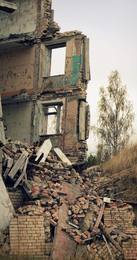


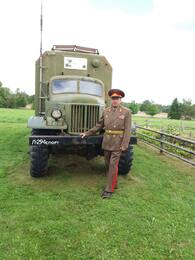
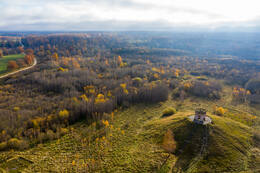
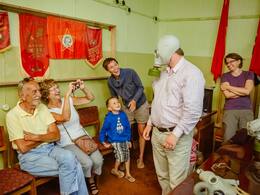
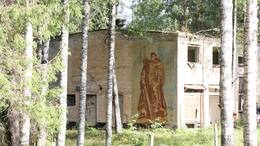

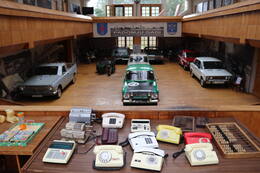
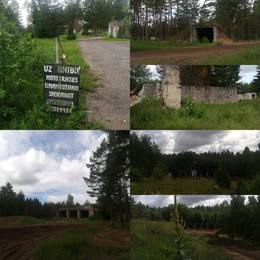

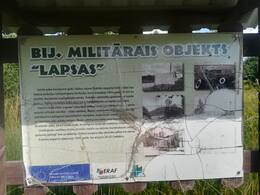
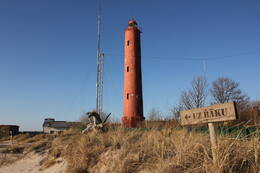
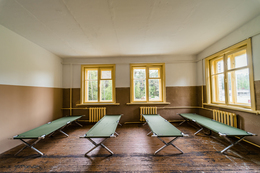

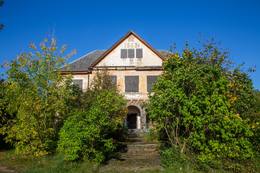
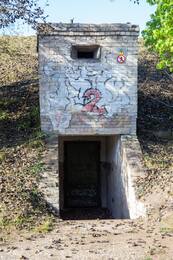
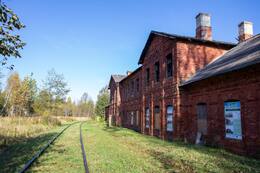
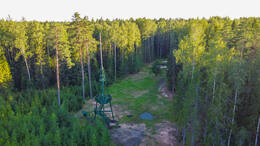

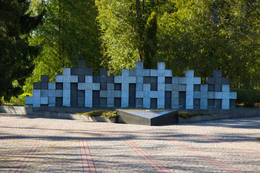

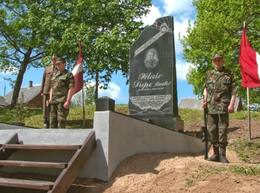
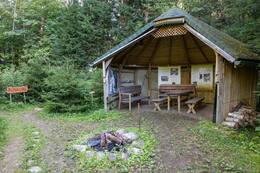
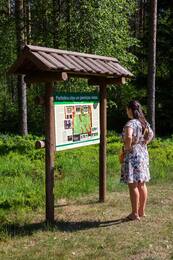
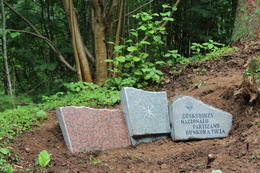
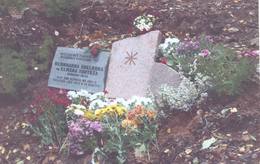
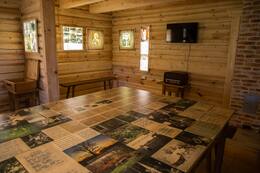
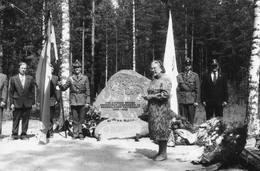
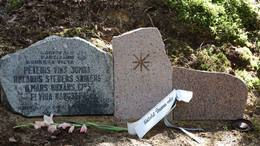
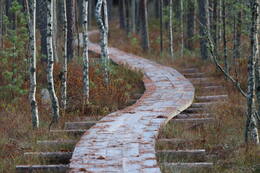
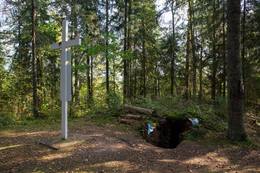
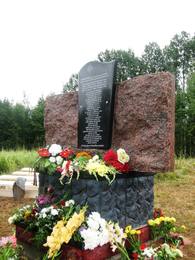

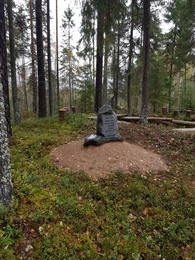
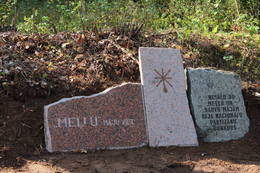
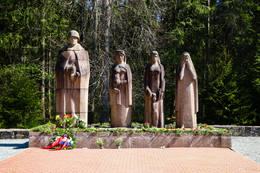
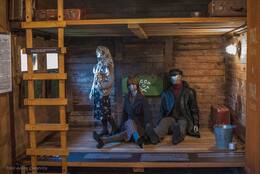

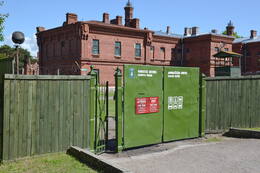
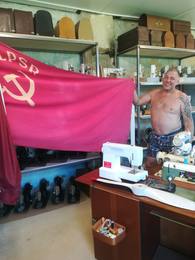
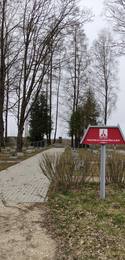
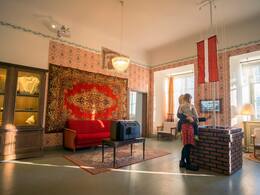
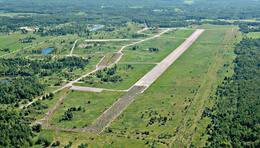
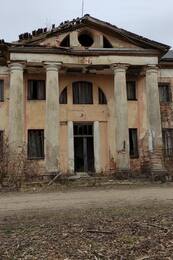
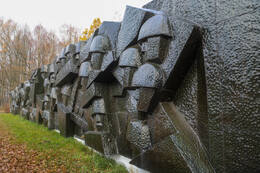
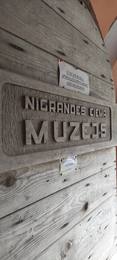
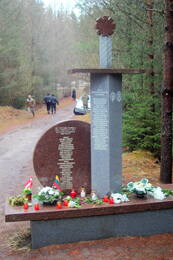
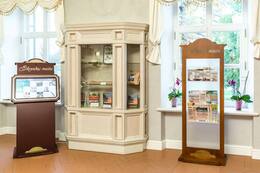
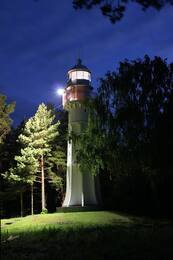
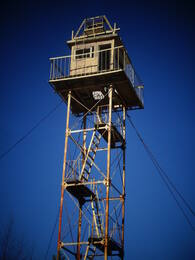
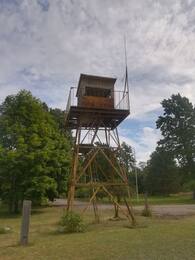
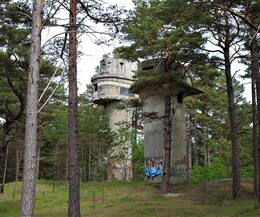
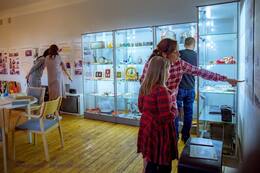
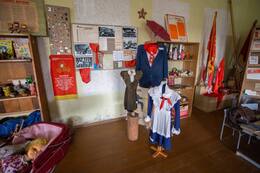
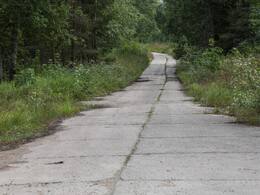
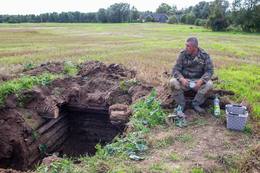
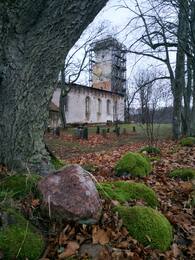



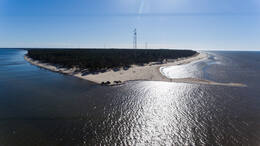
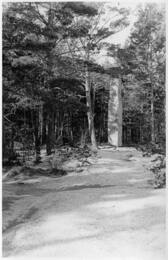
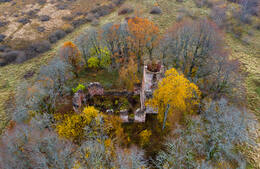
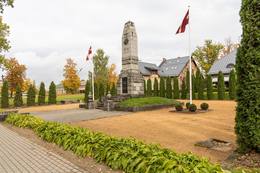
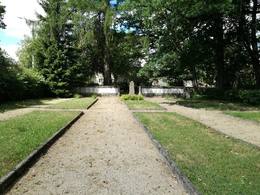

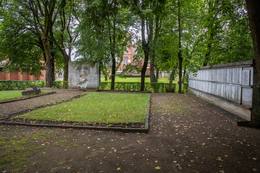
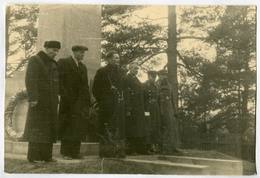
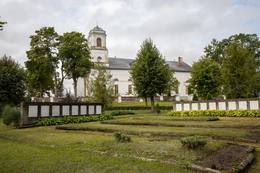
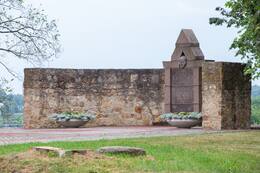

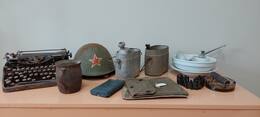
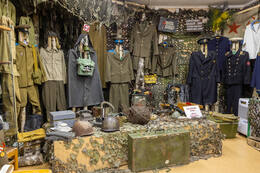

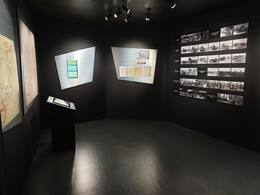
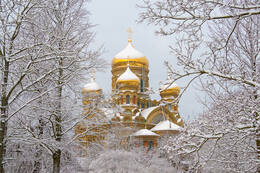
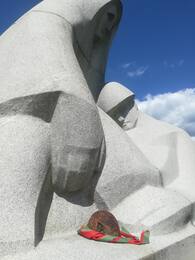
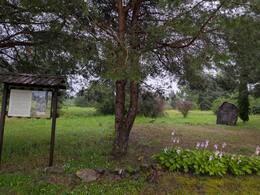
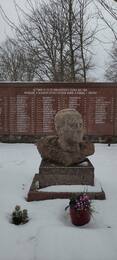



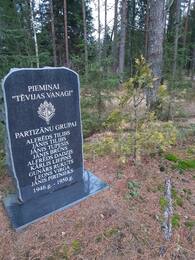
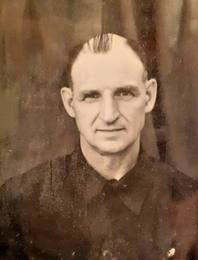

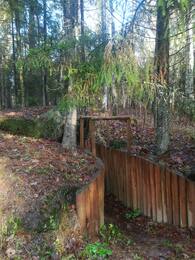
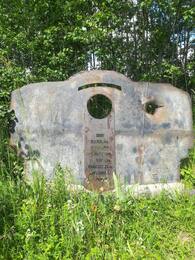
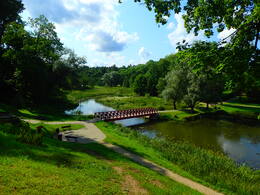
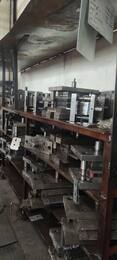
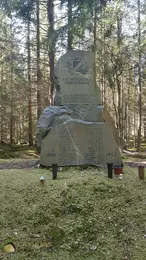
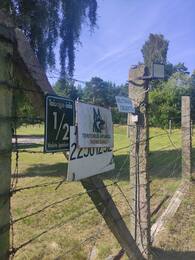
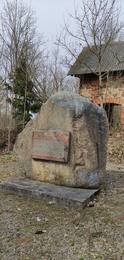

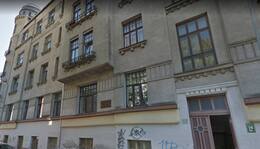

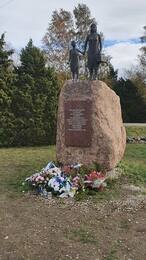
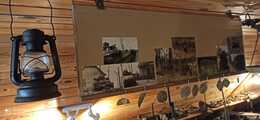
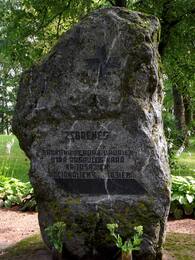
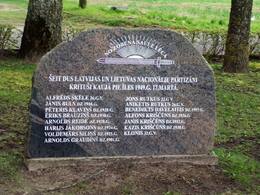
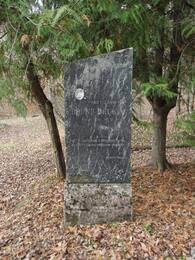
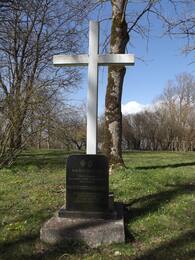

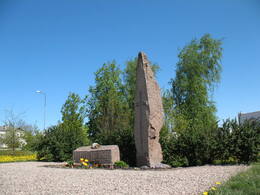

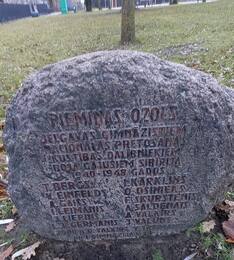
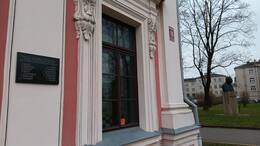
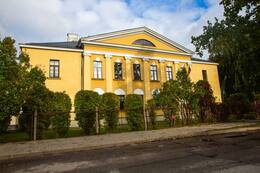
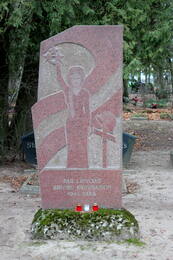
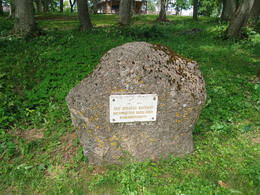
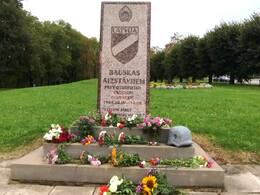
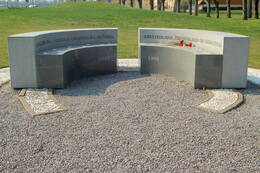
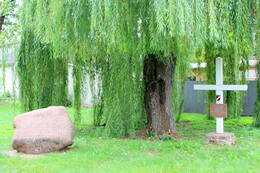
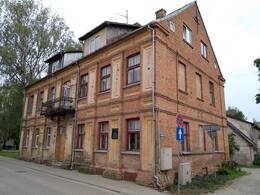
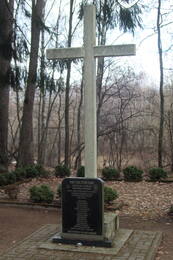
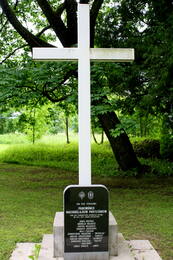
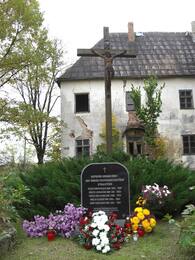
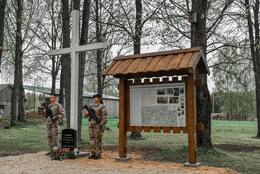
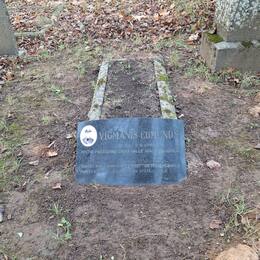
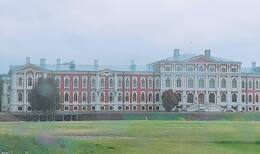
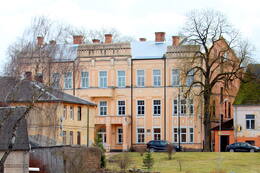
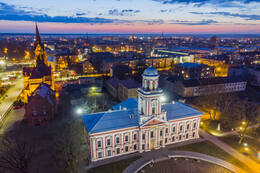
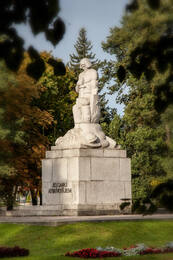
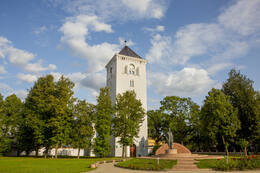
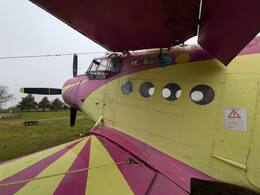
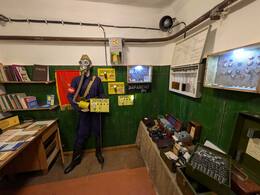

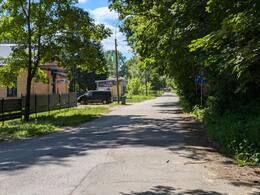
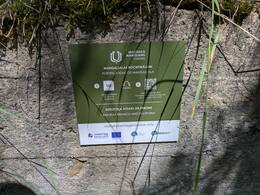
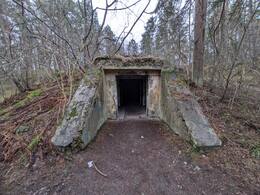
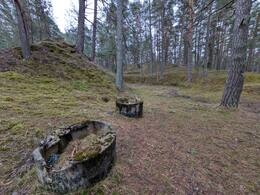
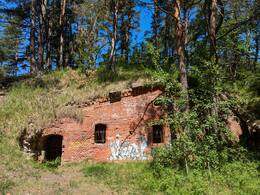
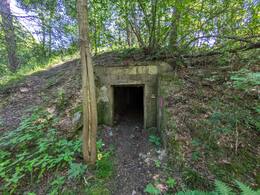
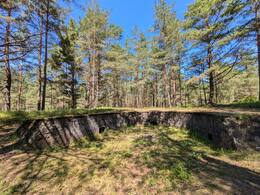
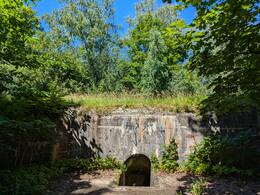
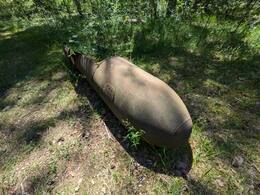
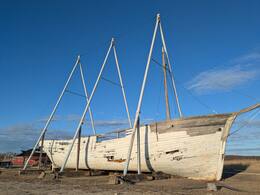
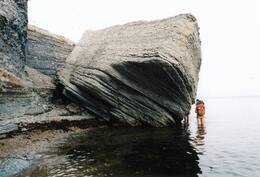
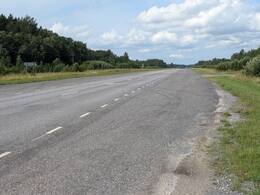
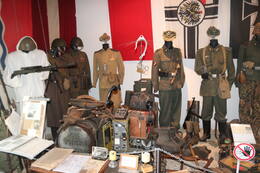

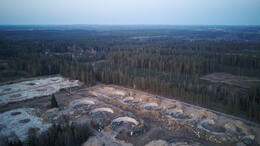
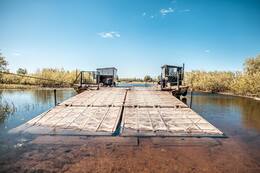

The Soviet occupation lasted until 1991. good afternoon. why in 1991, if the army left the landfill in 1993.